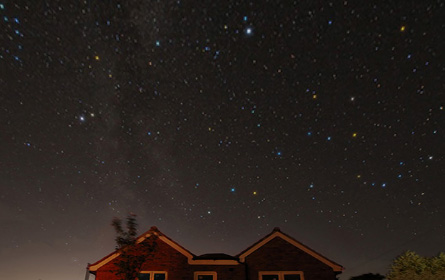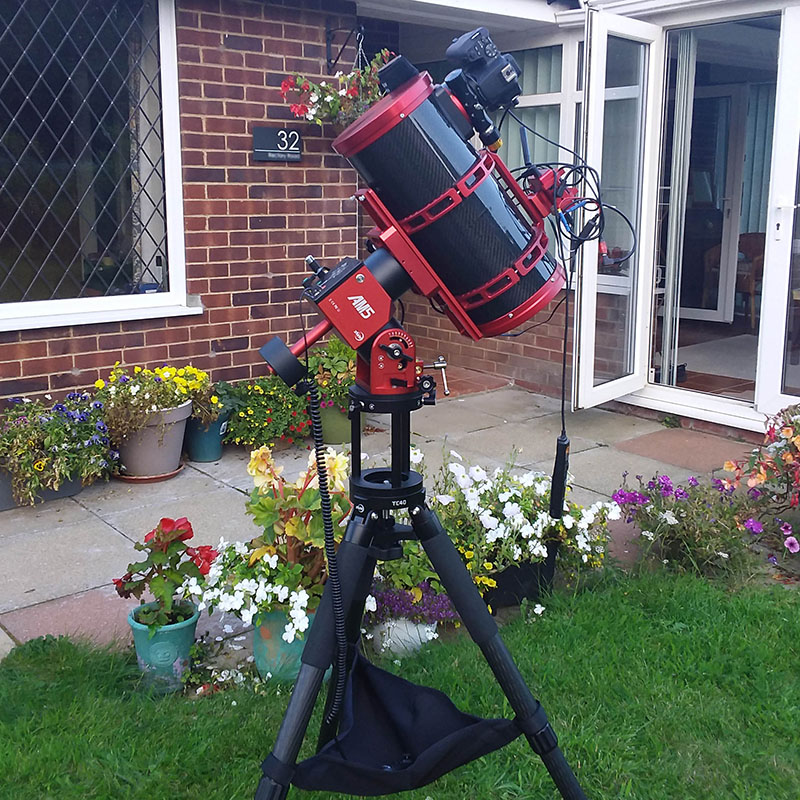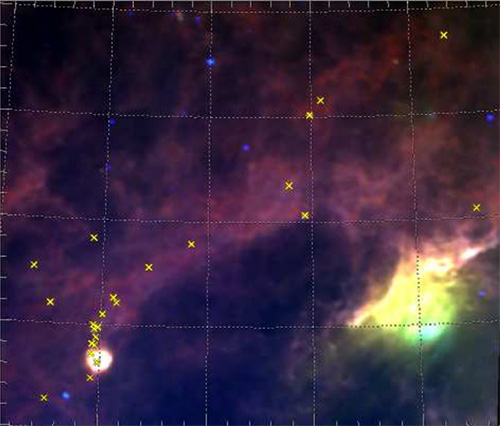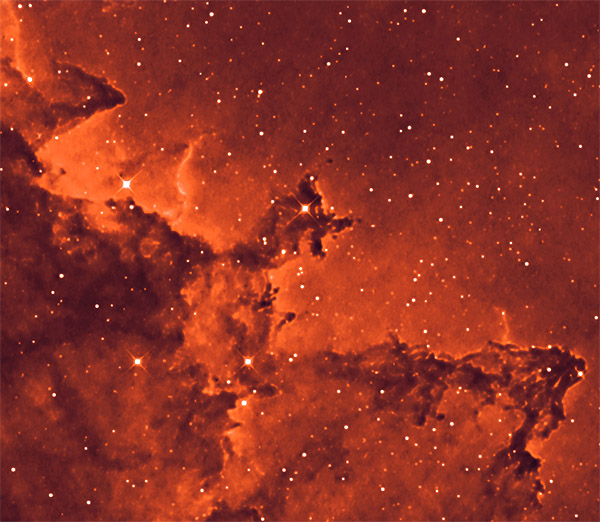|
INTRODUCTION |
UPDATE 2022 - SInce 7th January 2022 we are now located in Norfolk. I am now limited to simple imaging from my front garden using carry-out equipment I began using a tracker mount, initially a home-made one but then a Star Adventurer. The first camera was a modified Canon 250D with the fabulous the Samyang 135mm f/2 lens. However, I have now upgraded to a Sharpstar 130mm f2.8 Hyperbolic Newtonian and a ZWO 2600MC Duo camera on a ZWO AM5 mount. This is heavier to carry but with the duo camera at least there is no guide scope so saves a bit of weight. The built in guide camera on the 2600MC camera is a joy to use and guarantees good tracking in all but windy weather.
|
New home |
ImageBLOG Archives Archive 2022 |
19th December 2025The Double Cluster, NGC 869 & 884, (h and x Persei) |
Bit of an experiment. Virtually every image of the Double Cluster in Perseus features the stars against a black background. What would over 5 hours exposure show? Well it certainly is not a black background - anything but. Not really a surprise as they are located in the Perseus Arm of the Milky Way. Both young clusters around 14 million years old and at about 7500 lightyears away. They have a huge number of associated stars with a total mass of 20,000 times the Sun. Reference: Currie et al., "The Stellar Population of h and χ Persei, The Astrophysical Journal Supplement, 2010.
|
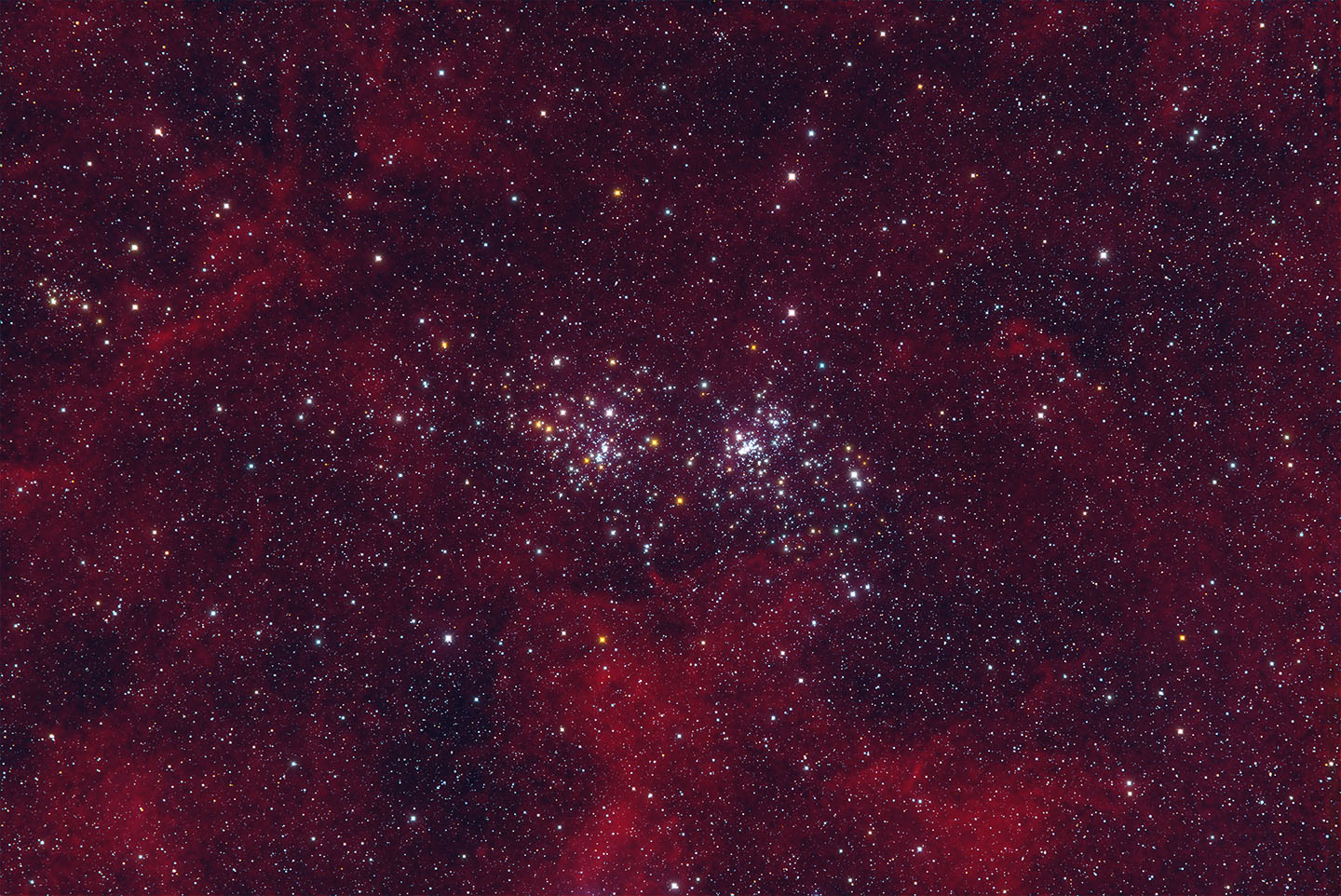 |
Double Cluster
|
27th November 2025The Helix Nebula, NGC7293 |
Very low here in Norfolk with less than 2 hours when it high enough for me to see. It therefore took 2 nights but with the weather not cooperating I had to wait 3 weeks for the second image. One of the closest planetary nebulae to us and one of the largest on the sky. It also huge in reality with the main nebula about 3 light years across and the faint outer reaches probably doubling this. When you compare this to the distance to the nearest star to us, ie around 4.25 light years, it really does bring it home how large it is. The central star is a white dwarf with a temperature of around 120 000 K and a mass 0.6 times the Sun.
|
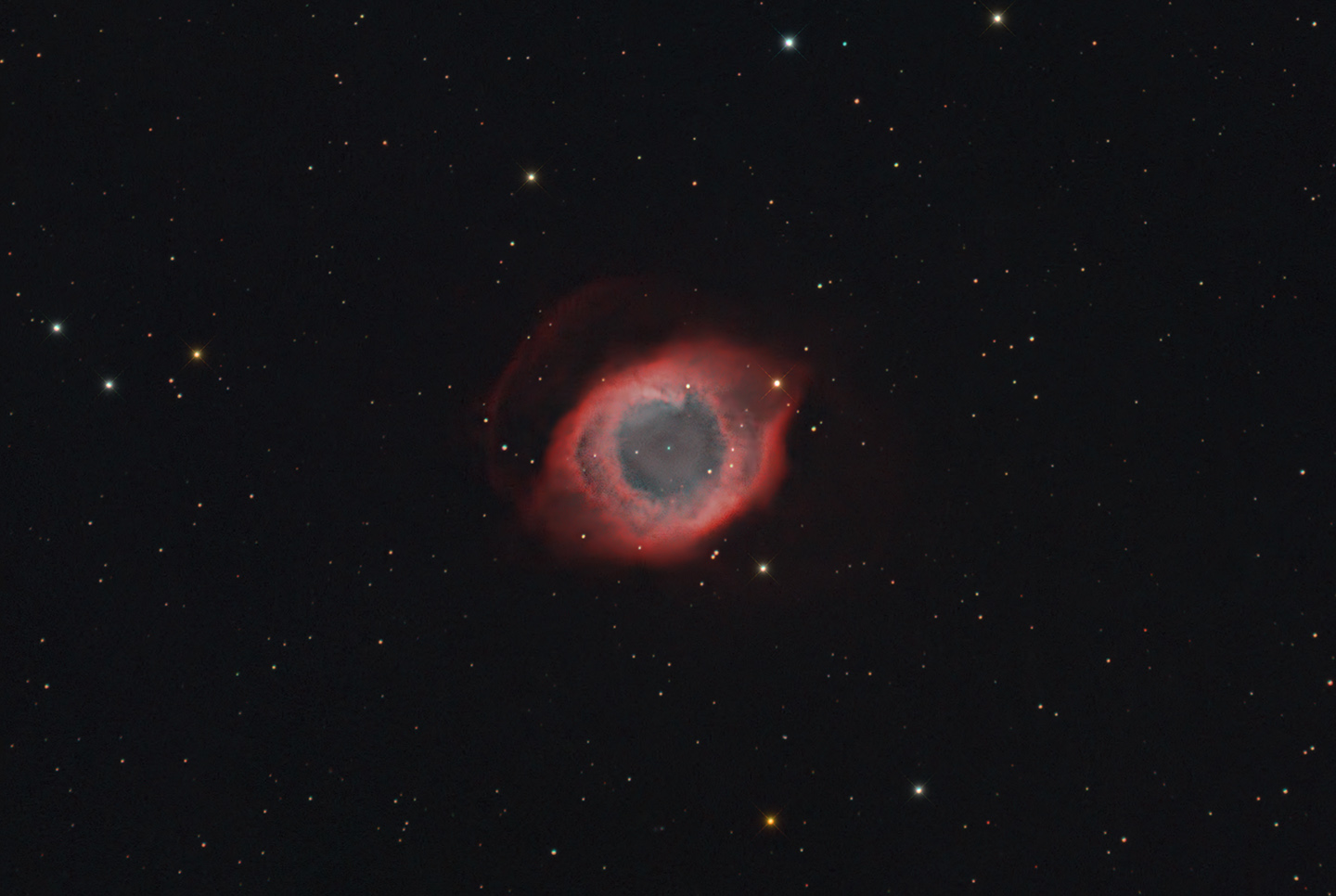 |
Helix Nebula
|
26th October 2025Elephant's Trunk Nebula, IC1396 - Siril's Pseudo Hubble Palette |
The new beta version of Siril now has a python script for creating a psuedo Hubble palette from standard dual band images. This is last year's image of the Elephant's Trunk Nebula and then just running the script with defaults and no adjustments. It basically seems to convert the red hydrogen coloured nebula into a yellowish hue.
|
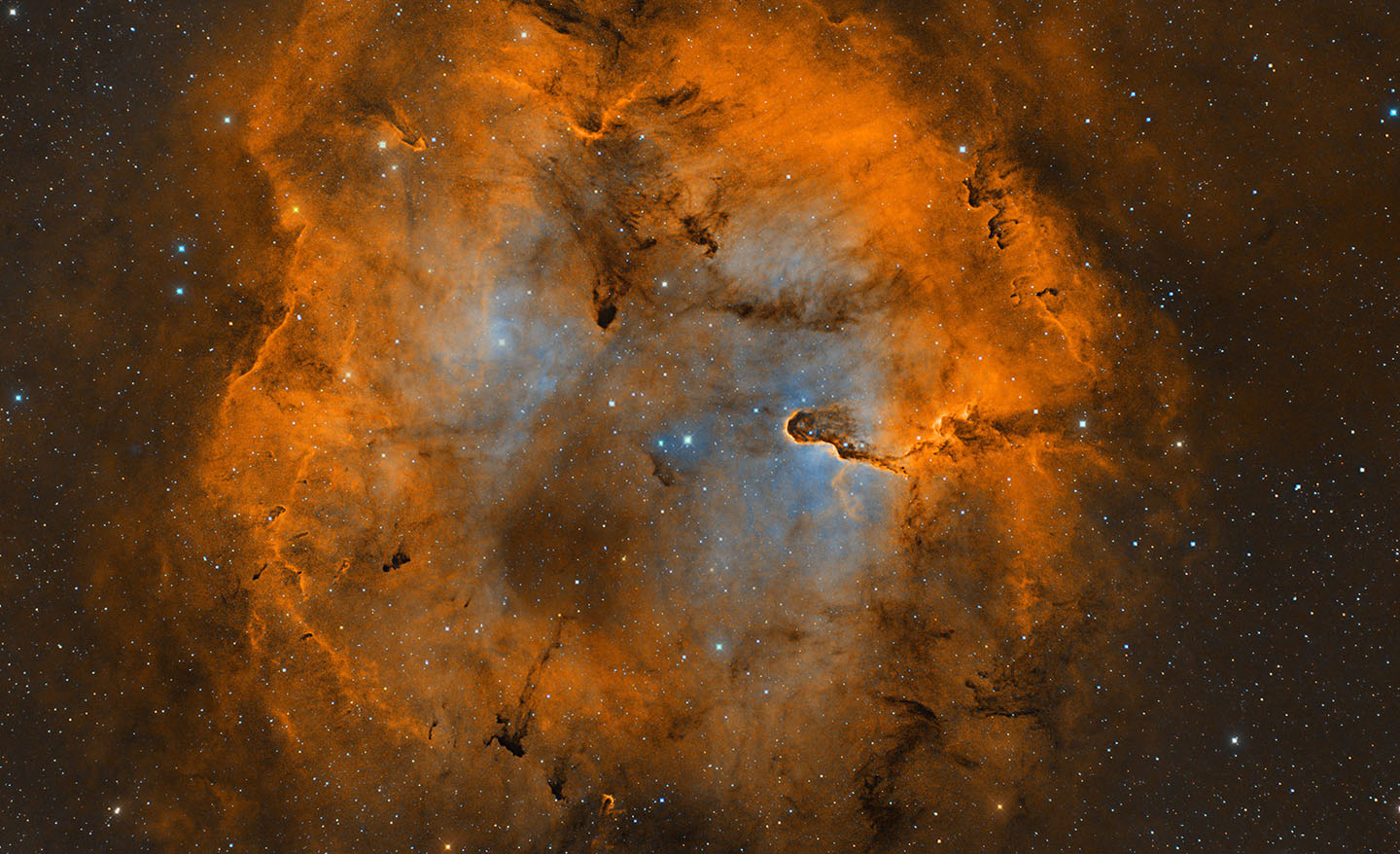 |
Elephant's Trunk Nebula
|
27th September 2025Emission Nebula Sh2-72, Planetary Nebula PK36-1.1 and Globular Cluster NGC6749 |
Restarting after the summer break and the usual problems getting everything to work again, wasting a lot of time. Sharpless Sh2-72 - emission nebula in Aquila with a rather poorly known distance ranging anywhere between 1500 and 4500 light years. Its appearance to me warrants the "Goblin Nebula" name with eyes, mouth, ear and pointed chin. Planetery Nebula PK36-1.1 (right) was also catalogued as Sharpless 71. It is around 3000 light years away and its very odd shape is likely down to its central star being part of a multiple system. Cluster NGC6749 (bottom left) is a much obscured globular cluster. It was confirmed as a globular cluster and classed as a Halo Cluster by Rosino et al, in 1996. It is currently only 25000 light years away as it is making a close pass to the the Milky Way disk. In composition its stars have very low metallicity similar to M30.
|
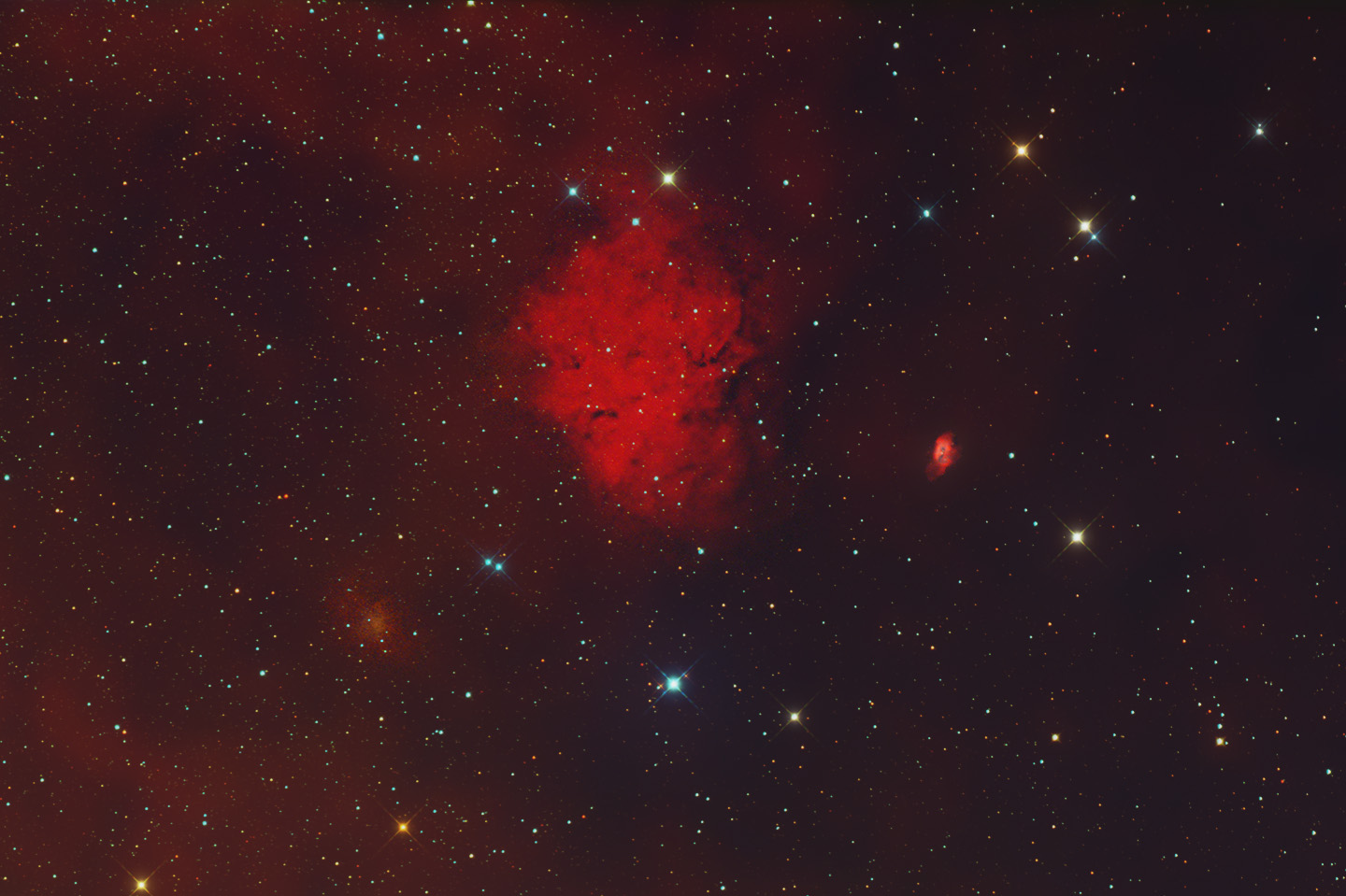 |
Sh2-72 The Goblin Nebula
|
24th July 2025Open Cluster M37 |
Why shoot M37 in narrowband? Well hidden within it is a nebula. The latter needs a much longer exposure than the stars so a narrowband image reveals the nebula without over exposing the stars too much. The nebula is classed as a planetery nebula. Not only that it is the oldest PN known at 78,000 years based on its expansion rate (reference Froghou et al., 2022). Messier 37 is the brightest cluster in the Auriga and was discovered by the Italian astronomer Giovanni Battista Hodierna before 1654. Charles Messier independently rediscovered M37 in September 1764. Estimates of its age range from 350 to 550 million years with 500 million probably a good estimate. It has approximaetely 150 stars brighter than magnitude 12.5. Distance is about 4500 light years.
|
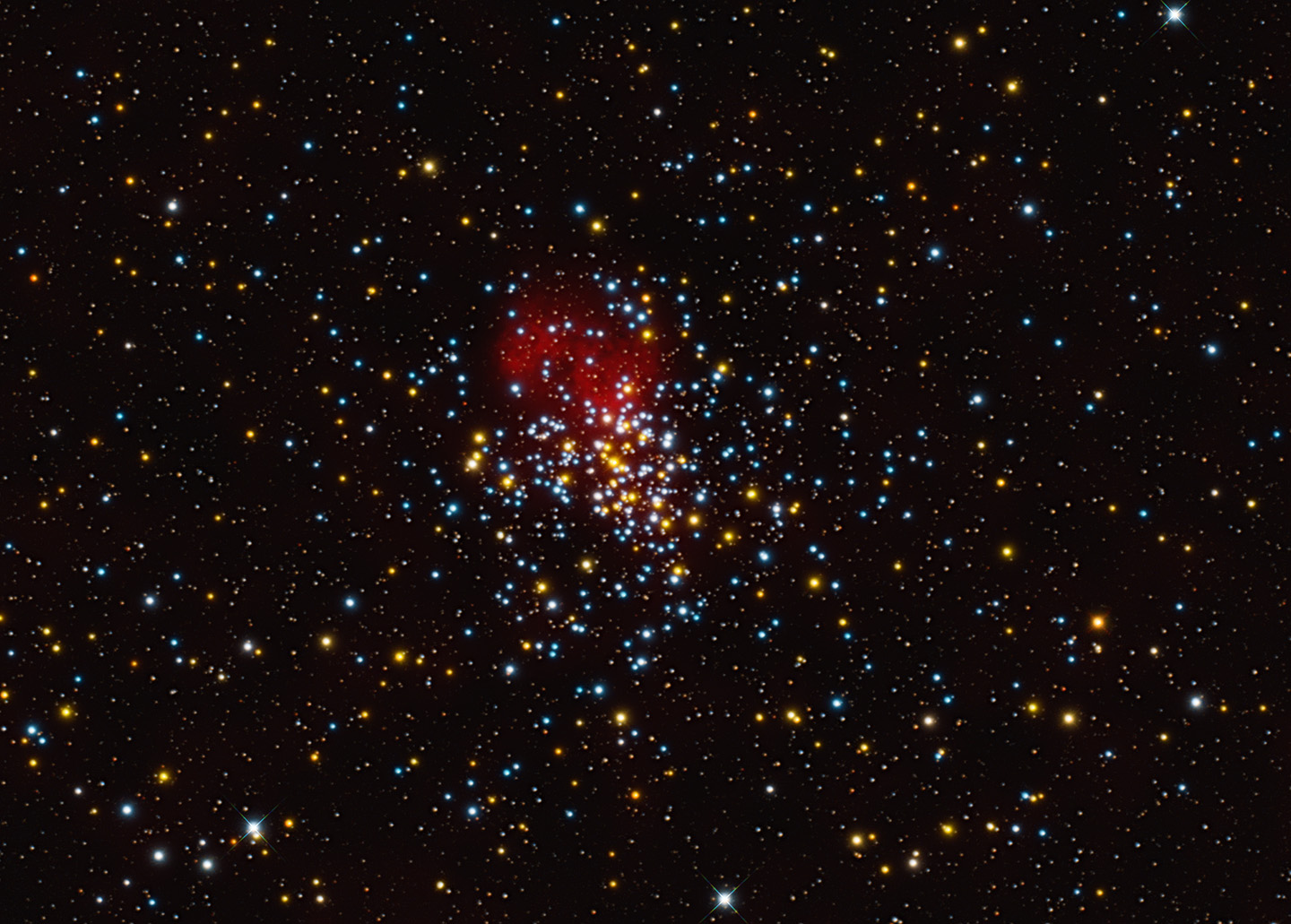 |
M37
|
1st July 2025Open Clusters M46 & M47 |
Two clusters within one degree of each other but in reality not close together in space. M46 is the much older and much further away. M46 as we have seen below is known for it having a planetary nebula, although this is just a line sight thing with the cluster very much in the background M47 was for many years a "missing" Messier object. Messier located his clusters by offsets from known stars. In the case of M47 he got his signs mixed up. At his recorded position is nothing but it was not until 1959 that the puzzzle was solved by Canadian Astronomer T.F. Morris. M47 being young cluster at around 78 million years old features several very bright blue giants but also has three prominent red giants. The older M46 is around 250 million years old. Also in the field of view are the cluster NGC 2423 (above M47) and NGC2425, the faint one between M46 and M47.
|
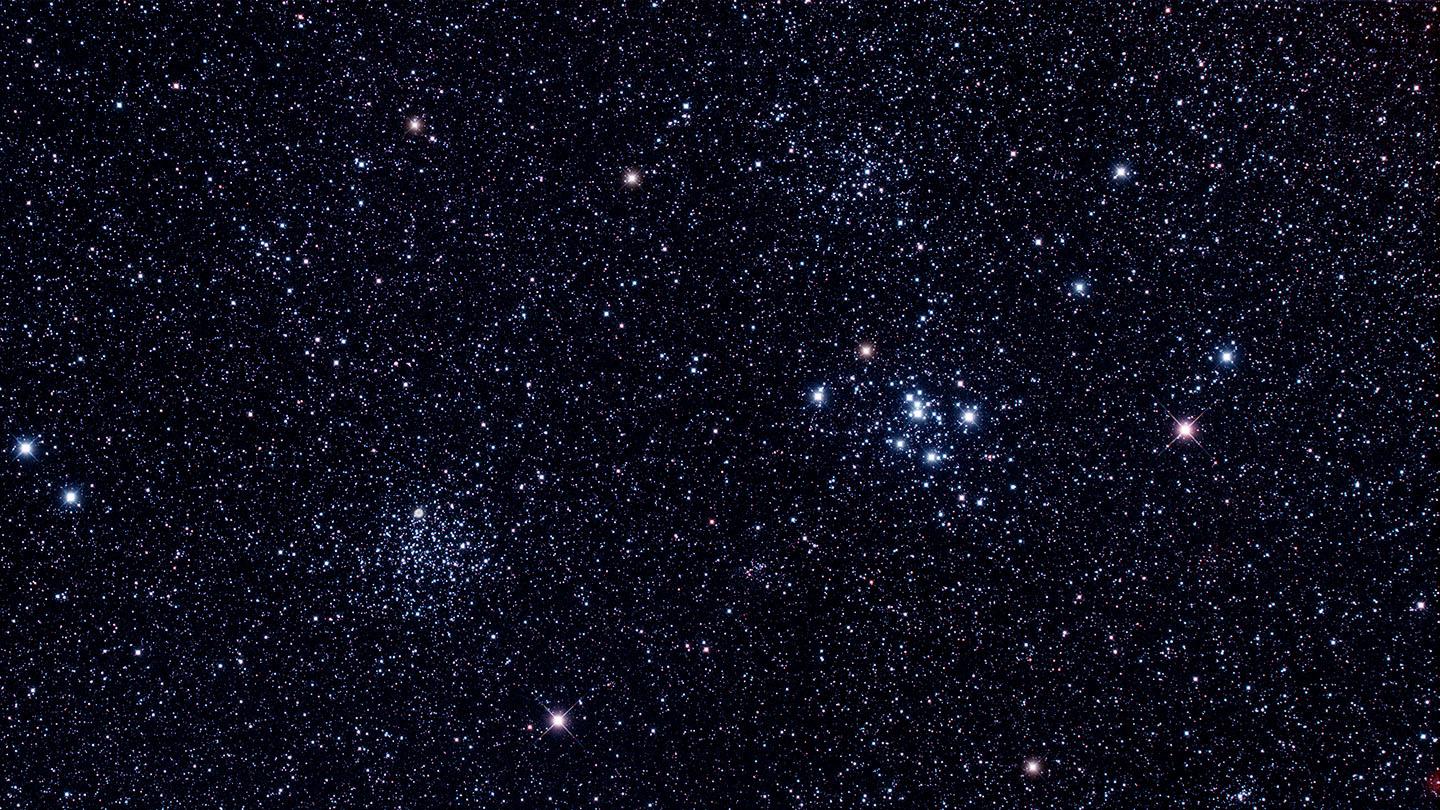 |
M46 & M47
|
22nd June 2025The Little Rosette Nebula, Sh2-284 |
Back on the red stuff! Not an object I had taken before but well worth a try. Close to the real Rosette Nebula this one has been given the name Little Rosette. It is the same idea with an HII region having a central cavity caused by intense radiation from the young star cluster at its centre (Dolidze 25). It also has some "Pillars of Creation" type features. The prominent cluster to the east (left) is NGC 2301. Quite an odd shape with a "plough" type handle.
|
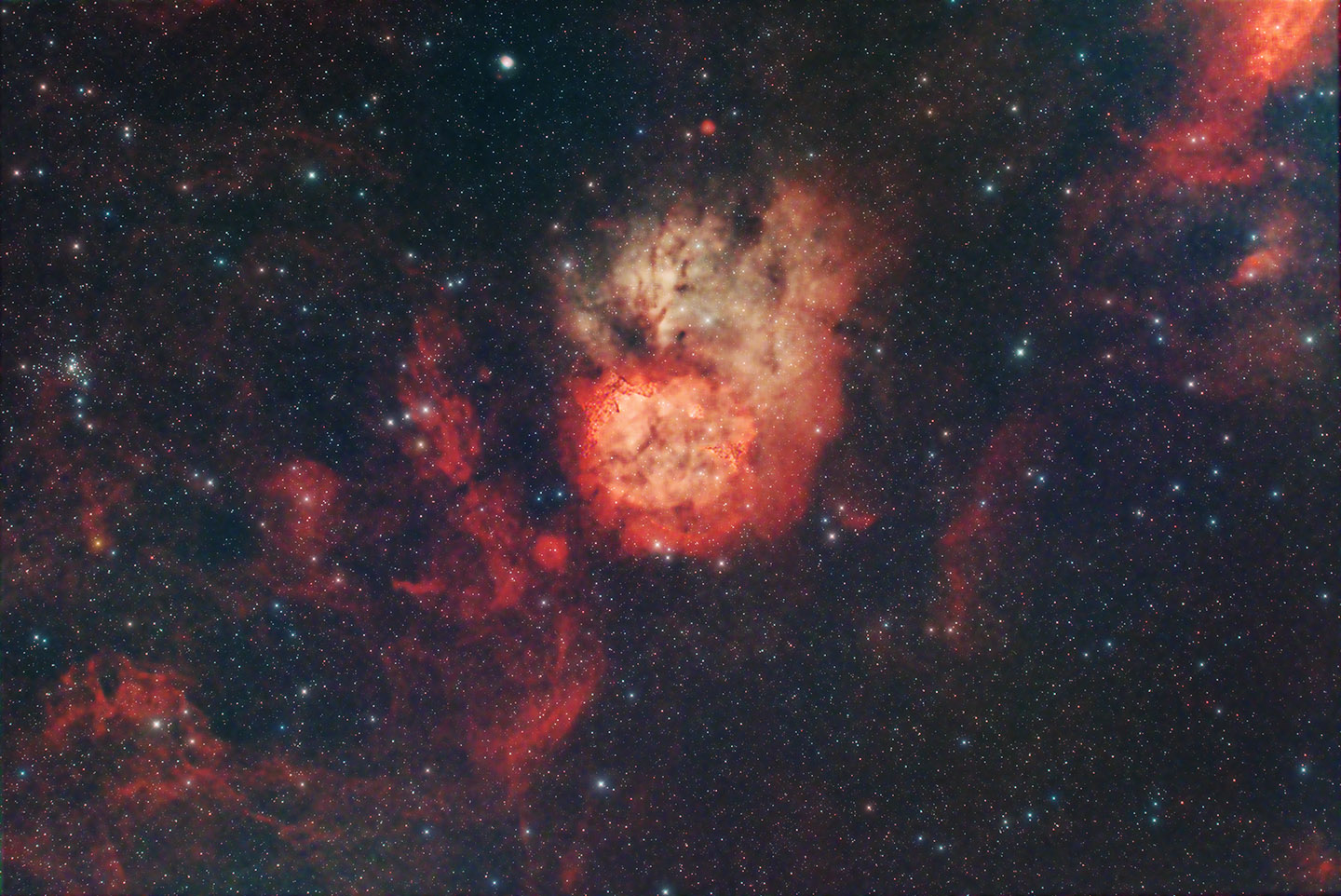 |
Sh2-284
|
11th June 2025Open Cluster M46 & Planetary Nebula NGC2438 |
I felt I needed a break from big red nebula so decided upon M46/M47. This image is just part of the field of view centred on M46 and the planetary nebula NGC2438. Quite a low image for me shooting over the top of Norwich. Messier 46 (NGC 2437) is an open cluster of stars in the southern constellation of Puppis. It was discovered by Charles Messier in 1771. Its attraction is in having a planetary nebula within its field of view. The cluster is a big one by open cluster standards with around 500 stars. Planetary Nebula NGC2438 is not part of the cluster - just a chance line of sight. It used to thought it was behind the cluster but thanks to Gaia we now know it is in front. It is around 1500 light years away whereas the cluster is around 5000 light years distant.
|
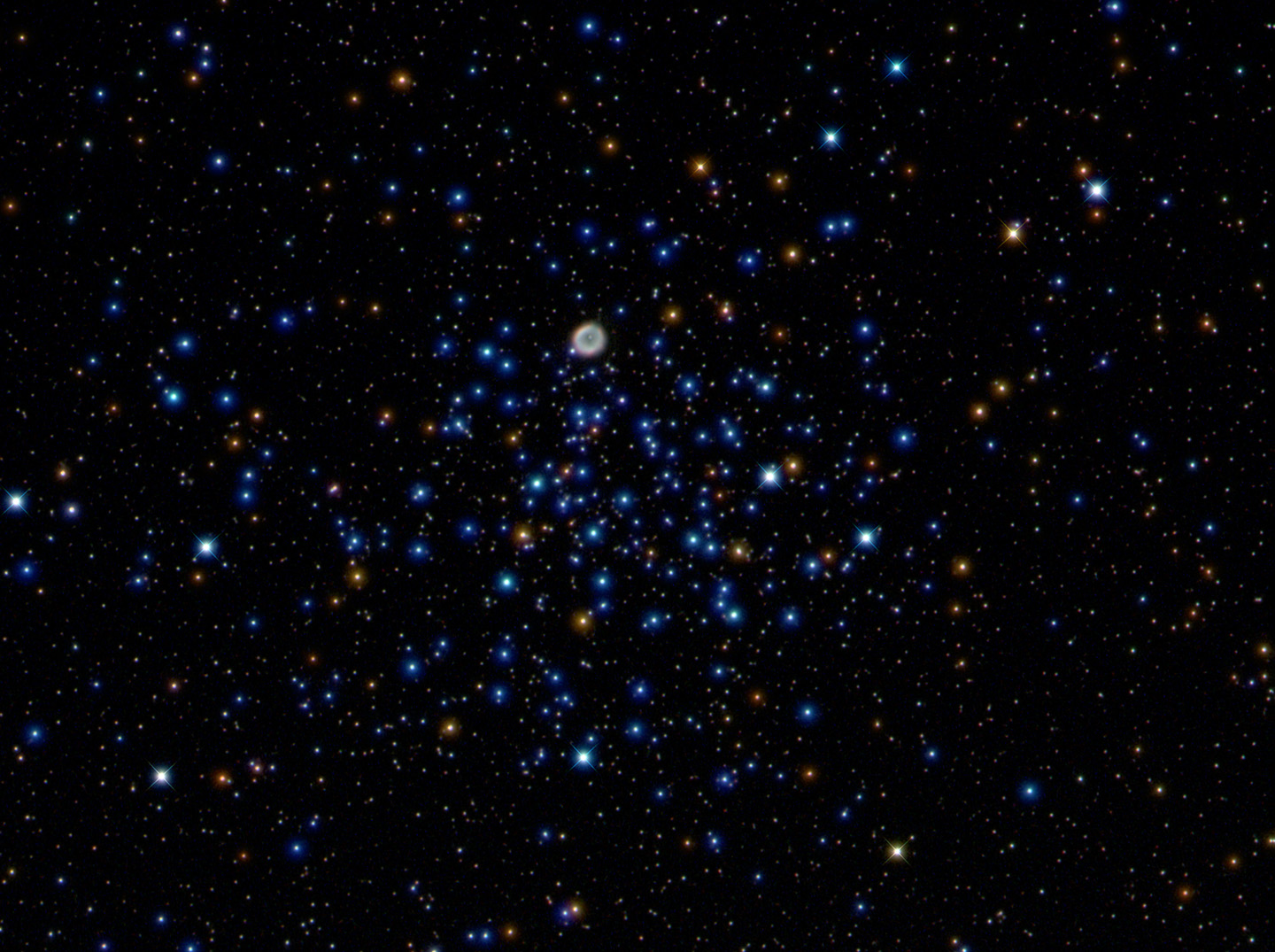 |
M46
|
4th May 2025Lower's Nebula, Sharpless Sh2-261 |
A nebula discovered by amateur telescope makers! It is named after Harold Lower and his son Charles who discovered it photographically in 1939 using a home-made Schmidt camera. Located in northern Orion it is somewhat overlooked with so many other brighter nebula around. Obviously an HII emission nebula energised by the very hot massive star, HD 41997, at its centre. This star is also described as a runaway star. Images of this object often show it against a black sky. In reality it is totally surrounded by much fainter nebulae.
|
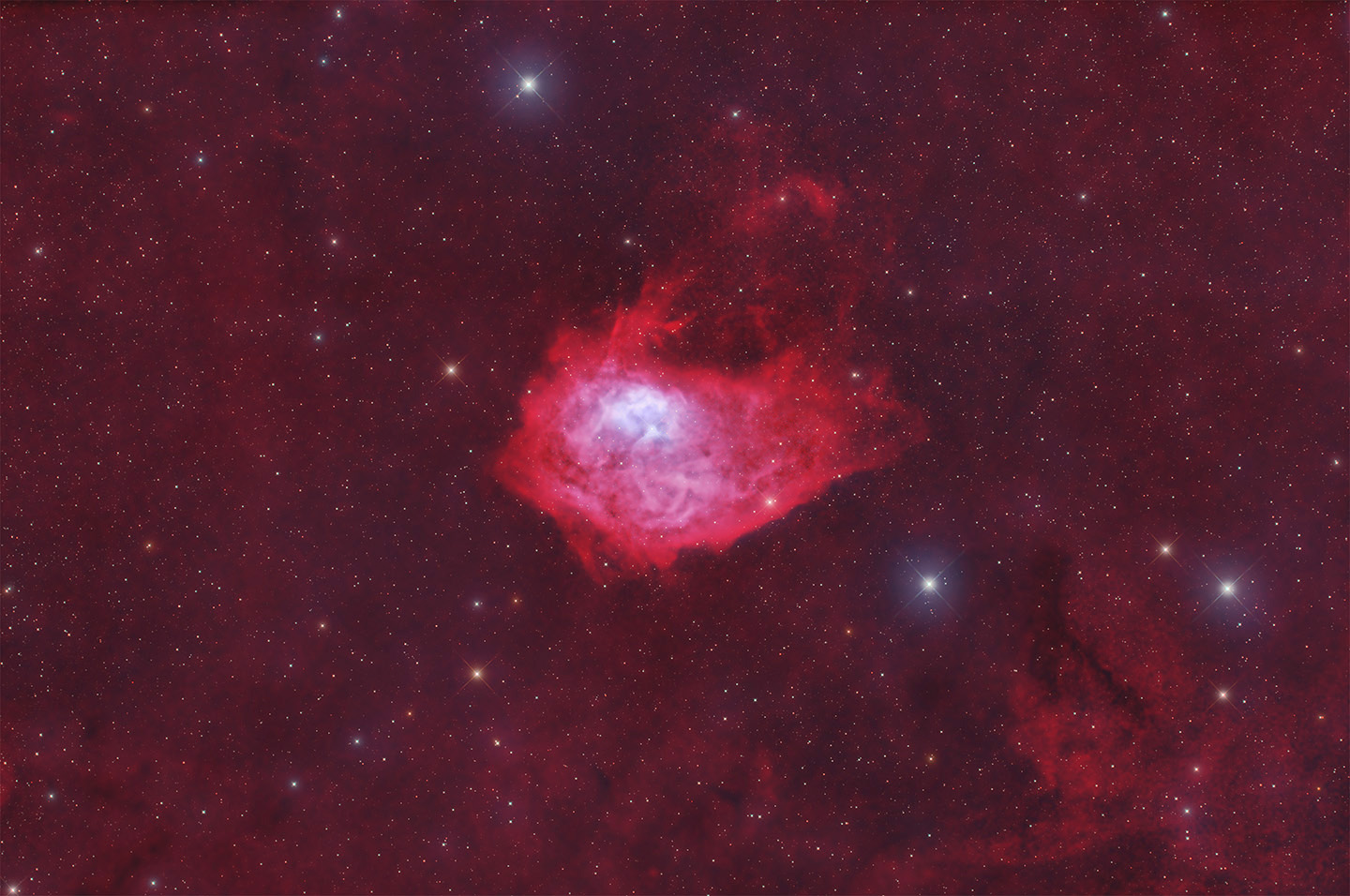 |
Lowers Nebula
|
12th April 2025Sharpless Sh2-268 and NGC 2194 |
I centred this image to the left (east) of Sh2-268 as a test run showed there was another nebula there. Not sure what this nebula is called as it not a Sharpless object. The unknown nebula has a filamentary feature which is usually a sign there is a supernova remnant nearby. So a bit of a puzzle. The open cluster below the centre is NGC2194. Overlaying Sh2-268 is the "IC37" asterism more correctly known as NGC2169 - see right. I also ran on 14th and 16th February as well but haze meant those images had to be rejected. However, I still managed to get 6 hours of exposure - needed as these are faint objects.
|
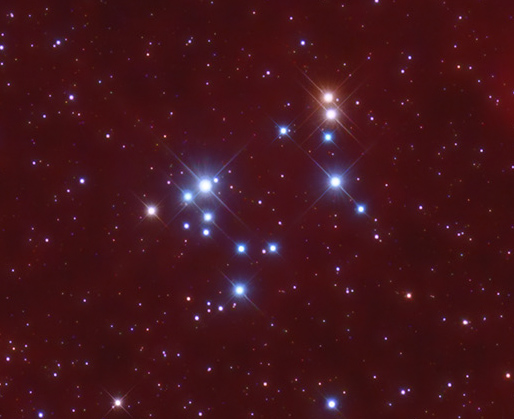 |
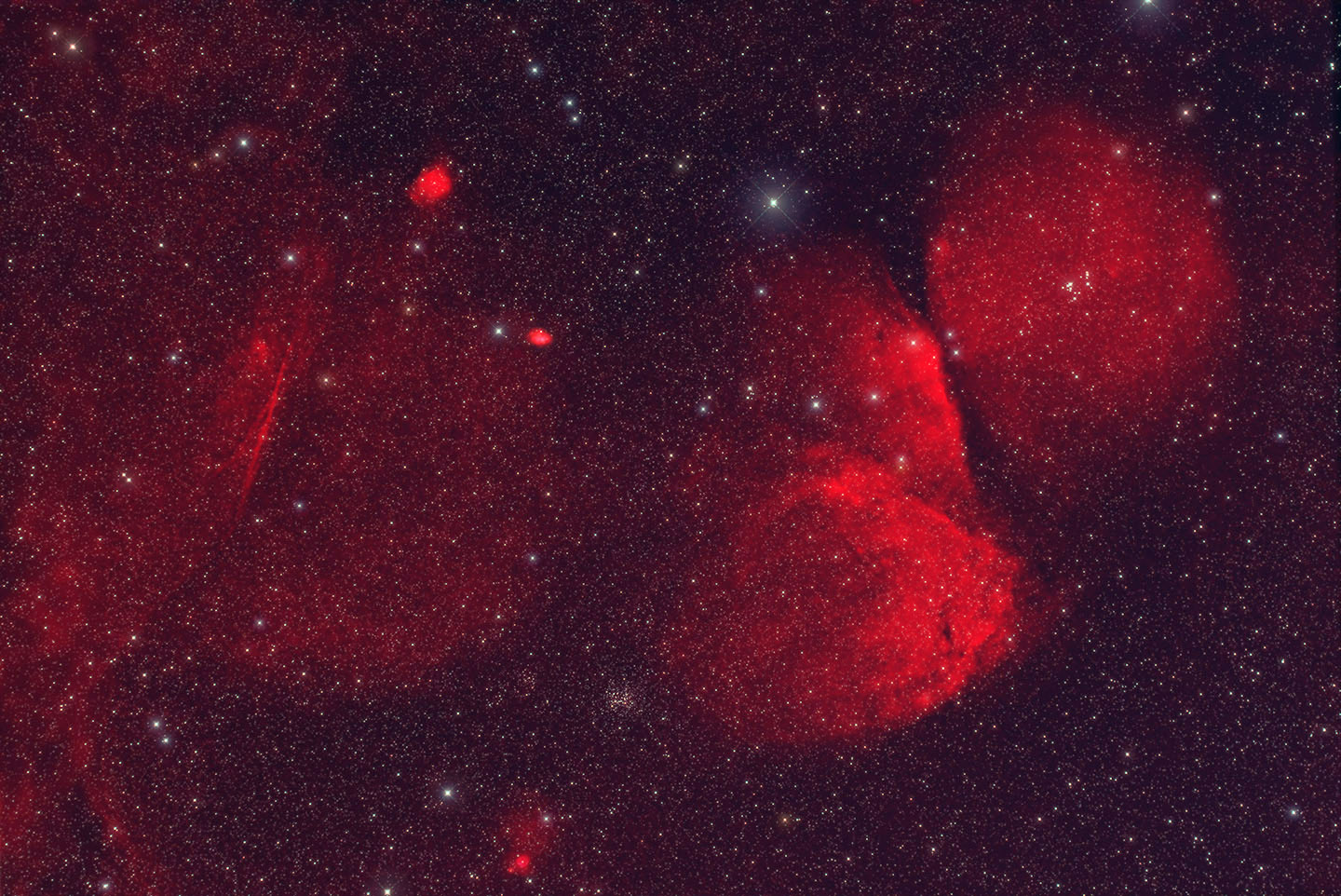 |
Sharpless Sh2-268
|
3rd April 2025Barred Spiral Galaxy M108 |
From our viewing angle not an obvious barred spiral. It is an outer member of the Ursa Major Galaxy Group. It never used to have a popular name but now seems to have been labelled the Surfboard Galaxy. I took this galaxy way back in 2009 from Lancashire using a mono camera on my RCOS Ritchey Chretien. Sixteen years later I thought it was time to collect some colour data and here is the combined result.
|
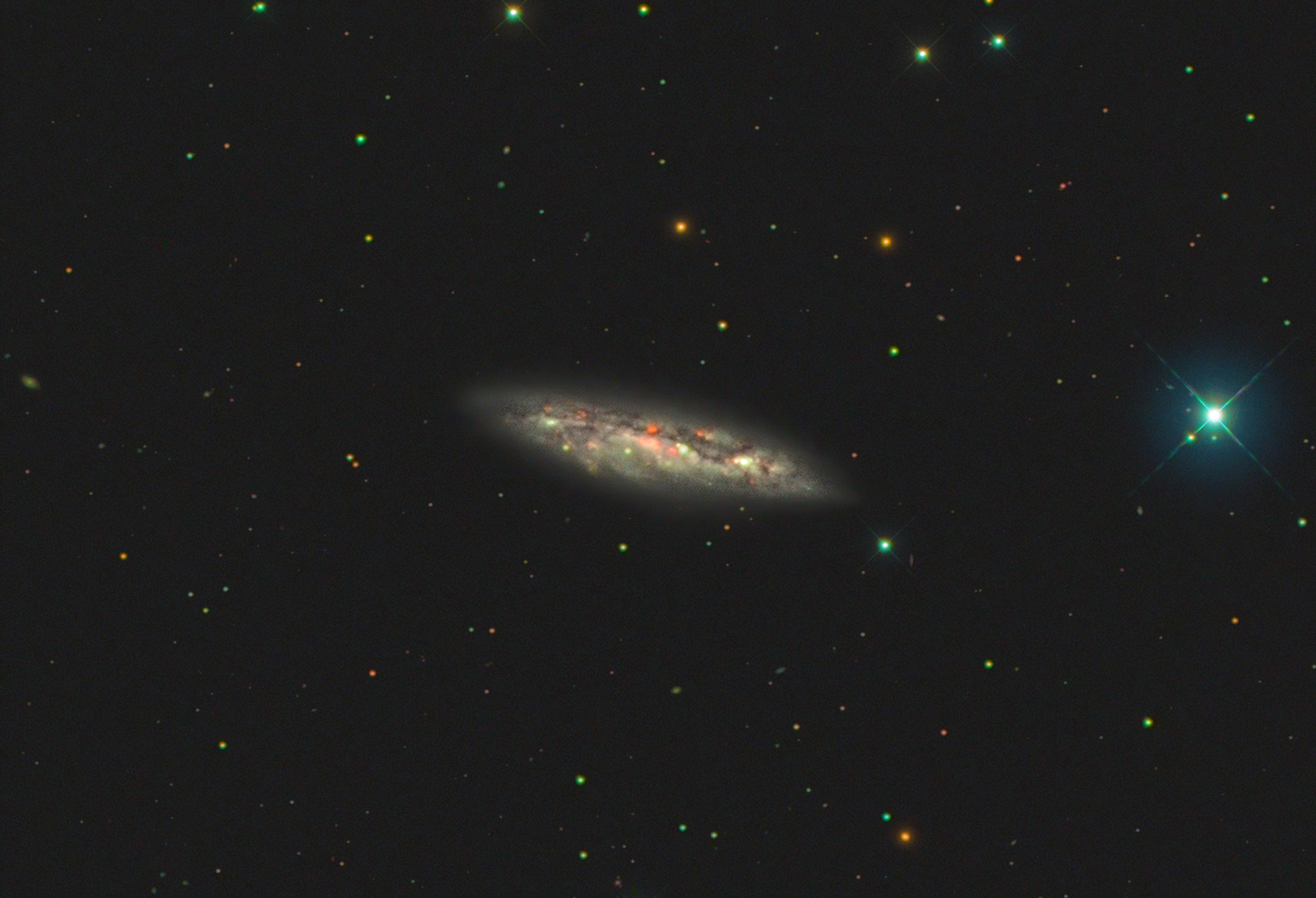 |
M108
|
30th March 2025Partial Ecipse of the Sun, 29th March 2025 |
Frequent clouds made it tricky but there were plenty of gaps to see the partial eclipse from my front garden in Norfolk. Family and neighbours enjoyed the view. There was one prominent Sun-spot visible plus a much fainter little group.
|
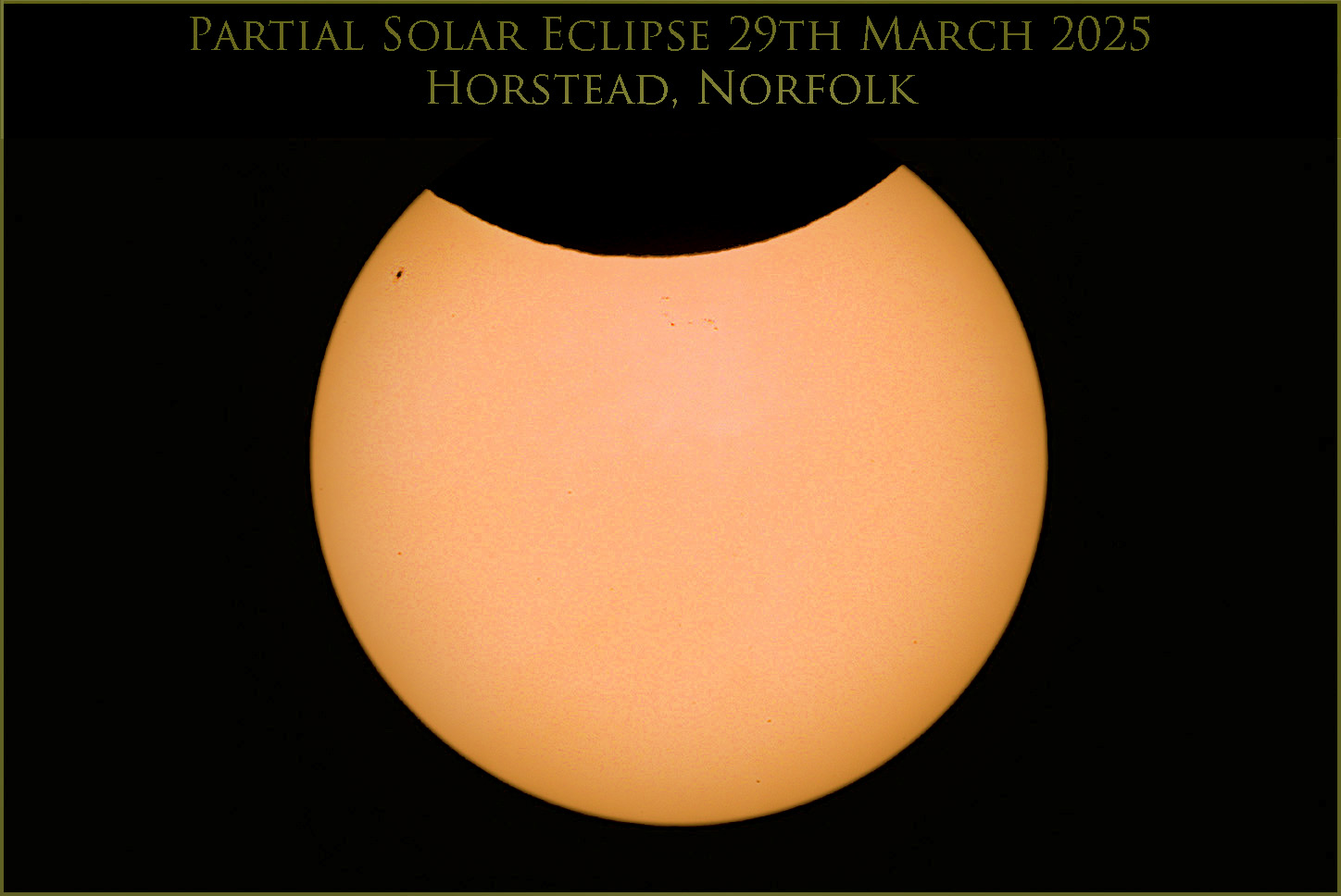 |
Partial Eclipse
|
4th March 2025The Pacman Nebula, NGC281, SH2-184 |
December was a wash-out here in Norfolk and January was only slightly better. It did though take 3 nights to get the information for this nebula. Relatively bright and easy to find emission nebula just below the "W" of Cassiopeia. Discovered by Barnard in 1883. As the image shows the Pacman is just the brightest part of huge HII region.
|
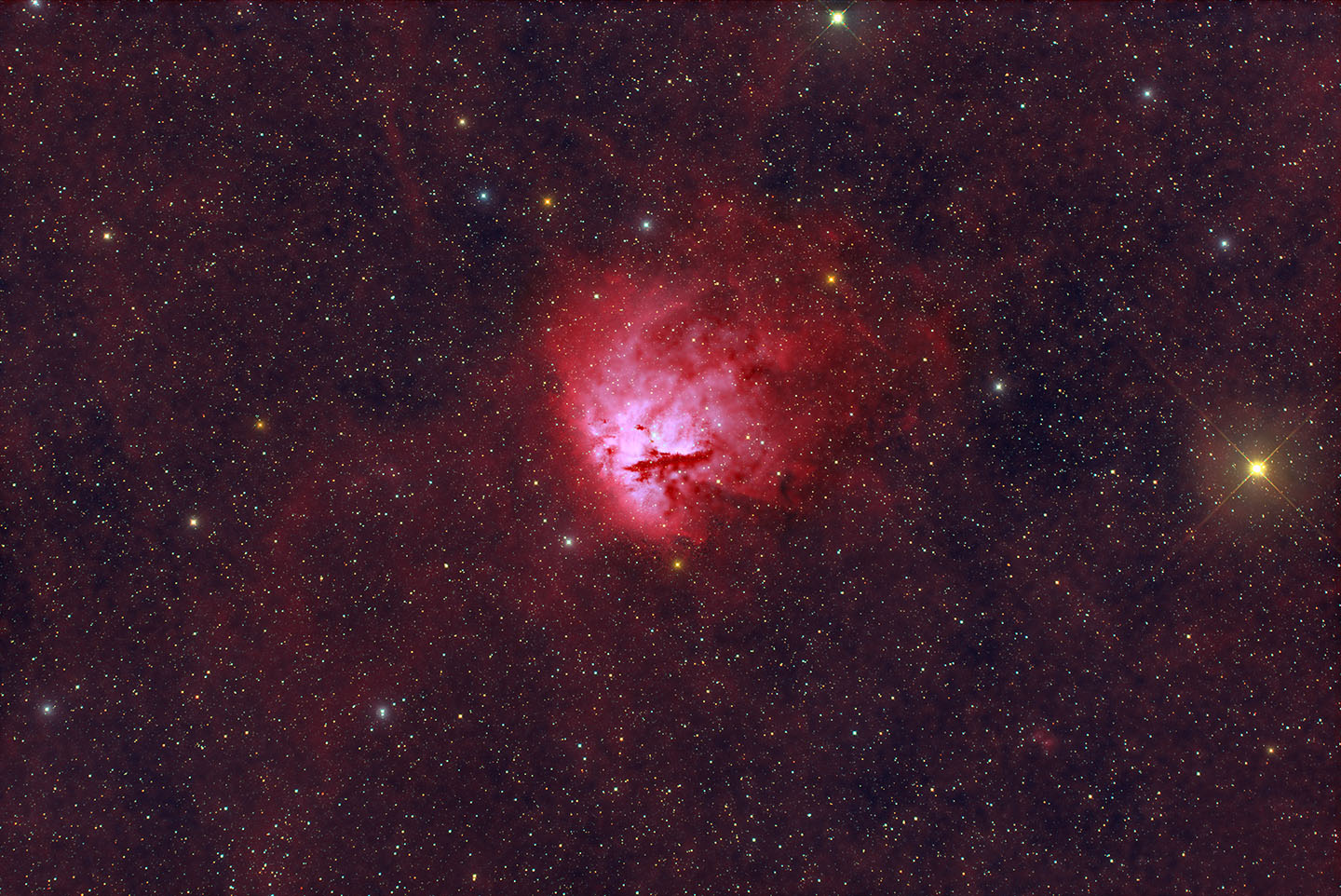 |
The Pacman Nebula
|
4th March 2025The Cave Nebula, Sh2-155, Caldwell 9 |
On a run with another clear night - it didn't last though as it turned out to be a gloomy winter. The name "Cave Nebula" was originally used for another nebula but was re-used by Patrick Moore for this nebula, which he included as number 9 in his Caldwell Catalogue. He presumably used the name based on not very deep photographs that showed this nebula as a dark patch with surrounding bright emission nebula. As we can now see the Cave Nebula is anything but dark - hardly a cave at all. However, the name has stuck to this nebula.
|
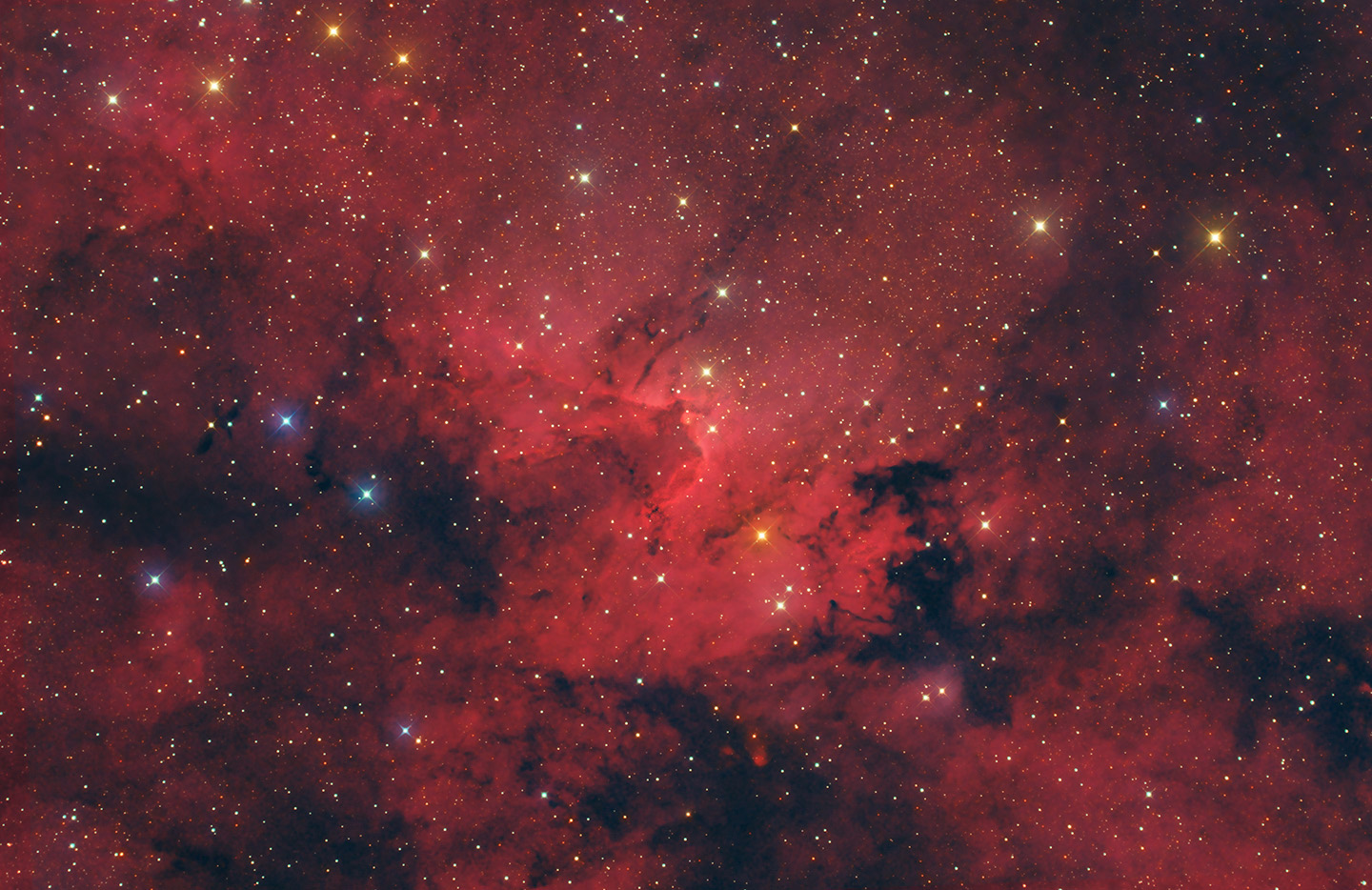 |
The Cave Nebula
|
20th February 2025Sh2-145, Sh2-150 & VdB154 |
Again multiple objects with 2 red Sharpless nebulae and a blue Van den Bergh one. The main nebula below centre is the emission nebula Sh2-145. It has that intruiging dark patch with a semi-circular bright edge. The more filamentary nebula above centre and left is Sh2-150. Above that is te blue reflection nebula VdB154. On the bottom edge, right of centre is a little bit of Sharpless 140. Always reminds me of a Womble of Wimbledon Common (Children's TV in the UK) - Uncle Bulgaria? Womble Nebula anyone? Needed two nights as the mist kept rolling in. The snag of being near a river.
|
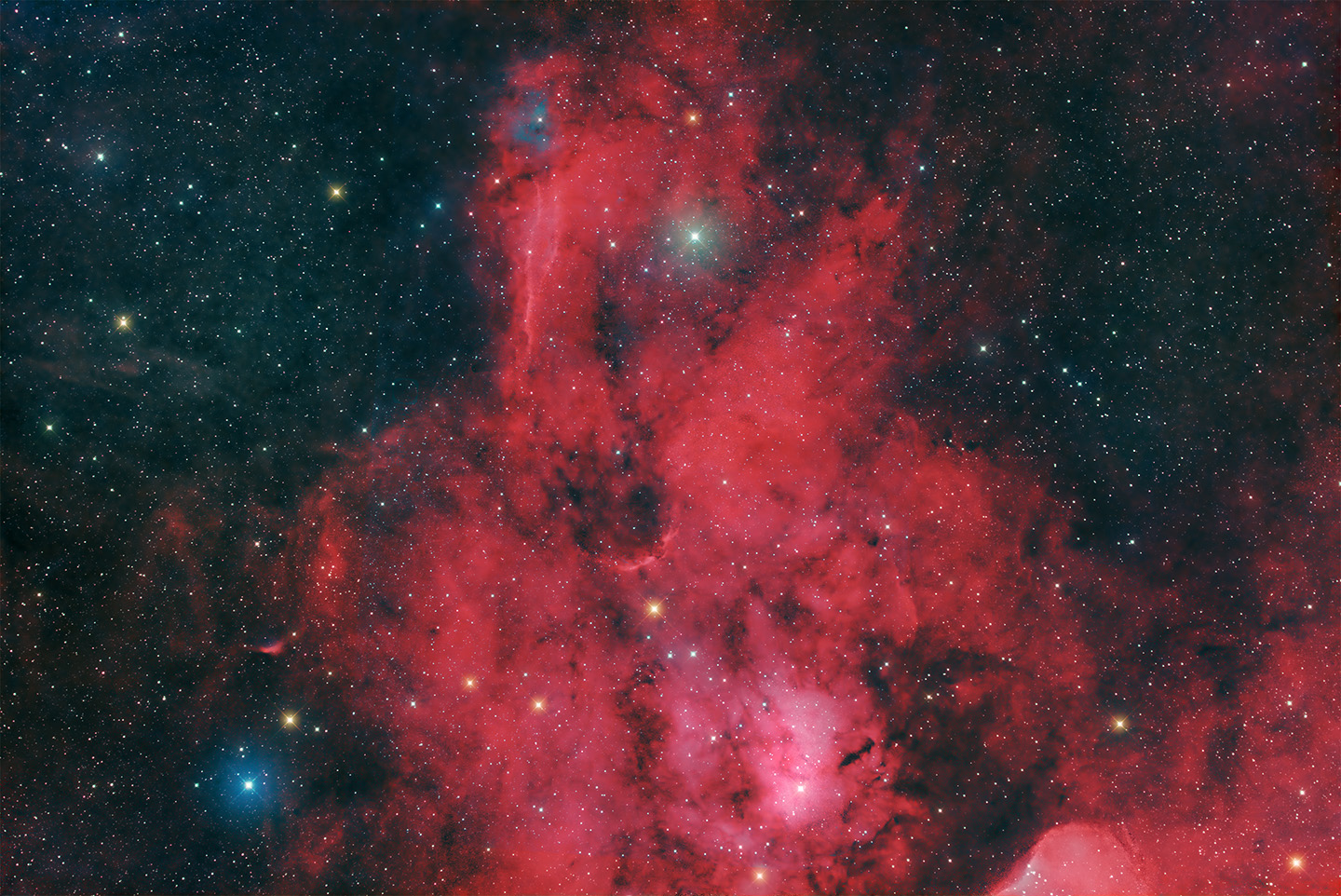 |
Sh2-145, Sh2-150 & VdB154
|
7th February 2025The Lobster Claw (Sh2-157) and the Bubble Nebula (NGC7635) |
Several objects for the price of one. The biggest one just below centre is Sharpless Sh2-157 commonly called the Lobster Claw. Above center is the Bubble Nebula, quite small at this focal length. Also in the image is the open cluster M52 upper left. Had to pack in early on this one as the wind got up. That is a snag with a lighweight set-up. Easy to carry out but vulnerable to wind buffeting. Image right was taken with my RCOS back in Lancashire. The 2800mm focal length does the Bubble justice.
|
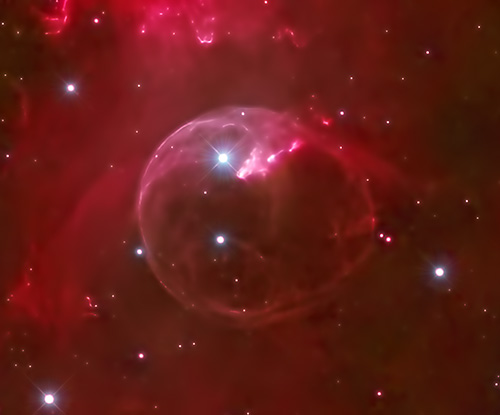 |
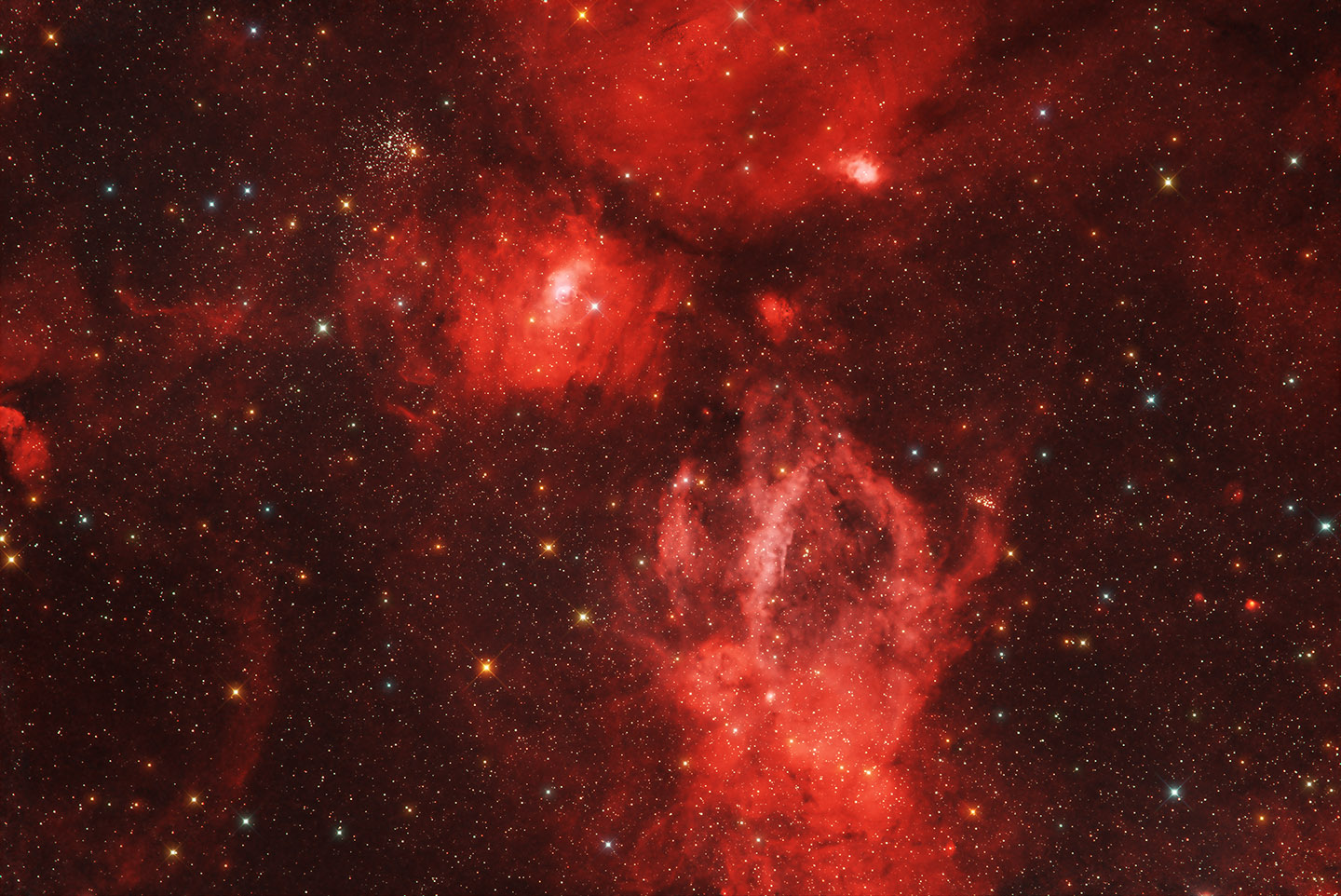 |
Lobster Claw and the Bubble Nebulae
|
17th January 2025The Wizard Nebula and Open Cluster NGC 7380 |
The Open Cluster NGC 7380 is just about swamped in this image by the emission nebula known as the Wizard Nebula (centre). The open cluster, located in Cepheus, was discovered by Caroline Herschel in 1787. The surrounding emission nebulosity is actually more correctly catalogued at Sharpless Sh2-142. Visually it is very very faint so no wonder Caroline only referred to the cluster. The two are assosciated and the nebula is energised by the cluster star DH Cephei, a close, double-lined spectroscopic binary system consisting of two massive O-type stars (wiki). Also in my image are several other Sharpless objects. The brightish one towards the right (west) edge is Sh2-139. The group of little ones to the left (east) are Sh2-147, 148,149 and Sh2-152, 153.
|
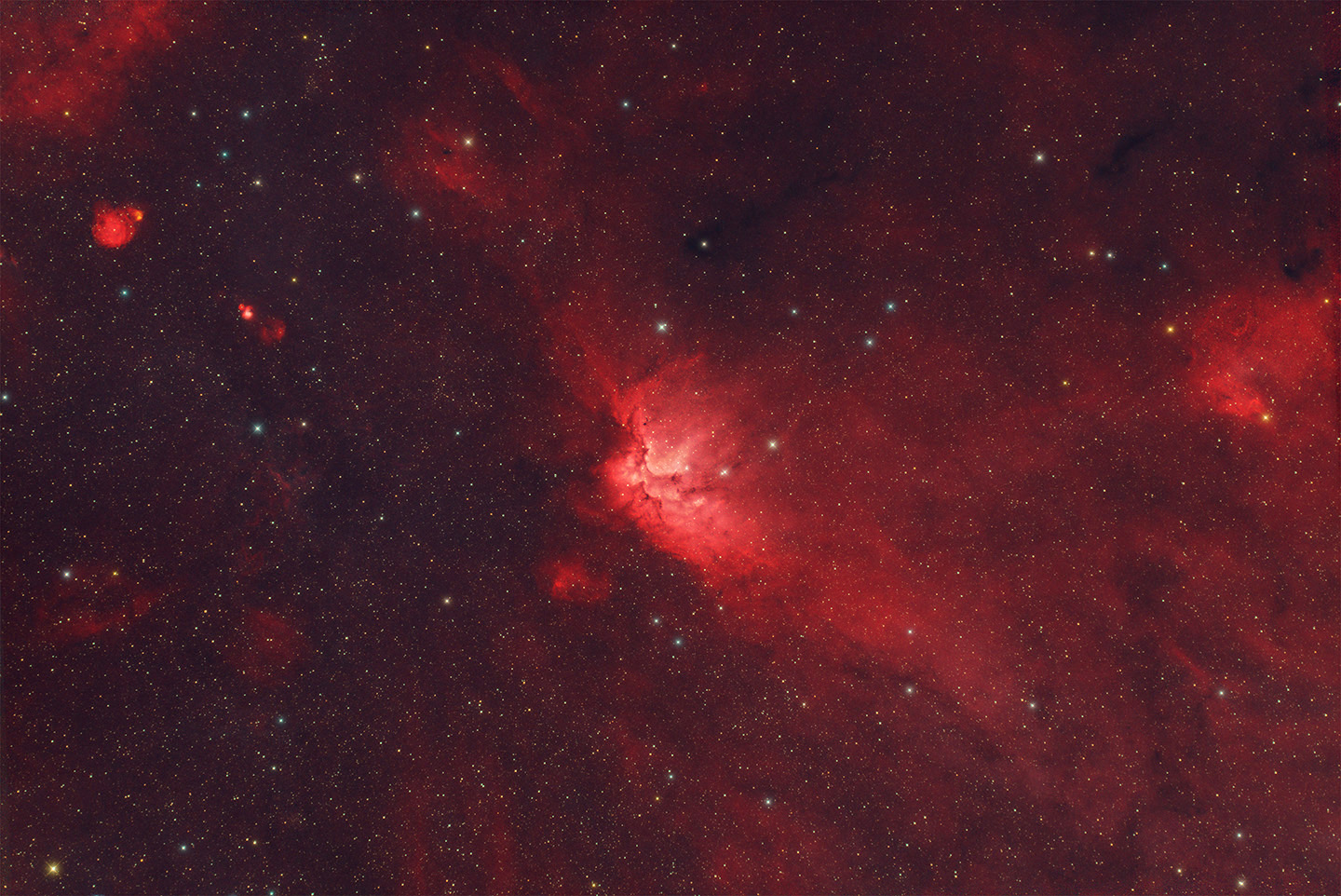 |
Wizard Nebula
|
8th January 2025The Crescent Nebula, NGC 6888 |
The Crescent Nebula at the centre of my image is a giant gaseous shell blown off from a massive Wolf-Rayet star (HD 192163). This a very young star of only 4.5 million years, which has evolved ultra fast. First it expanded enormously to become a red giant and ejected its outer layers. Two hundred thousand years later the intense radiation from the exposed hot, inner layer of the star began pushing gas away at speeds around 5 million km per hour! When this high speed "stellar wind" rammed into the slower red giant wind, a dense shell was formed. HD 192163 will likely explode as a supernova in about a hundred thousand years. Also in the image is the very faint Soap Bubble Nebula - if you know where to look (right).
|
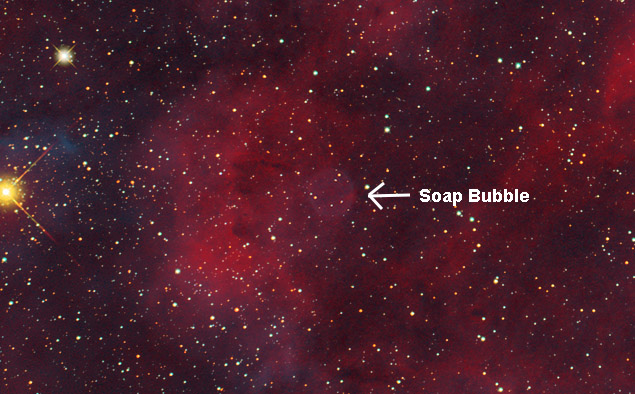 |
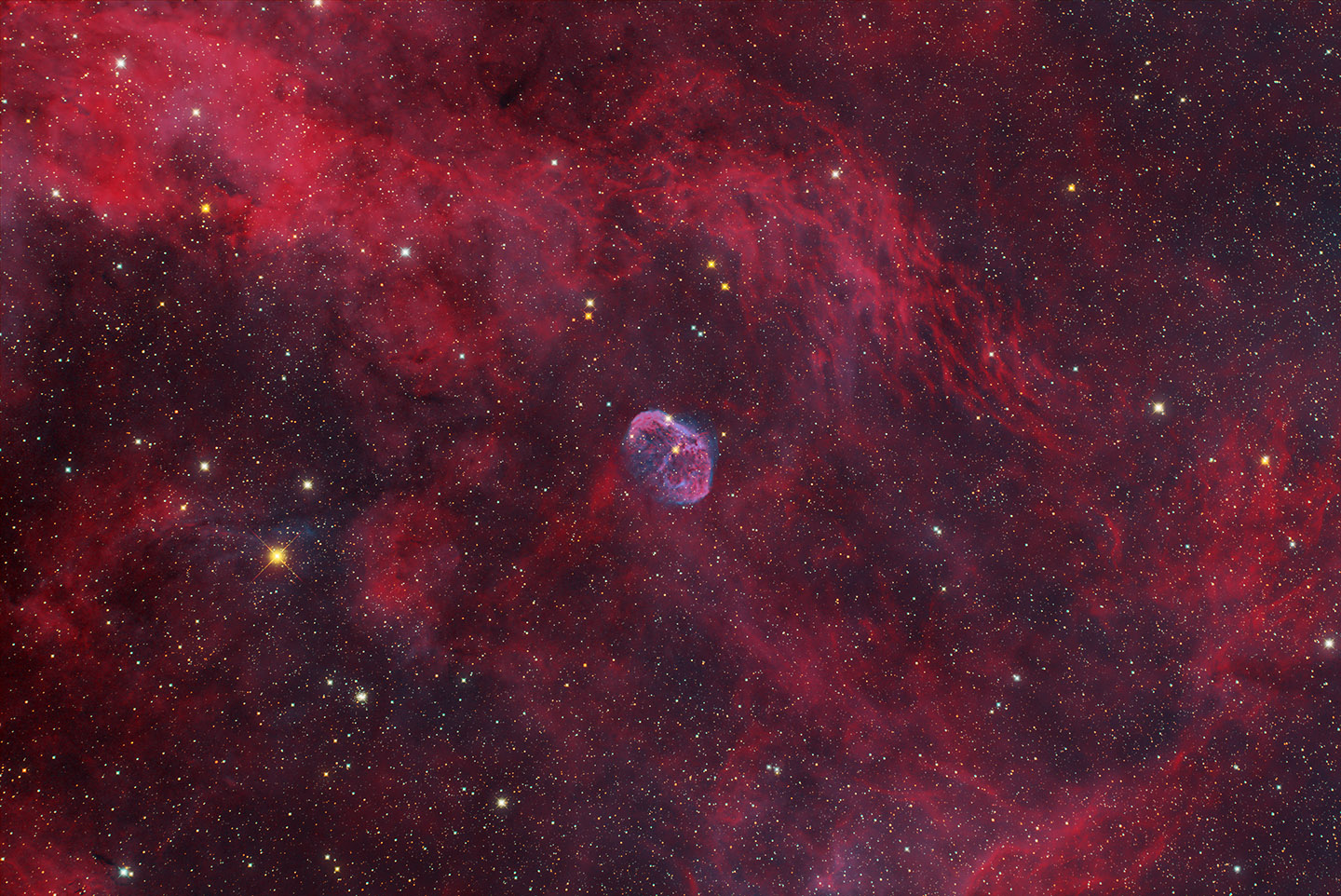 |
Crescent Nebula
|
3rd January 2025Moon and Venus Conjunction - 3rd January 2025 |
December was a non-event with no clear nights - well ones without moonlight or strong winds. At last in the new year we had something to observe - a fabulous conjunction of the Moon and Venus. Just got it before it dropped down below the trees. Didn't stop out for long as there was a freezing cold north wind.
|
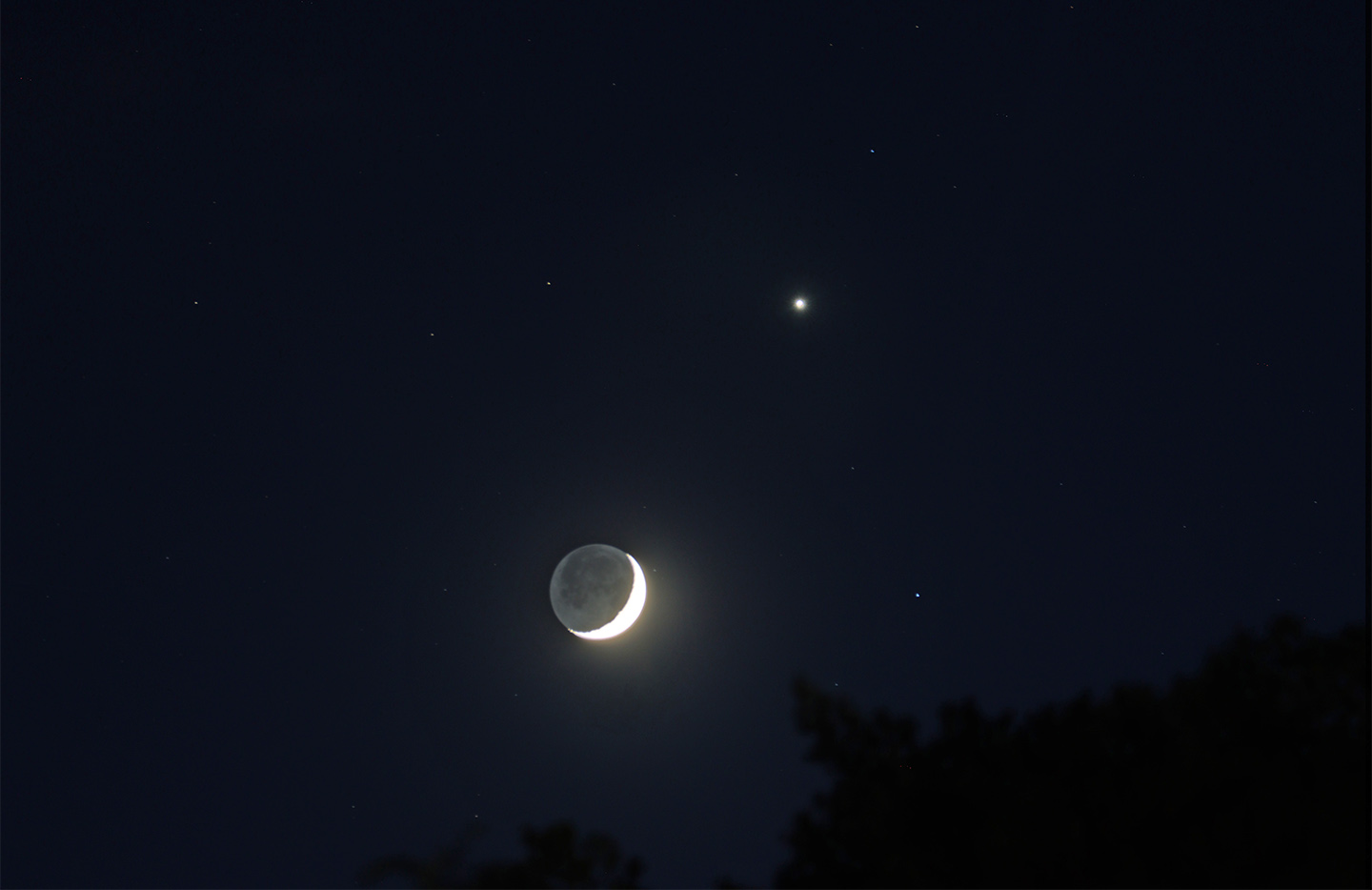 |
Moon and Venus Conjunction 2025
|
8th December 2024Elephant's Trunk Nebula and IC1396 |
The Elephant's Trunk Nebula is just part of the large roughly circular nebula IC1396 and is the dark nebula middle-right. It is actually catalogued as IC1396A. The full nebula is one of the largest emission nebulae in the Northern Sky with a diameter of 3 degrees and contains many young stars in the process of forming. One of the benefits of using the ASIAIR (computer) is that it can be left unattended and carries out meridian flips with no user input at all. It knows exactly where the telescope is pointing pre-meridian and makes sure that same spot is centred after the flip. It uses plate solving to do this. My image right was taken with my 12.5 inch Ritchey-Chretien back in Lancashire and is just a close-up of the Elephant's Trunk. That did need user intervention for meridian flips.
|
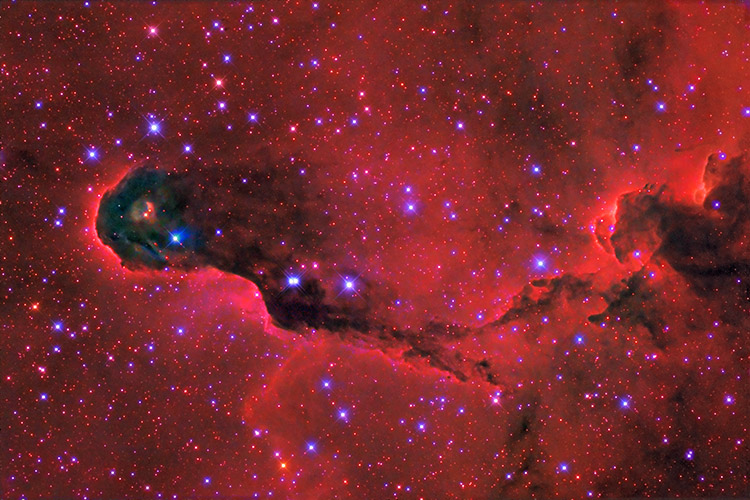 |
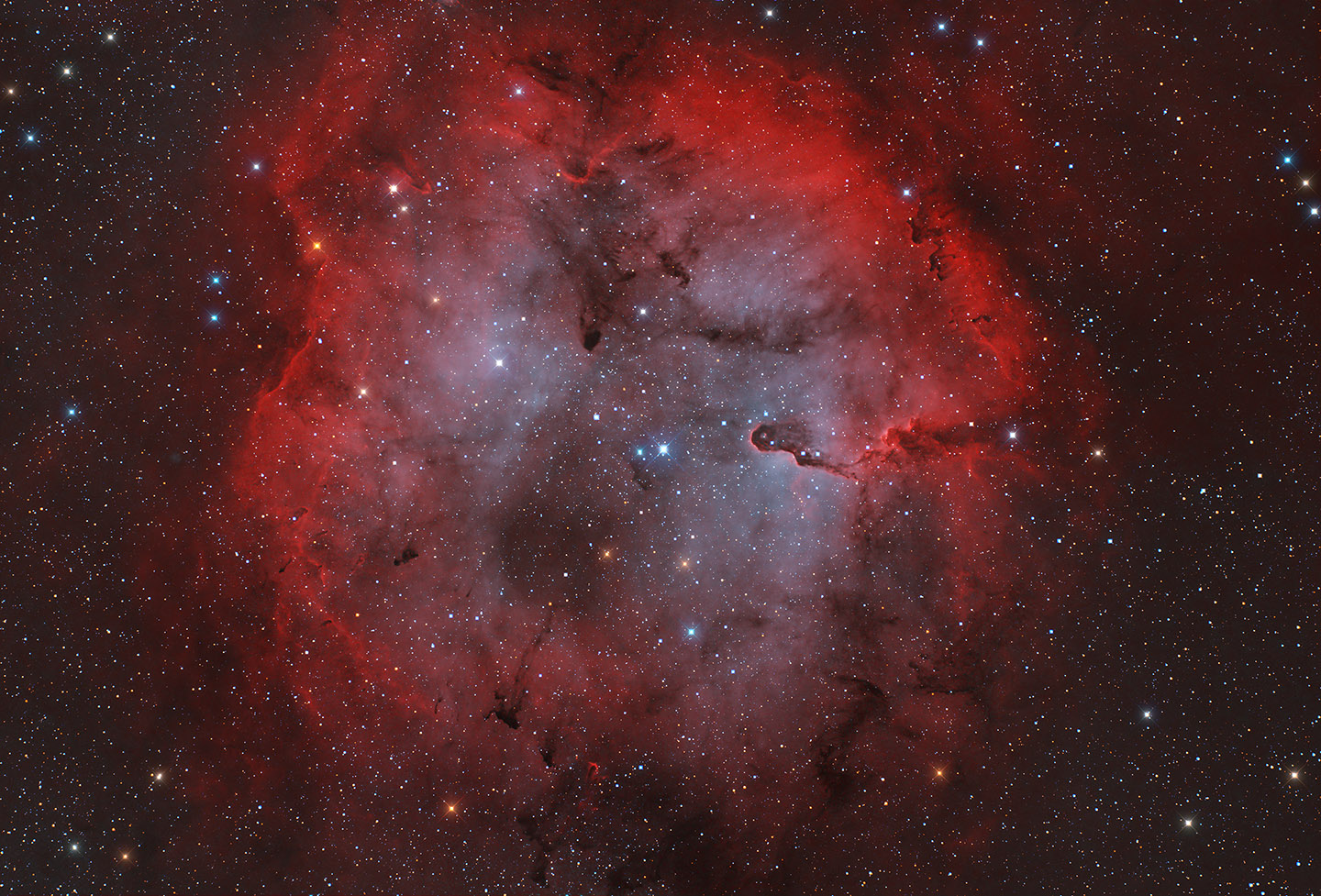 |
IC1396
|
14th November 2024Cocoon Nebula, IC5146 |
Three nebulae for the price of one. An emission, reflection and dark nebulae all interlinked and about 4,000 light years away in the constellation of Cygnus. The bright star at the centre of the Cocoon is very young at 100,000 years and is believed to have blasted through the dark nebula and energised the red emission nebula and illuminated the reflection nebula. Within the nebula are around 200 YSOs - young stellar objects i.e. stars just forming. The dark nebula stretching out to the west (right) is Barnard 168 (B168). My close-up image to the right was taken in 2009 with a 12.5inch RCOS and colour infomation collected in 2014.
|
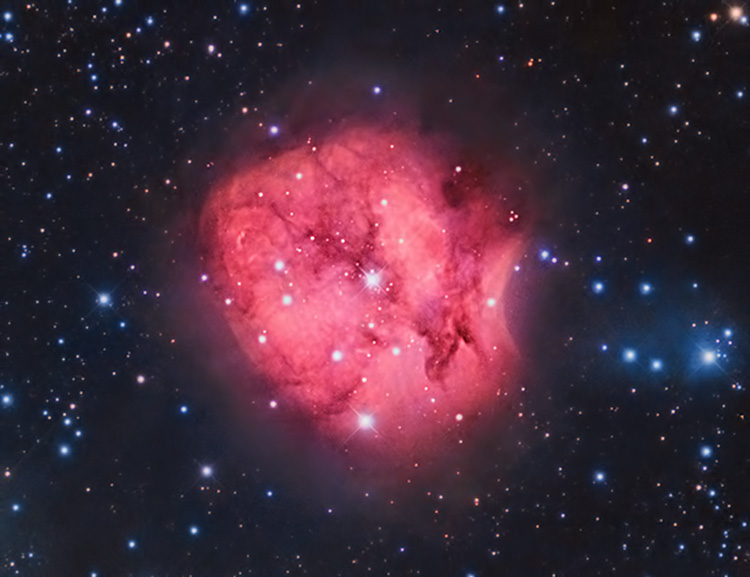 |
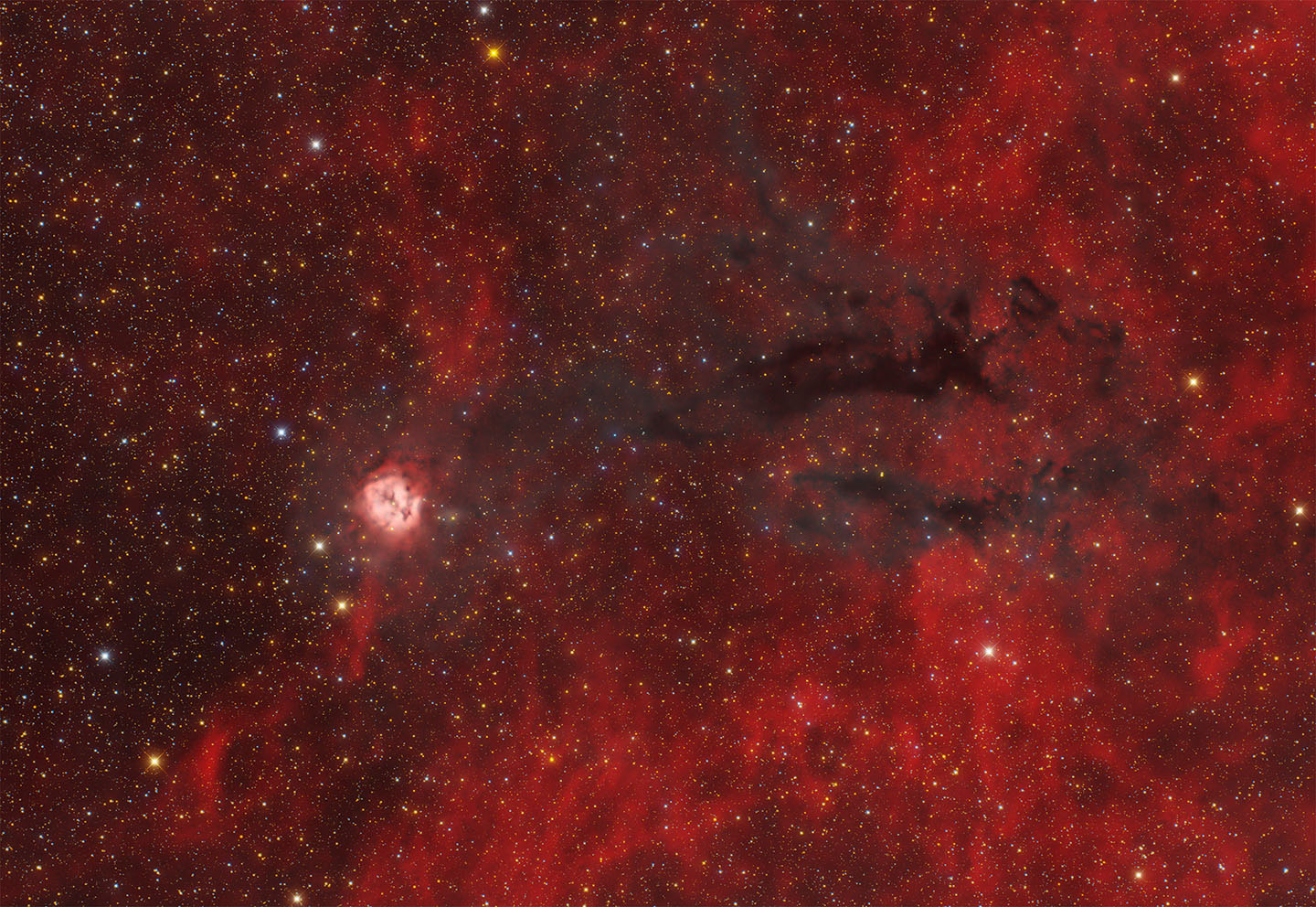 |
Cocoon nebula, IC5146
|
|
26th October 2024Flying Bat and Squid Nebulae, Sh2-129 & OU4 |
Two overlying nebulae that are very different in type and brightness. In order to show the blue-green Squid Nebula its brightness has been boosted to stop it being swamped by the much much brighter red emission nebula of Sh2-129. Without this boost it is very faint, so much so that it was only first noticed in 2011. The Squid Nebula, actually OU4 named after its discover (Nicolas Outters ), is a planetary nebula of an unusal shape no doubt due to its parent star being past of a triple star system - the blue star at its centre. The huge apparent size of OU4 , around 1 degree, implies it must be relatively close although this is far from certain.
|
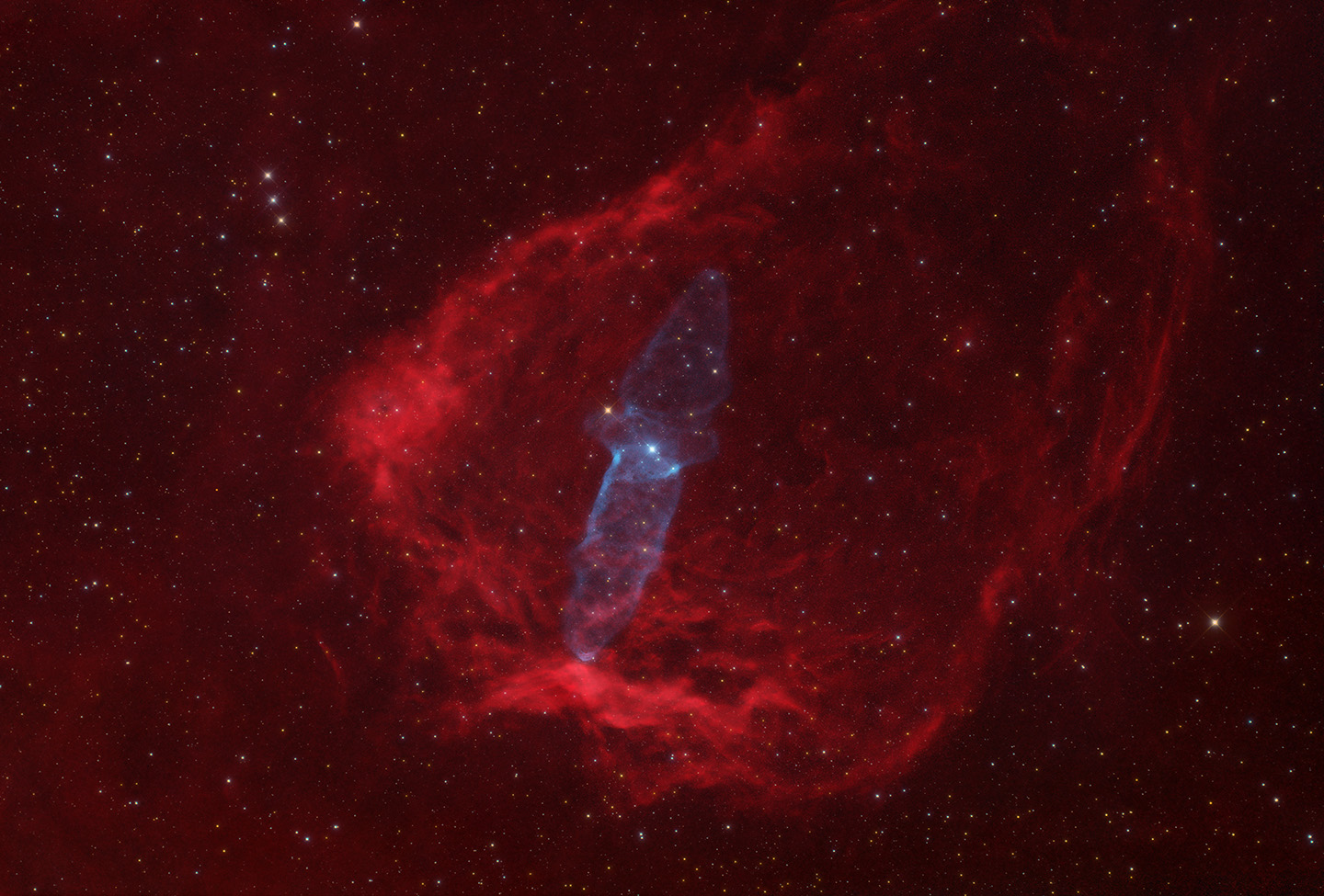 |
Squid Nebula (OU4)
|
|
18th October 2024Comet C/2023 A3 (Tsuchinshan-ATLAS), 18th October 2024 |
Another clear night on the 18th, same comet but a different field along with my son and grandson Tom. It was not as bright but Tom spotted it with his phone. Everyone got a great picture of it. Modern phones make a fabulous job of night-time shots. We were lucky the comet was between some wispy clouds. The anti-tail had now faded. Full Moon again.
|
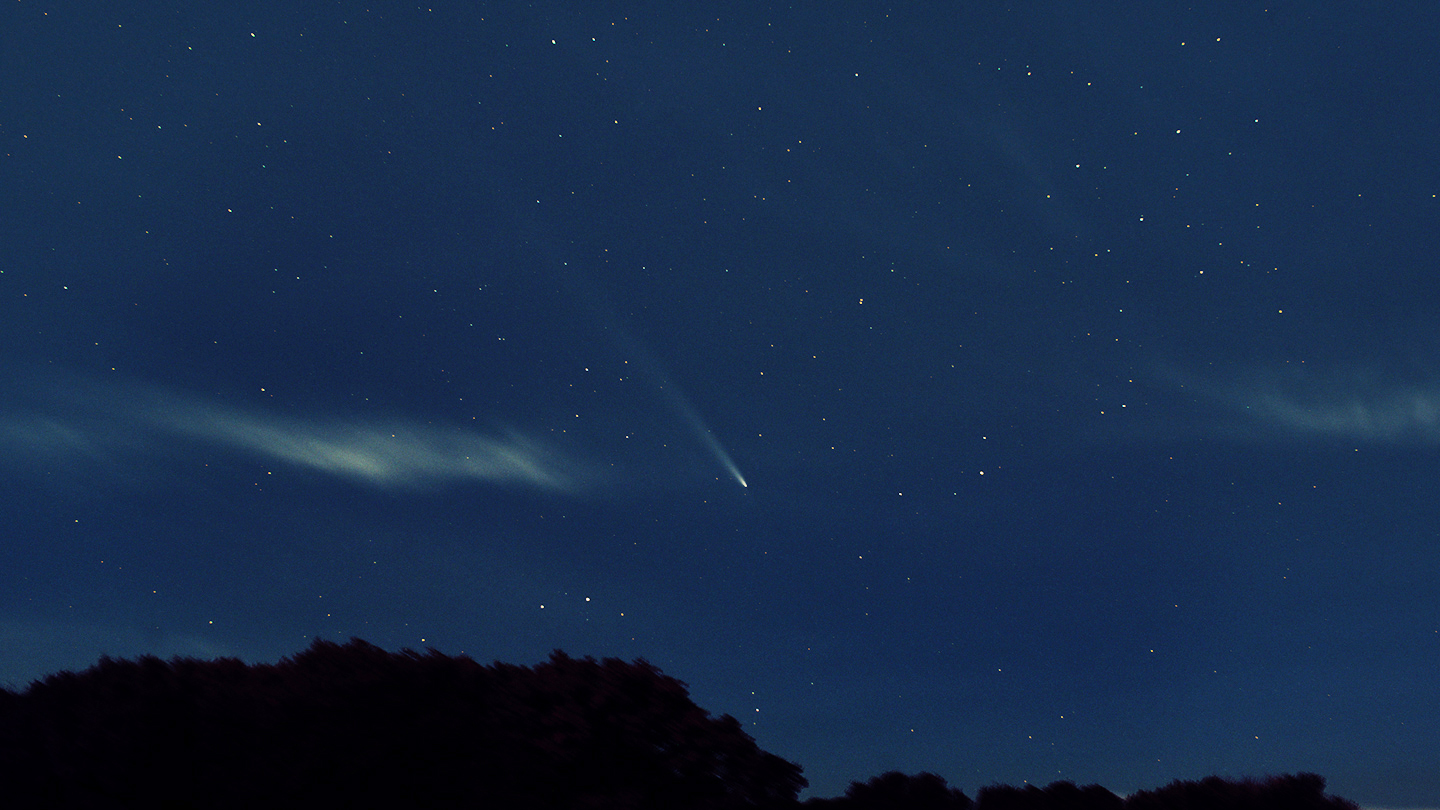 |
Comet Atlas, 18th Oct 2024
|
|
17th October 2024Comet C/2023 A3 (Tsuchinshan-ATLAS), 16th October 2024 |
At last it was a clear evening so I could see if I could get a shot of the comet. I had to head out into the fields to get a low enough horizon as it was still very low down. Visually I couldn't see it but live view on the camera showed it well so I was able to locate it. I suspect a mobile phone would have shown it but I forgot to take mine along. Latest information is that its orbit is likely hyperbolic so it will never return. Good job I went out into the fields. Note the very faint anti-tail pointing down.
|
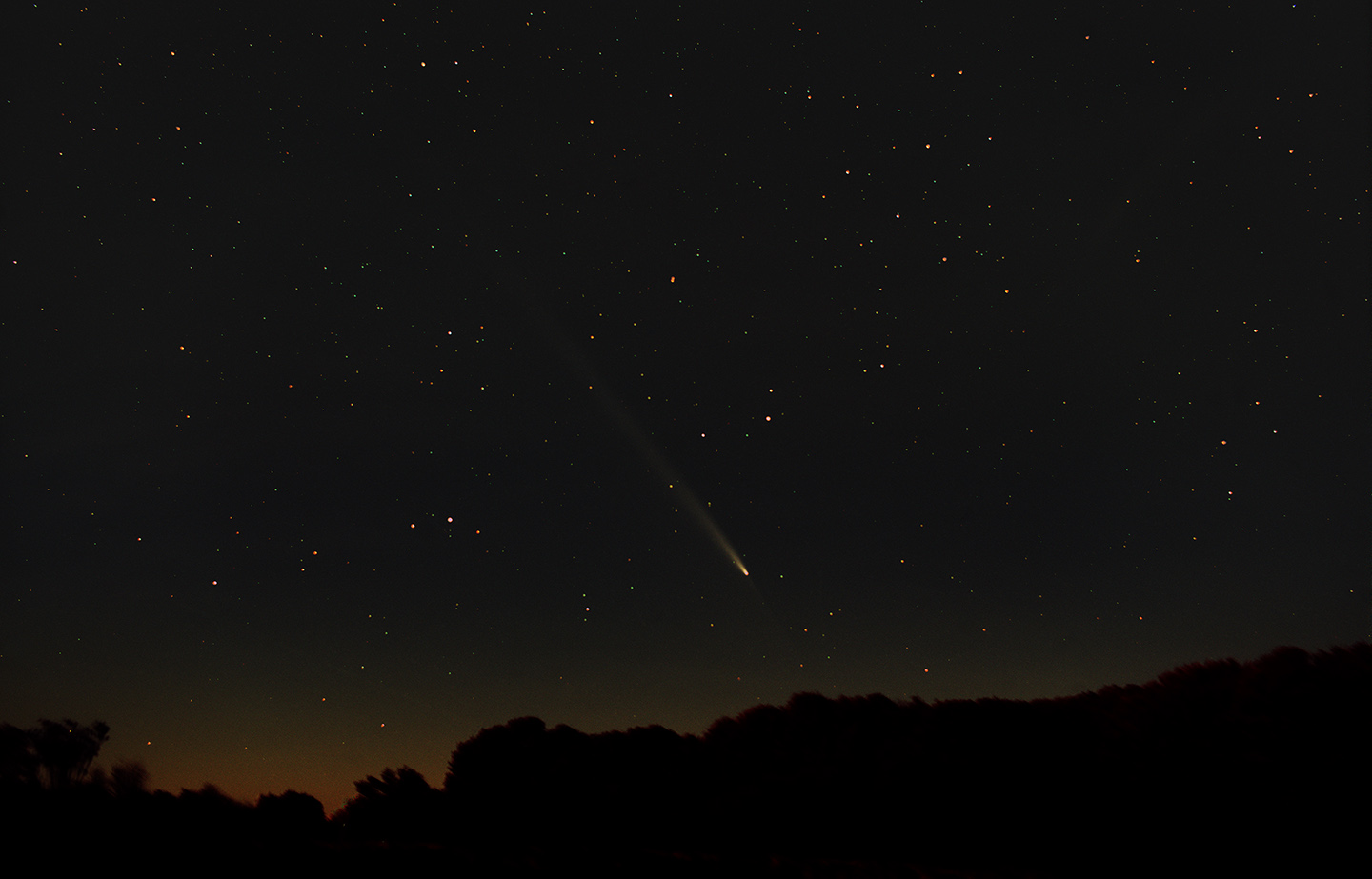 |
Comet Atlas, 16th Oct 2024
|
|
10th October 2024Globular Cluster M75 & Dwarf Planet Pluto |
It was a poor night with frequent clouds so went for something simple. In the end I only got 13 useable images but just about enough to record Pluto. It seemed fainter than I expected and although catalogued at 14.5 magnitude it appeared nearer to mag 15 than that. This was very low for me with only a short interval between trees when they were visible from my garden.
|
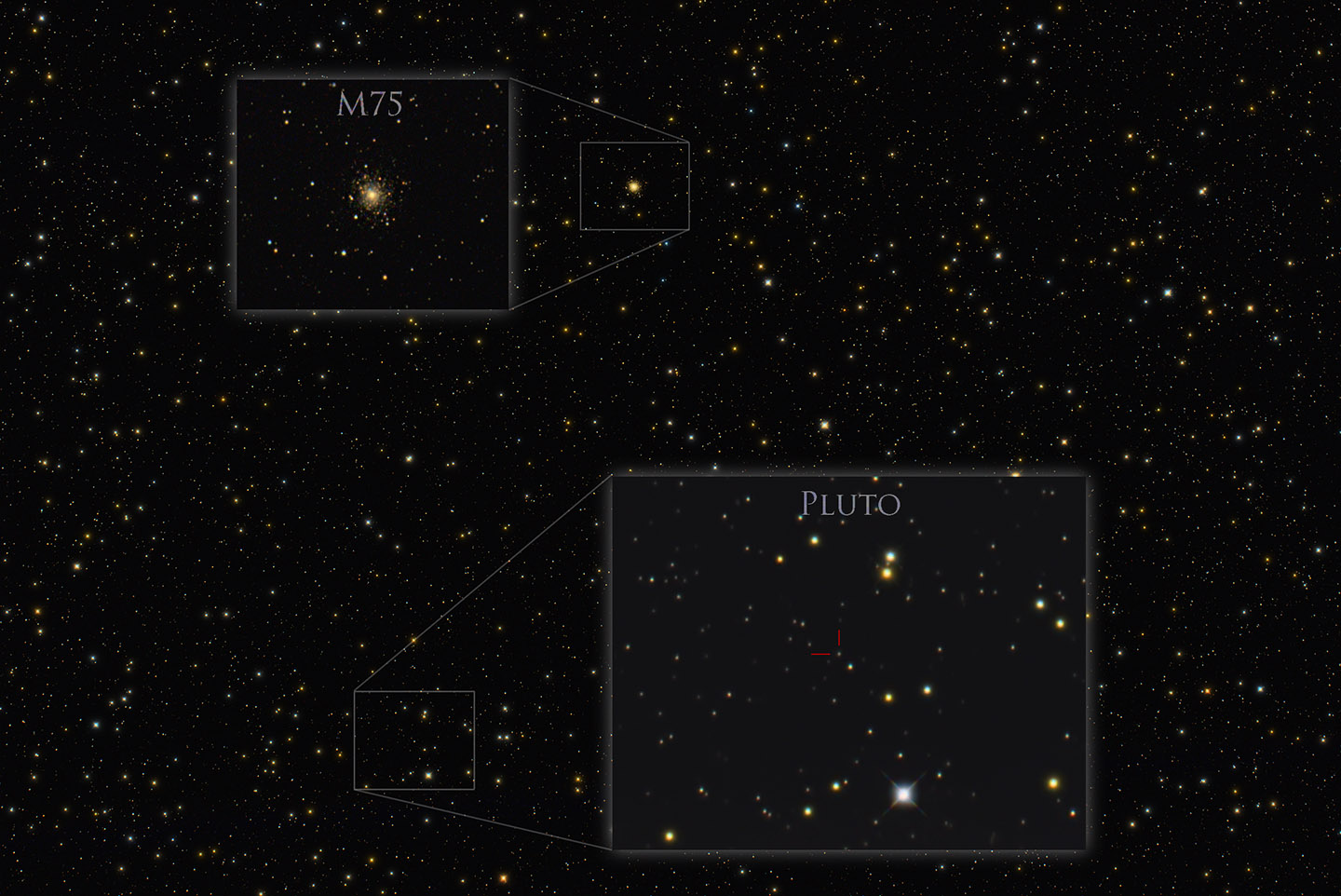 |
M75 and Pluto
|
|
27th September 2024Globular Cluster, M92 |
Hercules' other cluster so often overlooked. I must admit I am one who has forgot about in the past. In fact it is 20 years since I took an image of this globular. It is around 12 billion years old with approximately 1/3rd million stars.
|
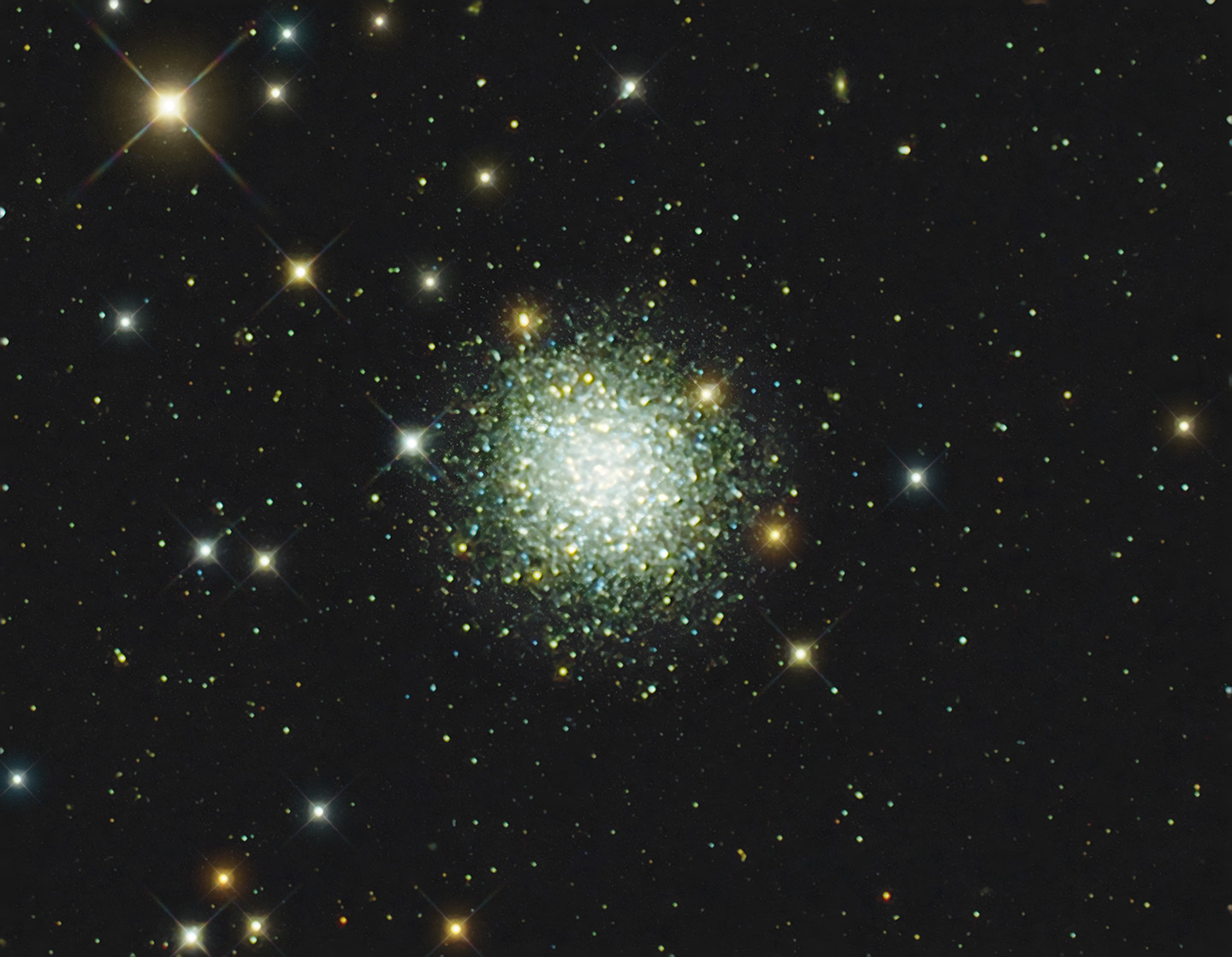 |
M92
|
|
16th September 2024Globular Cluster, M13 |
After the summer shut down I chose a nice and bright object to get imaging going again. The Moon was out (72% full) so it had to be something not too faint. Amazingly everything worked. Globular Clusters are old. M13 is almost 12 billion years old and its stars are of population II category, markedly lower in metals than population I stars like the Sun. The number of stars in the cluster has varied over my lifetime from 1 million dropping down to 300,000. Latest figutes tend to be rising to around half a million. The galaxy near the top is NGC 6207, a 12th-magnitude edge-on spiral, class SA(s)c. If you look carefully between NGC6207 and M13 is the very small galaxy, IC 4617.
|
|
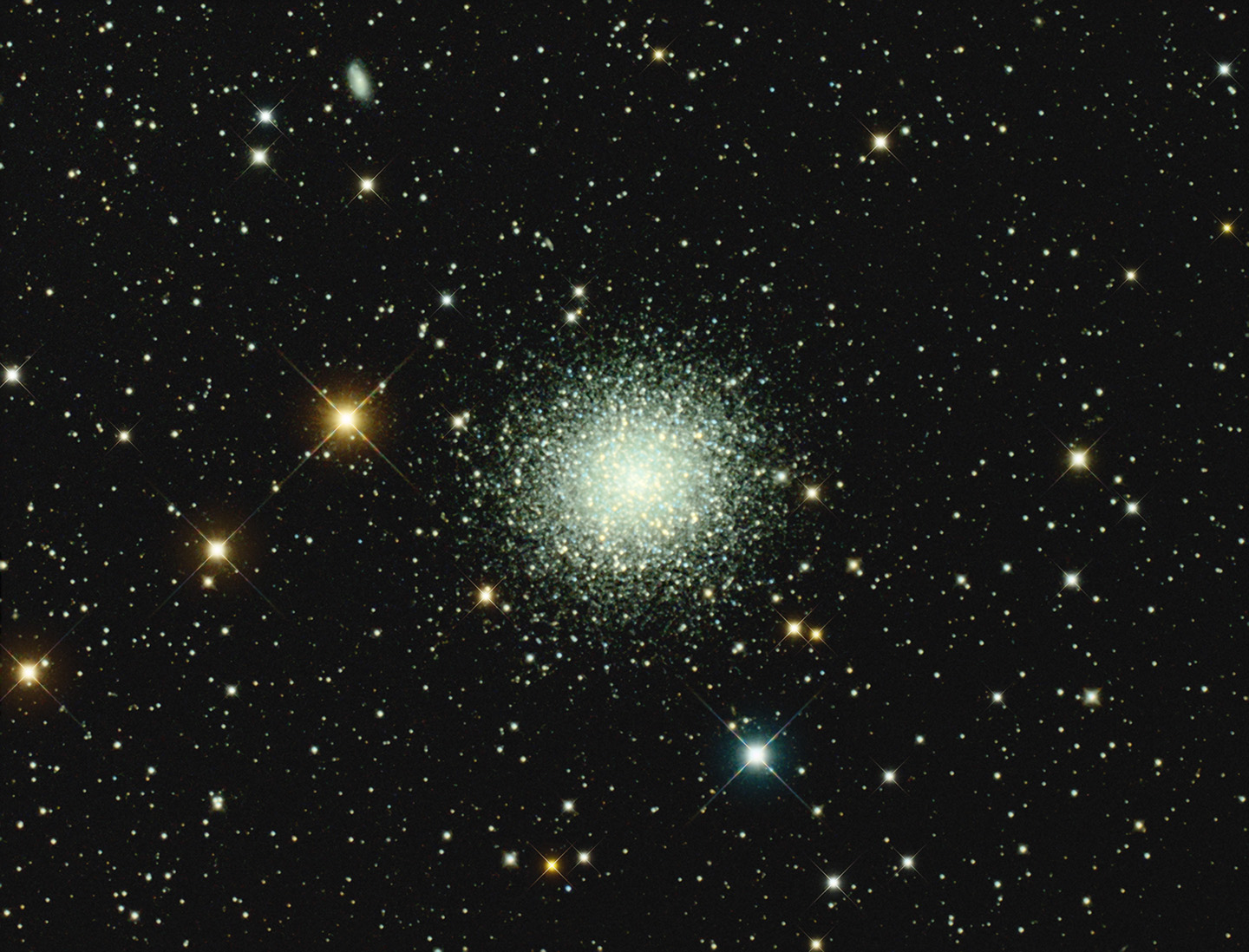 |
M13
|
|
12th May 2024Aurora over Norfolk, 10th May 2024 |
Probably the most spectacular display of aurora over Britain in living memory! Normally at best there could be a greenish glow low on the northern horizon. This time it was all colours and even in the south too. Images were back garden hand-held shots by my son John and myself. Nothing sophisticated. |
|
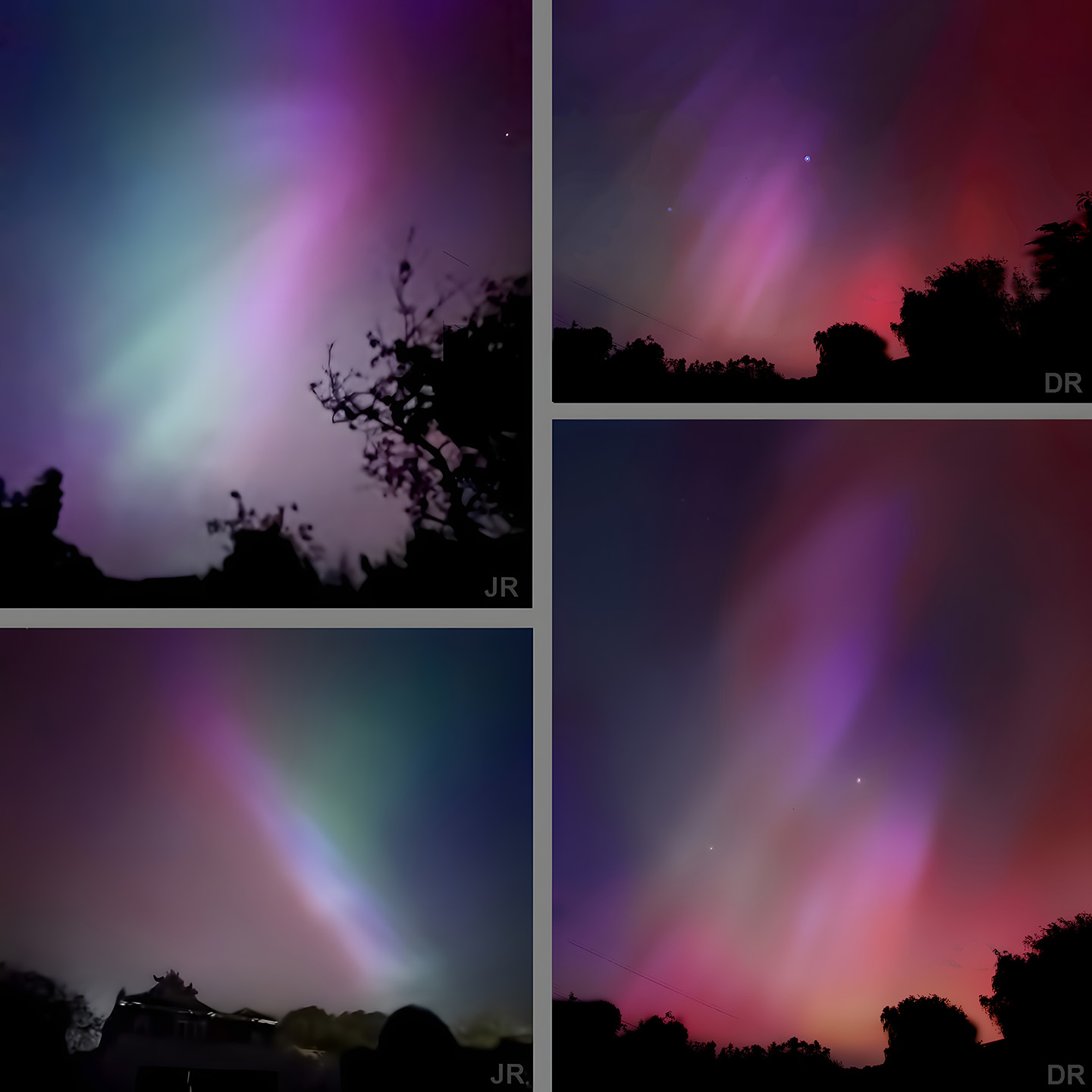 |
Aurora over Norfolk
|
|
24th April 2024Spiral Galaxy, M106 |
Another galaxy that benefits from having Ha data - with a very complex core. So I returned to collect the narrowband data.M106 (NGC 4258) is one of the largest and brightest nearby galaxies very similar in actual size and luminosity to the Andromeda Galaxy. It was discovered by Pierre Méchain in 1781. M106 contains an active galactic nucleus (AGN) and these days is classified as a type 1.9 Seyfert. It is perhaps most famous for the presence of a water megamaser. Observiations of this enabled the mass of its central black hole to be calculated and also permitted its distance to be determined independently of other standard methods. It is 23 million light years distant. The galaxy to its right is NGC 4217, which is more than likely a companion. M106 also has another hidden feature namely twin powerful jets in its central region- see right. Reference: Jet-related Excitation of the [C II] Emission in the Active Galaxy NGC 4258 with SOFIA P. N. Appleton et al. 2018.
|
|
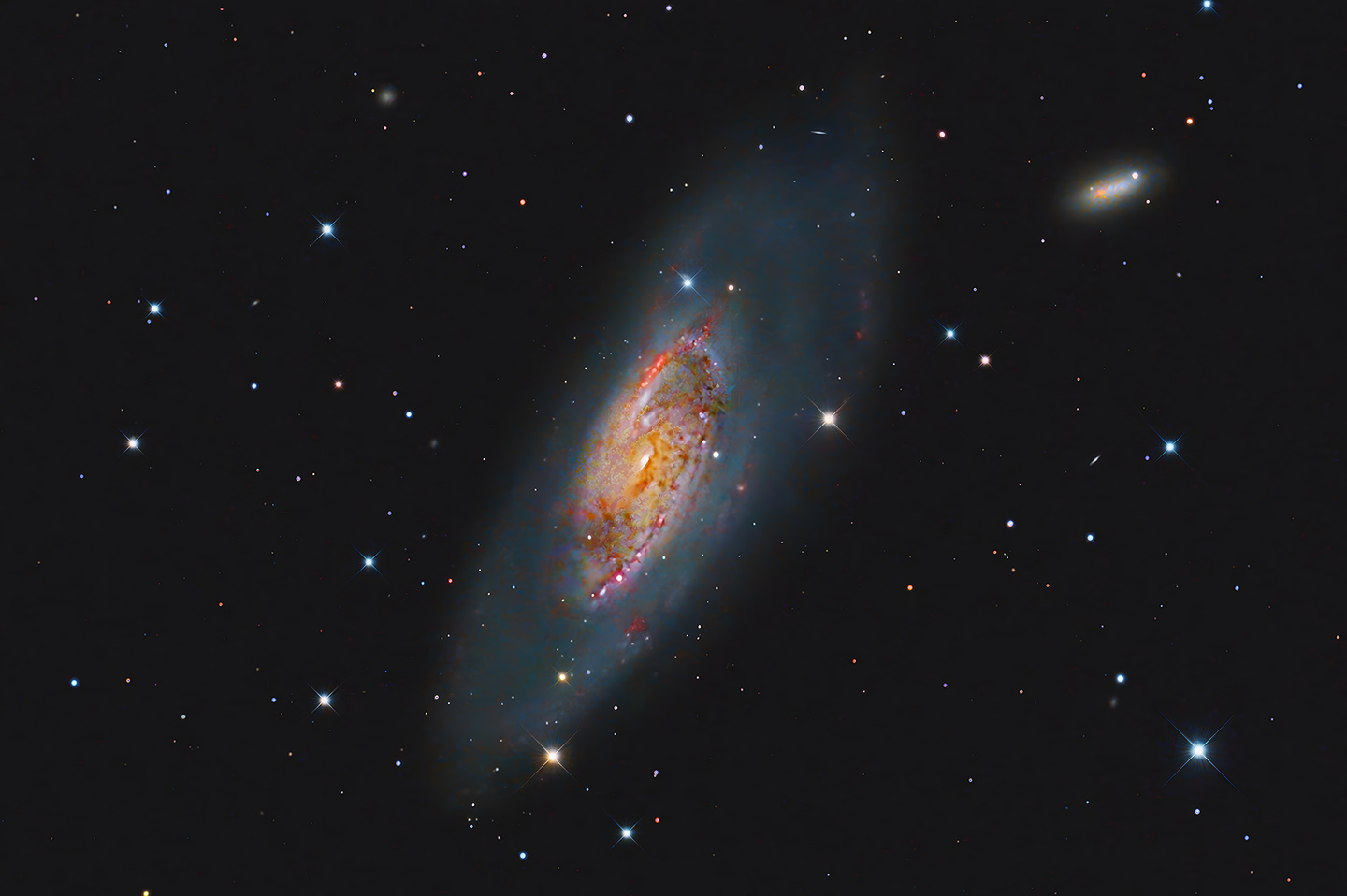 |
Galaxy M106
|
|
12th April 2024Open Cluster, M67 |
An old favourite of mine and one a I took many years ago in the film era. That film version was published several times by the US magazine Astronomy - I guess no one else had taken it back then. So more than time to return. Very old for an open cluster but its location well above the plane of the Milky Way means it has been able to survive for around 4 to 5 billion years. Similar age to the Sun and there are Sun like stars present in the cluster. It is though dominated by several yellow/red giants including some off to its right (west) side. Also present are blue stragglers. Normally blue stars signify youth but not in this case.
|
|
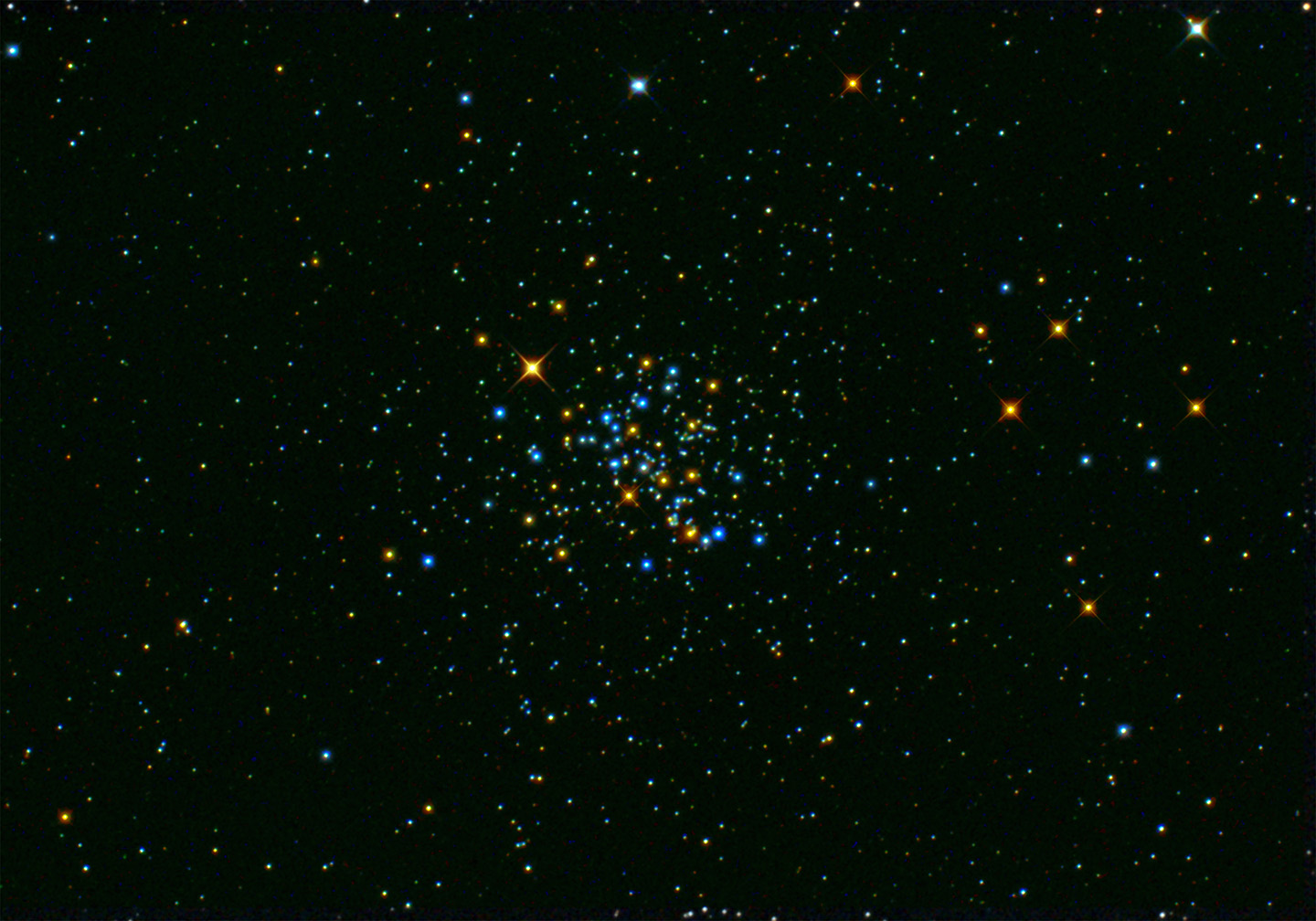 |
M67
|
|
4th April 2024Spiral Galaxy, M101 |
A galaxy that benefits from having Ha data - all those emission nebulae in its spiral arms. So I returned after a 12 year gap to collect the narrowband data plus some more rgb as well. M101 is a giant classic face-on spiral galaxy - nearly twice the diameter of the Mikly Way and around 25 million light years away. M101 is estimated to contain at least one trillion stars. The galaxy’s spiral arms are sprinkled with large regions of star-forming nebulae glowing red in my image. These nebulae are areas of intense star formation regions and are just like our own Orion Nebula.
|
|
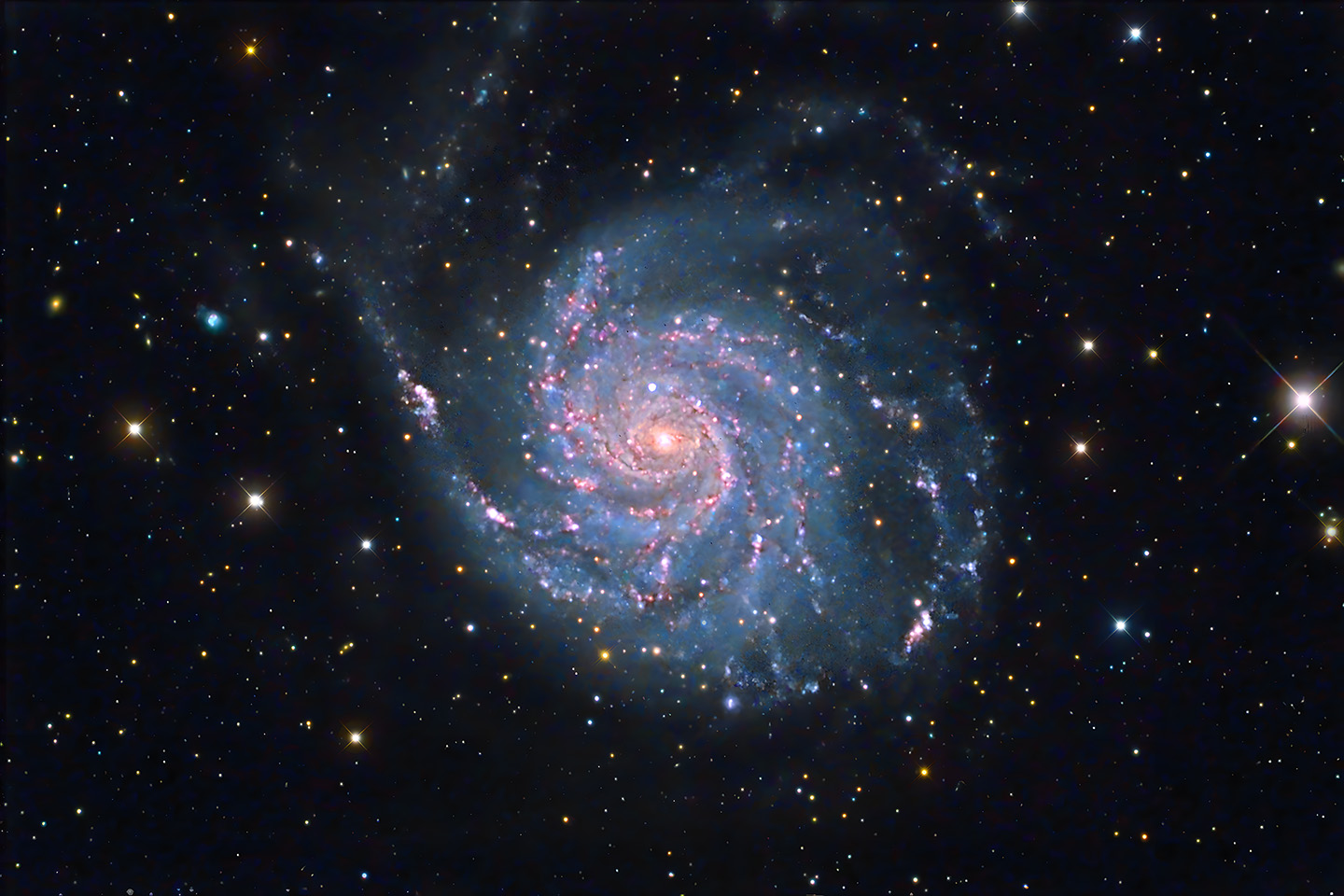 |
Galaxy M101
|
|
23rd March 2024Comet 12P/Pons-Brooks |
Been waiting for a clear night to see the comet but the weather did not oblige. However, on the 17th there was a short clear spell between clouds to get enough to record the basics. I used the latest version od Siril for processing. This uses the fits header to enable a stack on the comet to be correctly aligned after the stars have been removed. This was useful as there was a short gap in my sequence due to a cloud passing through so they were not at a constant spacing. The star removal on a sequence is automatic now but took over 1 hour. Still a big improvement on previous manual methods.
|
|
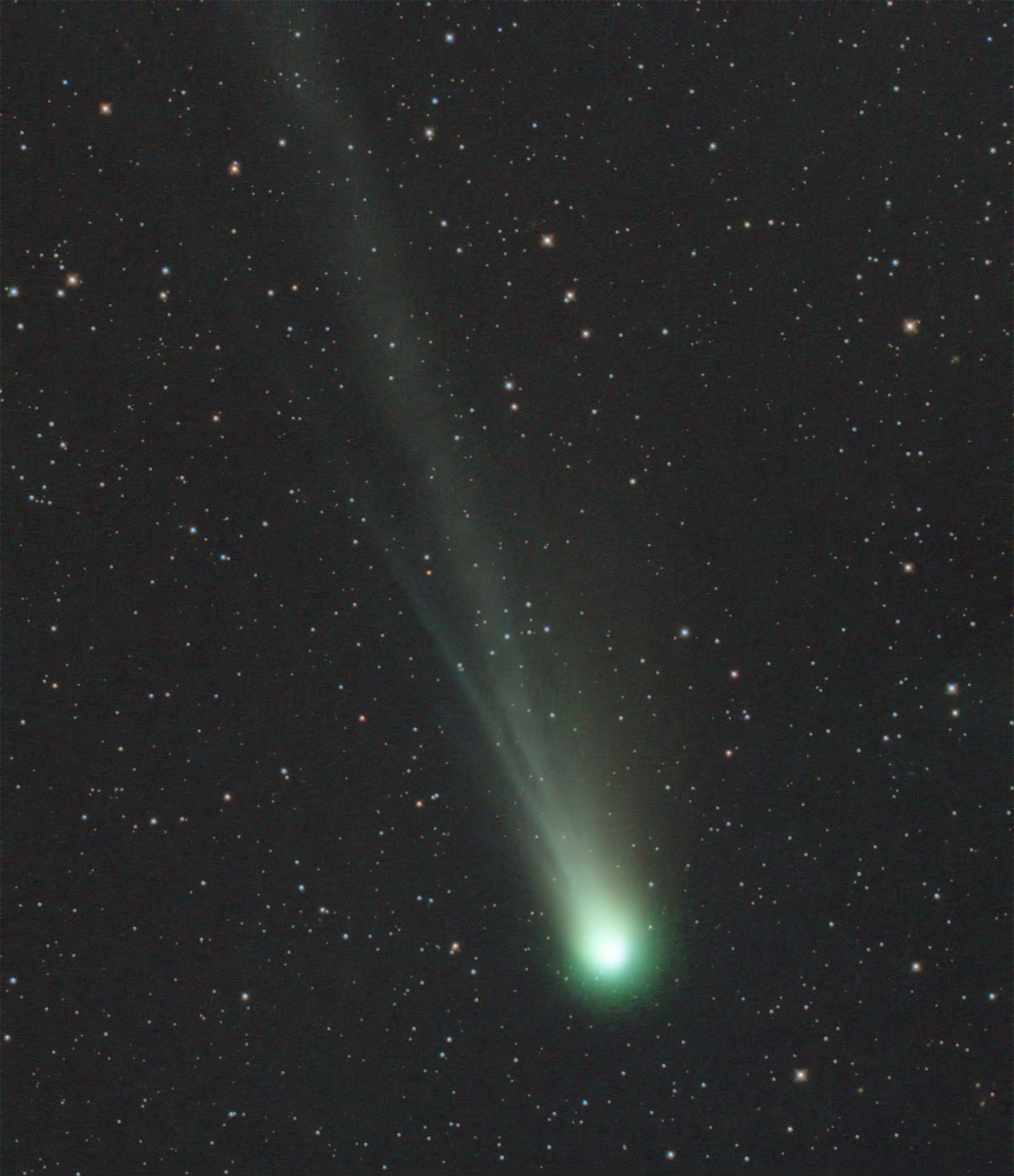 |
Comet 12p
|
|
1st March 2024The Seagull Nebula, IC2177, Sh2-296 |
Multiple objects in this wide-field view with the Sharpstar including several Van den Bergh (blue) nebulae. Easy to find, just above Sirius but seriously low down for Norfolk. This low I am shooting straight over Norwich city so it does come with added light pollution. It is located half in Monoceros and half in Canis Major This was my second run with the Duo camera. I turned the gain up to high on the guide camera and loads of guidestars appeared. I ran with 4 second guiding although faster guiding is often quoted as being necesaary with the AM5 mount. Not sure about that - could end up chasing seeing fluctuations so I will stick with I have always used ie 4 seconds.
|
|
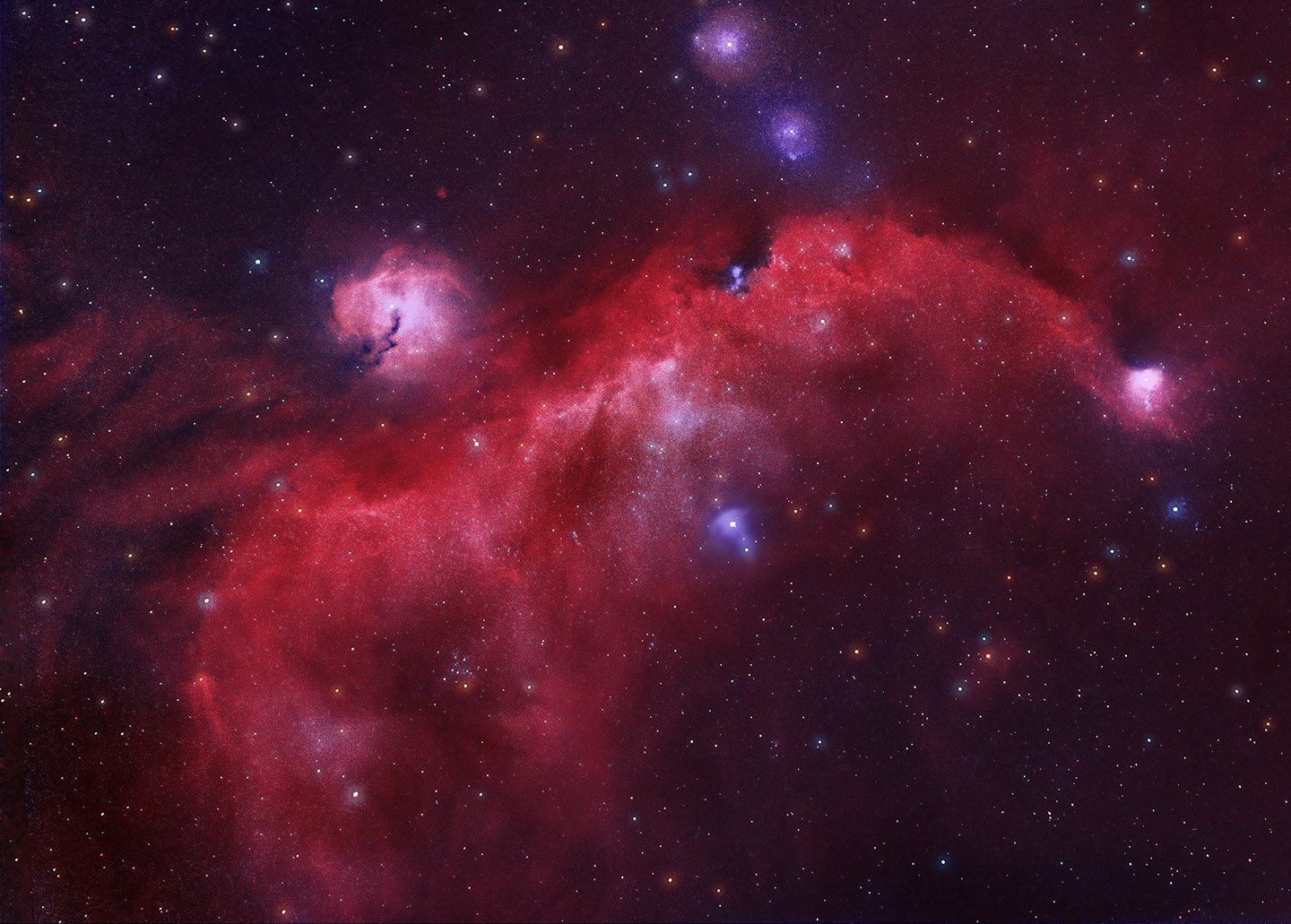 |
Seagull Nebula
|
|
17th February 2024Thor's Helmet or the Duck Nebula, NGC 2359 |
Fourteen years in the making! I had got some H-alpha and OIII data way back in 2010 but needed some better colour data. Hence the first test with my new ZWO 2600MC Duo was to at last get around to collecting some. This object is really too low down for the UK so subject to much light pollution but I am happy with the final result. Not a well understood nebula. What is certain is the central star is a very hot Wolf-Rayet type WR7 star but at what stage in its development the nebula formed is uncertain. So just simply classed as an emission nebula which really doen't do it justice or explain the complex filamentary structure.
|
|
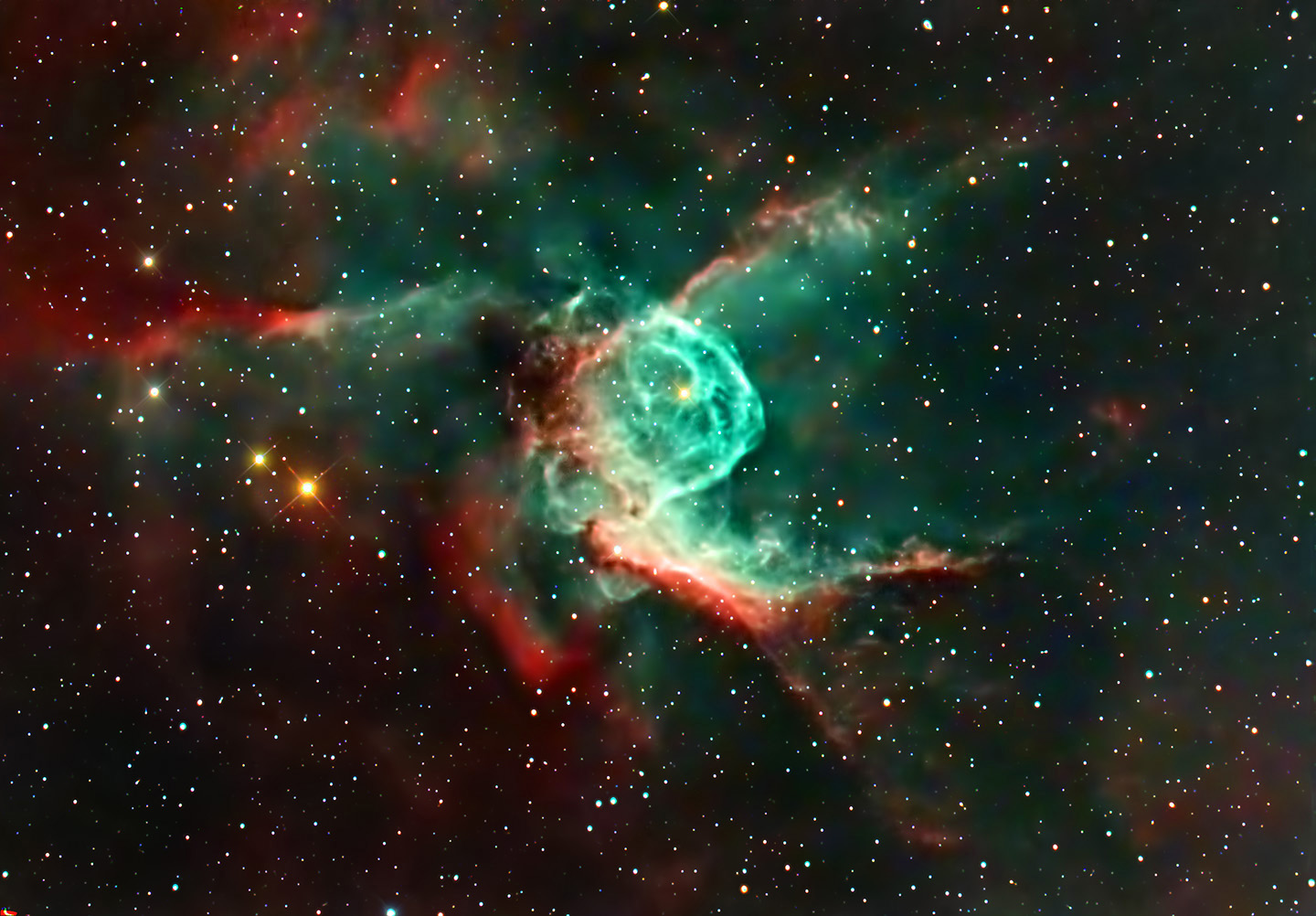 |
NGC2359
|
|
21st January 2024Sharpless Sh2-202 |
One of the wettest and worst winters on record for astronomy - and that is for Norfolk, the supposed dry side of the country. At last in January 2024 we had two clear nights with only a crescent Moon above the horizon. One of the larger Sharpless nebulae at around 3 x 2 degress. Nice and bright too. The little cluster within is Stock 23 or so times called Pazmino's Cluster. The two blue reflection nebulae to the left (east) are VdB 14 and 15.
|
|
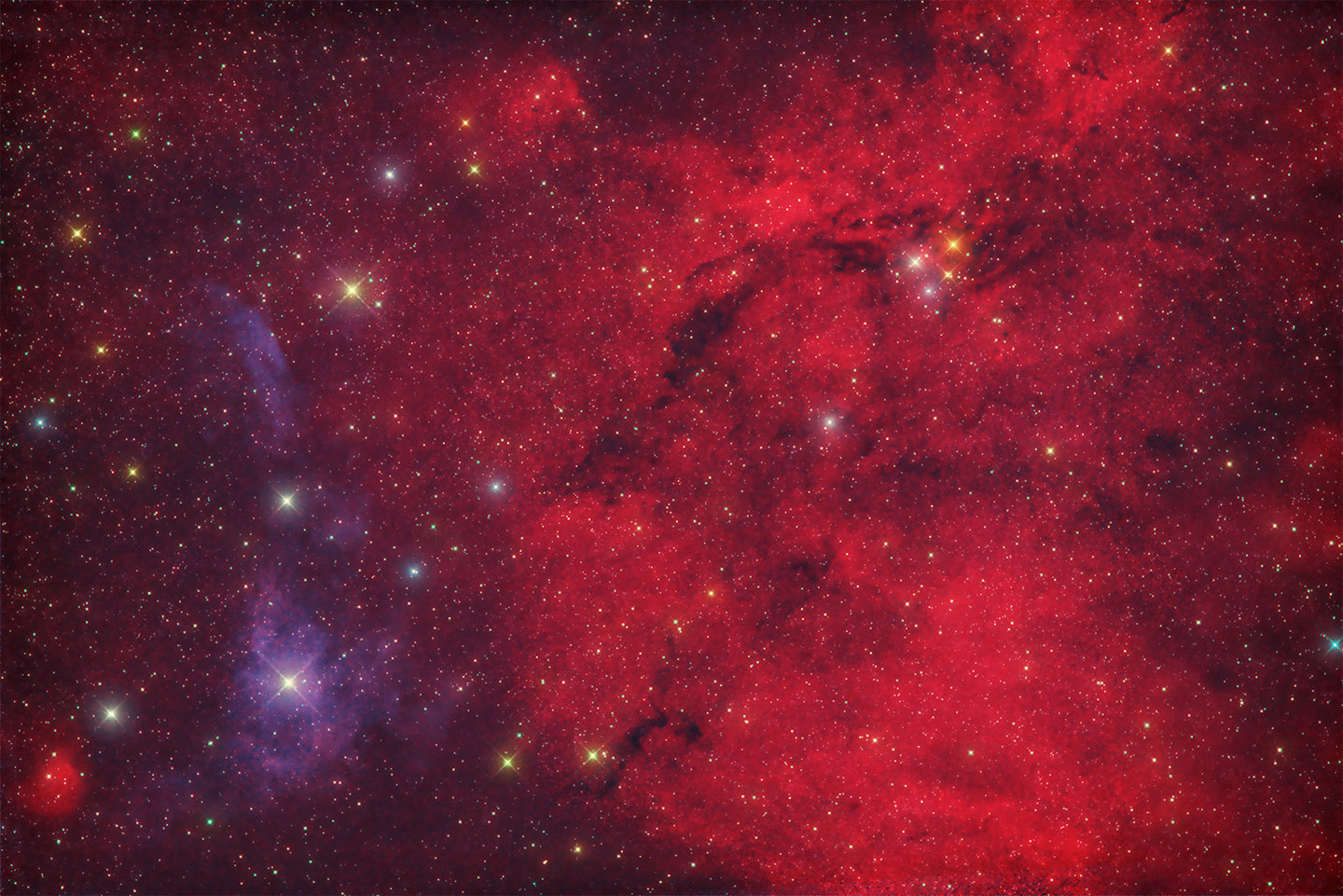 |
Sh2-202
|
|
10th December 2023Andromeda Galaxy, M31 |
A bit of an exploration to see if anything would be visible of the recently discovered OIII nebula adjacent to M31. Absolutely no sign of it in my images so much much longer exposures required. Unfortunately the weather did not cooperate with a wet and gloomy autumn here in Norfolk. This image is actually a 2- panel mosaic.
|
|
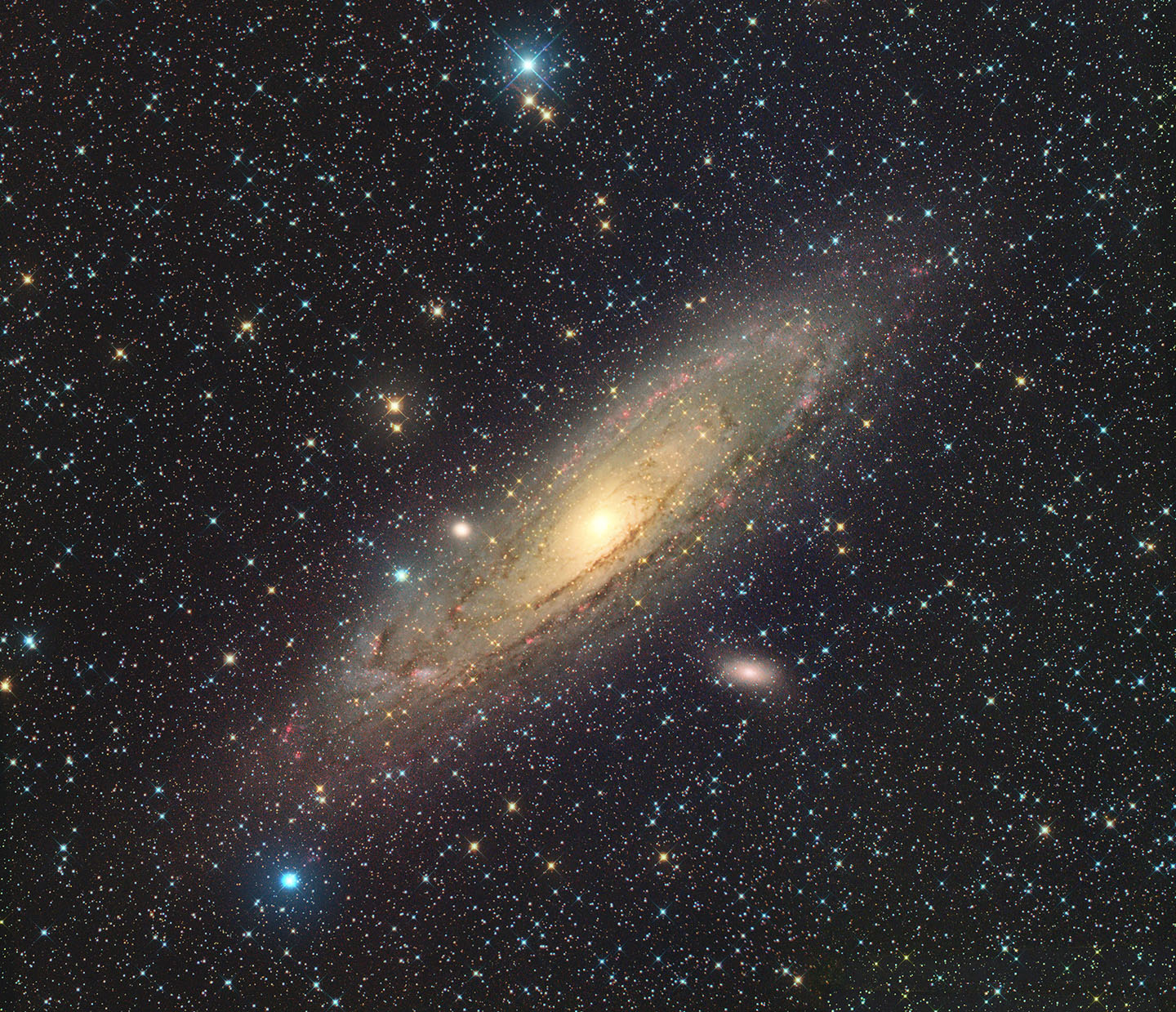 |
M31 Andromeda Galaxy
|
|
26th October 2023Vav den Bergh 152 (& Wolf's Cave Nebula) |
A more challenging object to push the Sharpstar and the Canon 250D a bit harder. Van den Bergh 152 is the bright blueish reflection nebula at the south end (bottom) of the dark nebula B175 (brownish colour). Sometimes referred to as Wolf's Cave Nebula - named after Max Wolf rather than its resemblance to a wolf. The red filaments are part of an ancient supernova remnant. The red and blue nebula above the red filaments is a planetary nebula, PN G111 0+11.6. All located in central Cepheus.
|
|
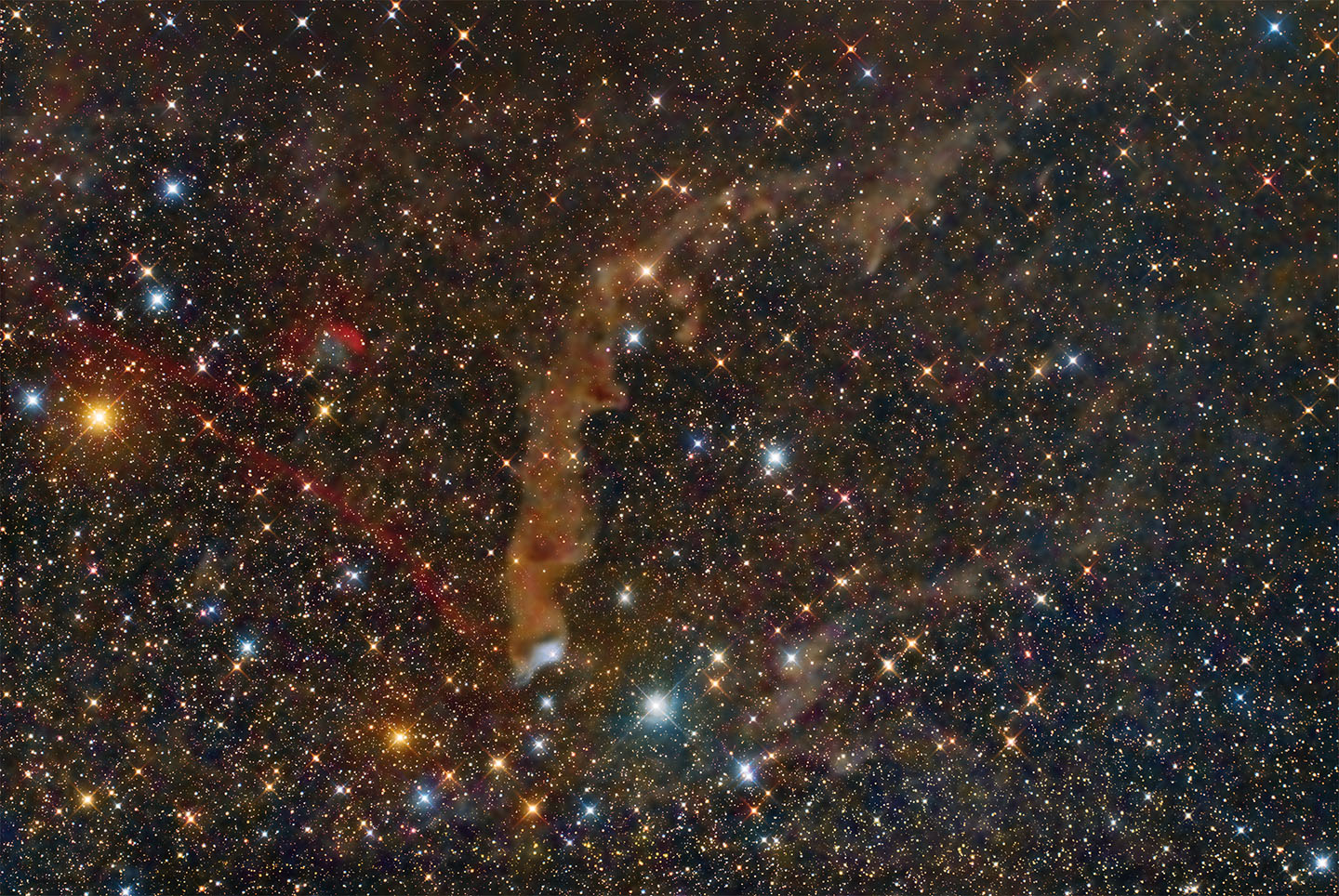 |
Wolf's Cave Nebula
|
|
9th October 2023The Coathanger Asterism |
Little bit deeper this time pushing the new scope a bit harder. For the H-alpha set of image I used a 12nm filter as these fast scopes cause the filters to go out of band. I need to get an offset one for fast scopes. Located in Vulpecula this is another fabulous asterism for small telescopes and binoculars. Also known as Brocchi's Cluster.
|
|
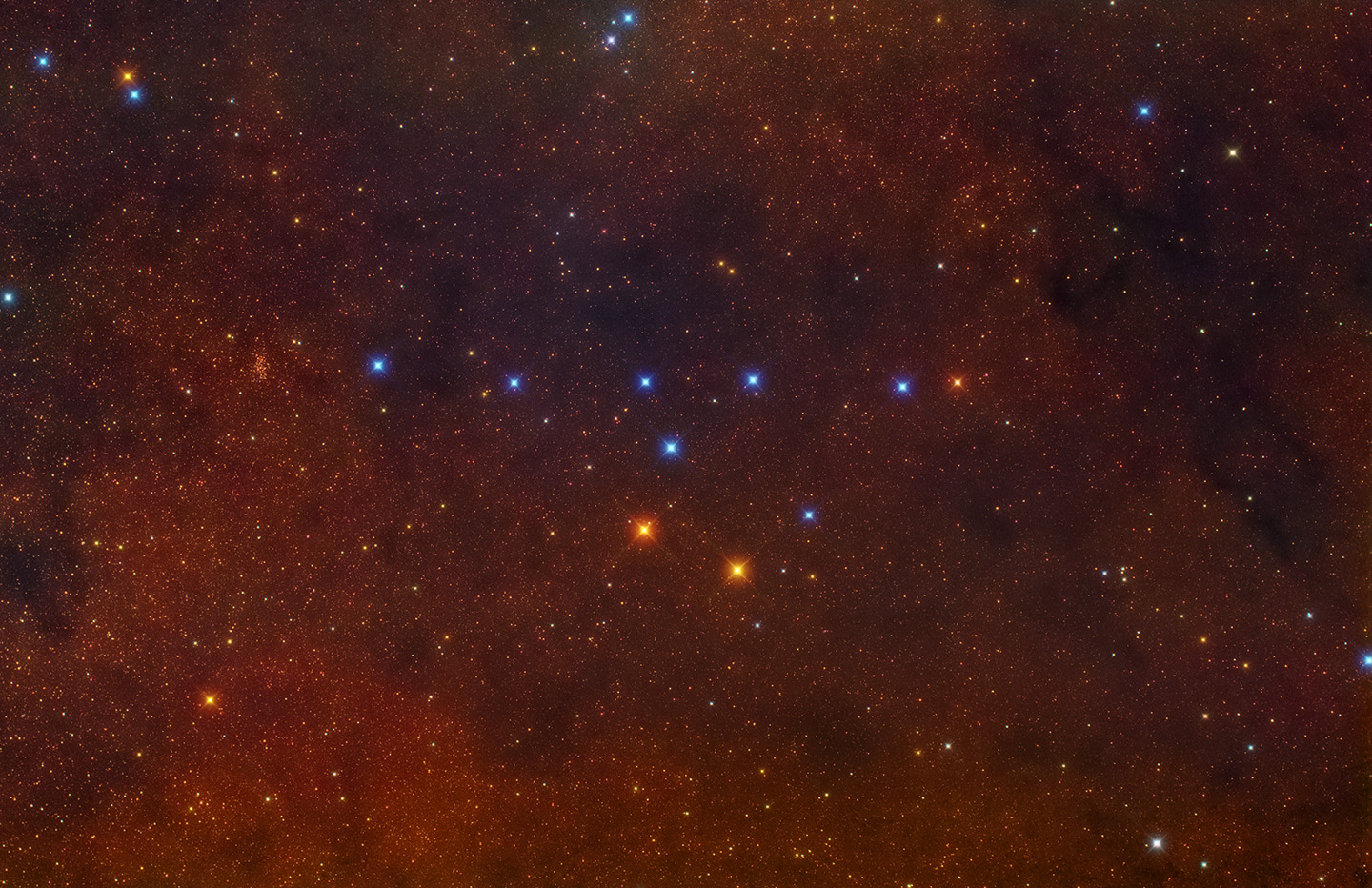 |
Coathanger Asterism
|
|
17th September 2023The Toadstool Asterism |
Something very simple to test everything was working. Some trouble initially with the asiair resetting its location back to China but when I had realised that and reset it to Norfolk it behaved as expected. Decided as this was try 1 to control the camera via a separate timer. Will try the asiair software to do this next time. Located in eastern Delphinus this is a fabulous asterism for small telescopes and binoculars.
|
|
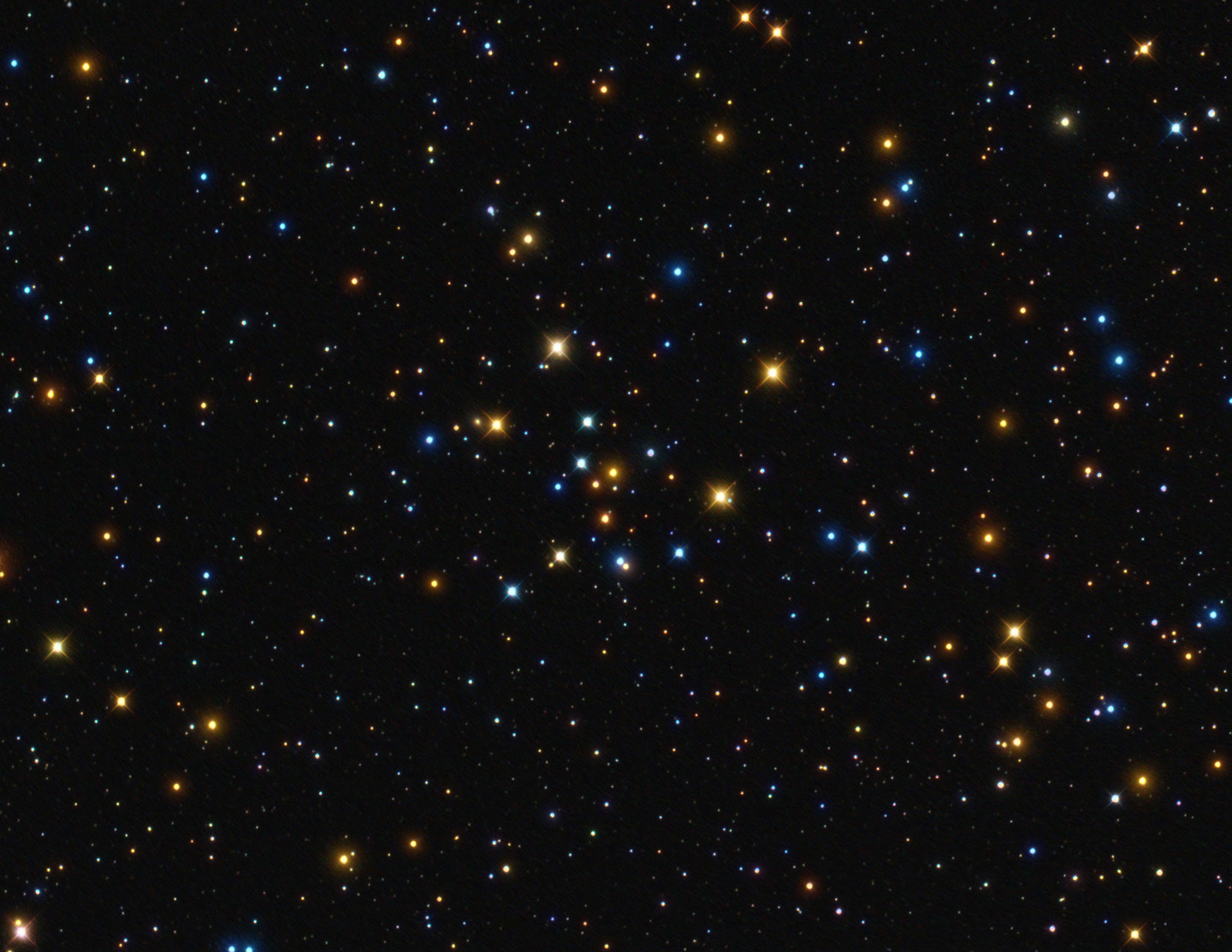 |
Toadstool Asterism
|
|
20th September 2023New Set-up for WInter 2023/4 |
Over 2023 I sold all my old Astro gear - the RCOS 12.5 Ritchey-Chretien, Paramount ME, Apogee Alta U9 camera and the Takahashi FSQ106N. I came to the conclusion it was too onerous a task to start all over again rebuilding it plus a new observatory. Time for something simpler and lighter. I decided on the Sharpstar 130mmm F/2.8 Hyperbolic Newtonian on an ZWO AM5 mount and the ASIair mini controller/power box. I will continue with the Canon 250D for now and see how it goes. The whole set-up can be carried out and is then already fully assembled and cabled up. Just one power supply to connect when outside. The asiair software on my tablet connects wirelessly. The AM5 has no polar scope so I have mounted a laser (just sticking out over the AM5 control panel) to get close. The asiair software then can take over for final polar alignment. The laser can get close - within a 1/10th degree away. Currently I am parallel guiding with an asi120mm - I need to figure a way of going off-axis. Guiding accuracy is generally below 1 arcsecond. For the payload I am carrying a counterweight is not needed but as I had one handy put it on. In reality it is no where near big enough. The Samyang 135mm can also be mounted on the AM5 should I require an even wider field of view. |
|
|
1st May 2023Polaris and The Integrated Flux Nebula |
Buoyed with a bit of success with the Integrated Flux Nebula around M81 & M82 I thought I would try for another part of this huge nebula - this time around Polaris. WIth nights getting shorter I opted to leave the tracker and camera running all night and switch it off the following morning. I got 6 hours total - 10:00pm to 4:00am. Quite a relief in the morning to find the tracker and camera still there in my front garden. Perhaps confusingly this nebula is included in the Sharpless emission nebula catalogue as Sh2-178. Certainly what I recorded is the integrated flux nebula rather than H-alpha emission. The open cluster visible in the image is NGC188 (Caldwell 1). It is very old for an open cluster at around 6.8 billion years. The clue is that being located well above the plane of the Milky Way so it has been subject to much less interaction with other stars in the disk and so has managed to stay intact.
|
|
 |
Polaris & the Integrated Flux Nebula
|
|
15th April 2023The Integrated Flux Nebula |
Quite a faint nebula but when running at f/2 well within rangs from my front garden! It did though need the bast part of 4 hours. This nebula stretches all the way to Polaris but I chose to centre my image on the galaxies M81 and M82. The new version of Siril was a big help with Starnet now called from a drop down menu. Saved a lot of time and the pre-stretch option seemed to help in producing a very clean starless image. The image has three distinctive zones. The nearest are the stars in the plane of the Milky Way disk. The second is the nebula - part of the Milky Way but above the disk. The third zone is background with the galaxies in the far distance. The Integrated Flux name come from the illumination of the nebula ie it is not illuminated by embedded stars but by the whole integrated light from the Milky Way - galaxy shine. According to Steve Mandel the nebula is composed of dust particles, hydrogen and carbon monoxide and other elements.
|
|
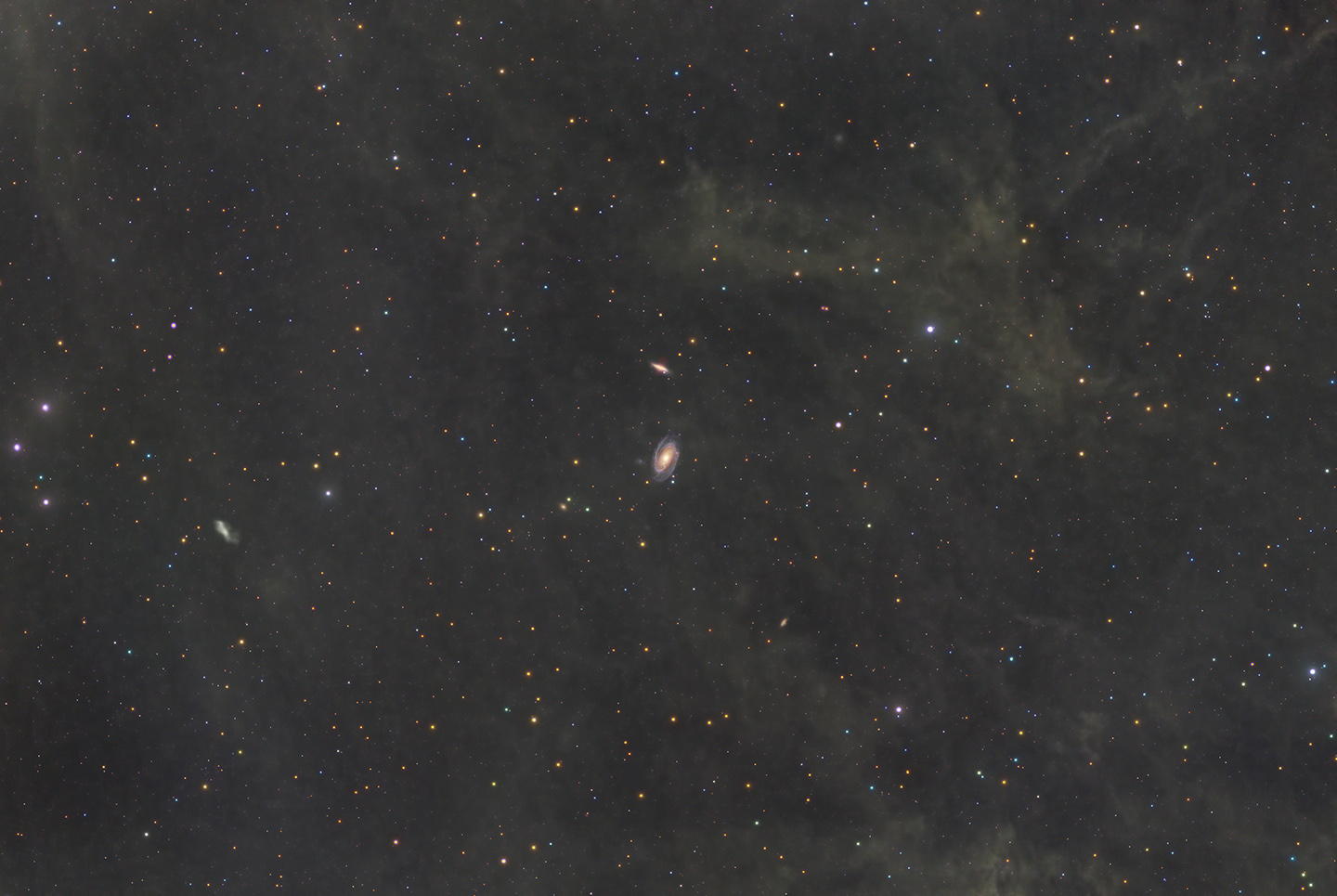 |
The Integrated Flux Nebula
|
|
13th March 2023Central Orion - the Belt to M42 |
Quite a difficult area for me as it low over Norwich. Siril managed reasonably well to remove the light pollution.This area has to be shot with at some broadband data as the flame nebula's colour is yellowish, which narrowband filters do not record. One peculiarity with the Canon 250D was with this being a vertical shot then live view decided to show the image upside down which was a puzzle at first. Virtually the whole region is covered in nebula. It is wall to wall with no black sky! The main contenders are from north to south: the Flame Nebula, the Horsehead Nebula, the Running Man Nebula and the Great Orion Nebula. That's not counting M78 on the top edge and part of Barnard's Loop in the very top left corner.
|
|
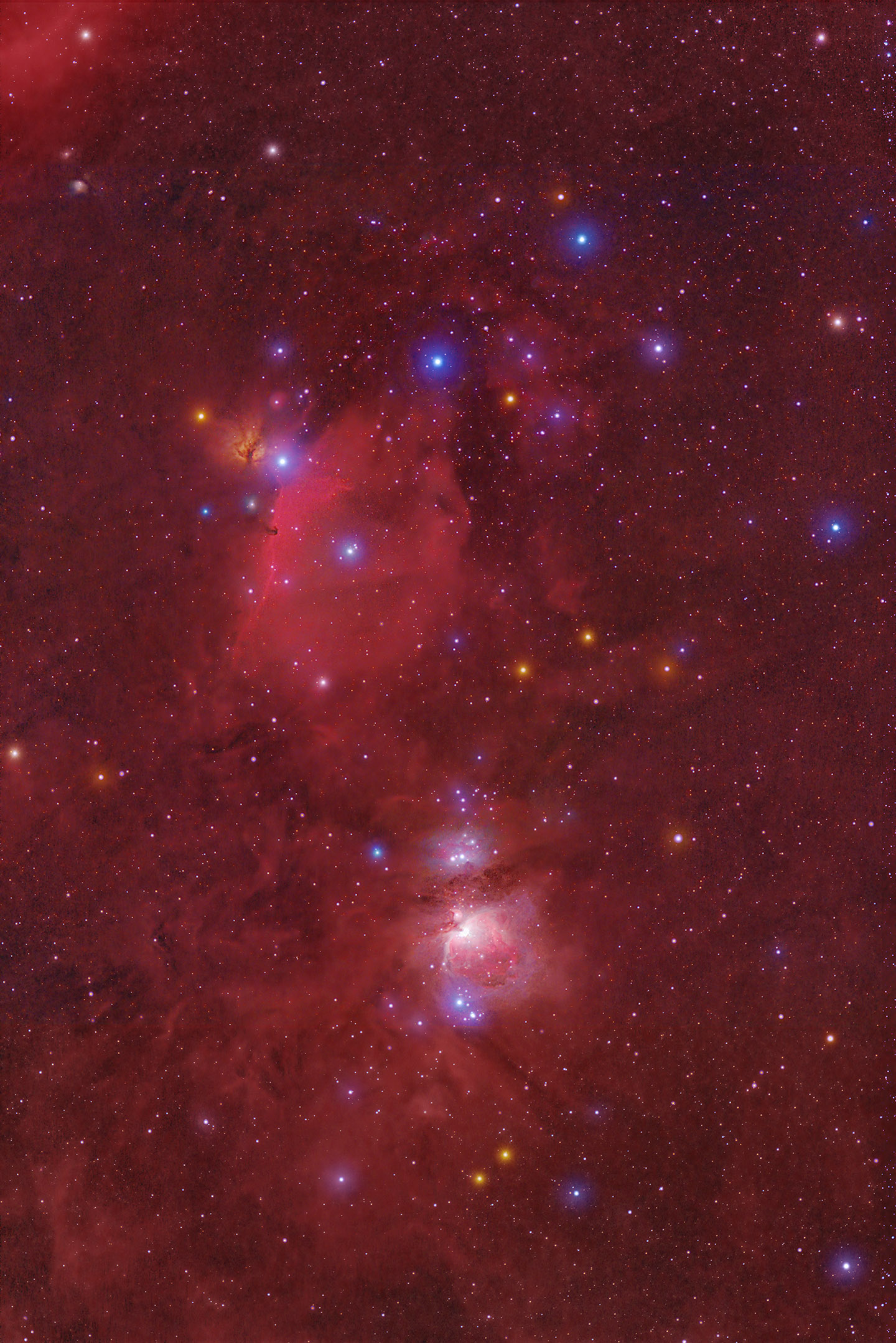 |
Central Orion
|
|
13th March 2023The Christmas Tree Cluster, the Cone Nebula & the Rosette Nebula Mosaic |
Monoceros might be one the most inconspicuous of constellations but it has some cracking deep-sky objects. In the top half of the image is Sh2-273, the Mon OB1 molecular cloud. At its centre is the open cluster NGC2264 , commonly called the Chritmas Tree Cluster. Its brightest star, the binary S Mon, is one of the primary ionising stars of the nebula although several others are now known. Below it is the dark nebula commonly called the Cone Nebula, actually a pillar of gas and dust containing an infrared source. The blue reflection nebulae are VdB 77-82. In the botton half of the image is Sh2-275 containing the famous Rosette Nebula, all part of Mon OB2, which is believed to be twice as far away as Mon OB1. At the centre of the Rosette is the open cluster NGC2244, which ionises the nebula and its fierce stellar winds has created the cavity at its centre.
|
|
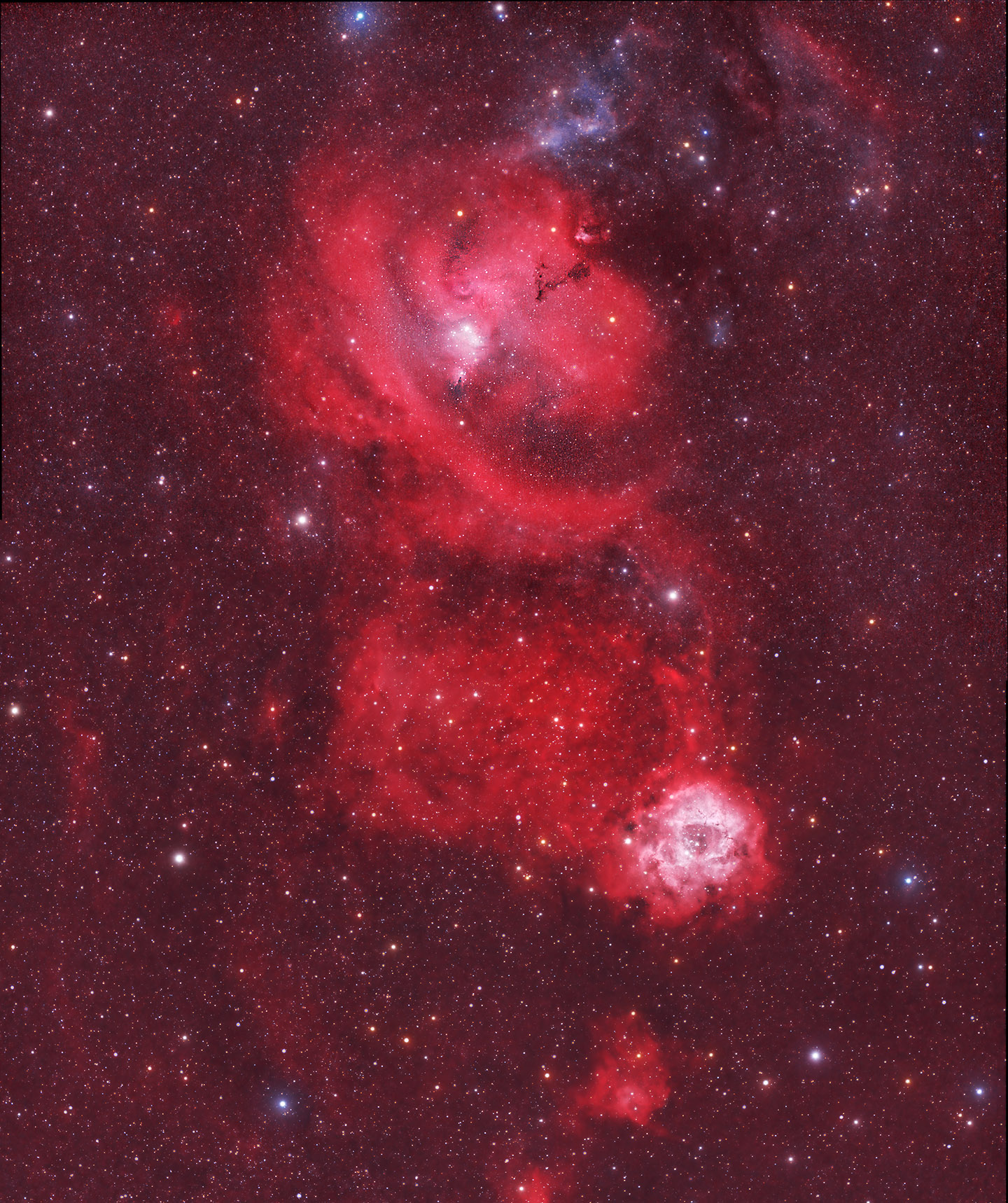 |
Cone and Rosette nebulae.
|
|
5th March 2023The Jellyfish Nebula, IC443 (Sh2-248) |
The Jellyfish Nebula is located at the centre of this image just to the left (east) of the bright star Eta Geminorum. Believed to be a supernova remnant but because of its proximity to and interaction with dense molecular clouds it is a very complex object. So much so thats its age i.e. when the supernova explosion occurred, is only vaguely known as between 3,000 and 30,000 years ago. The likely remnant pulsar star is the neutron star CXOU J061705.3+222127. The bright nebula bolow the Jellyfish is NGC2175 commonly known as the Monkey Head Nebula. M35 is also in this image, directly above the Monkey Head Nebula towards the top.
|
|
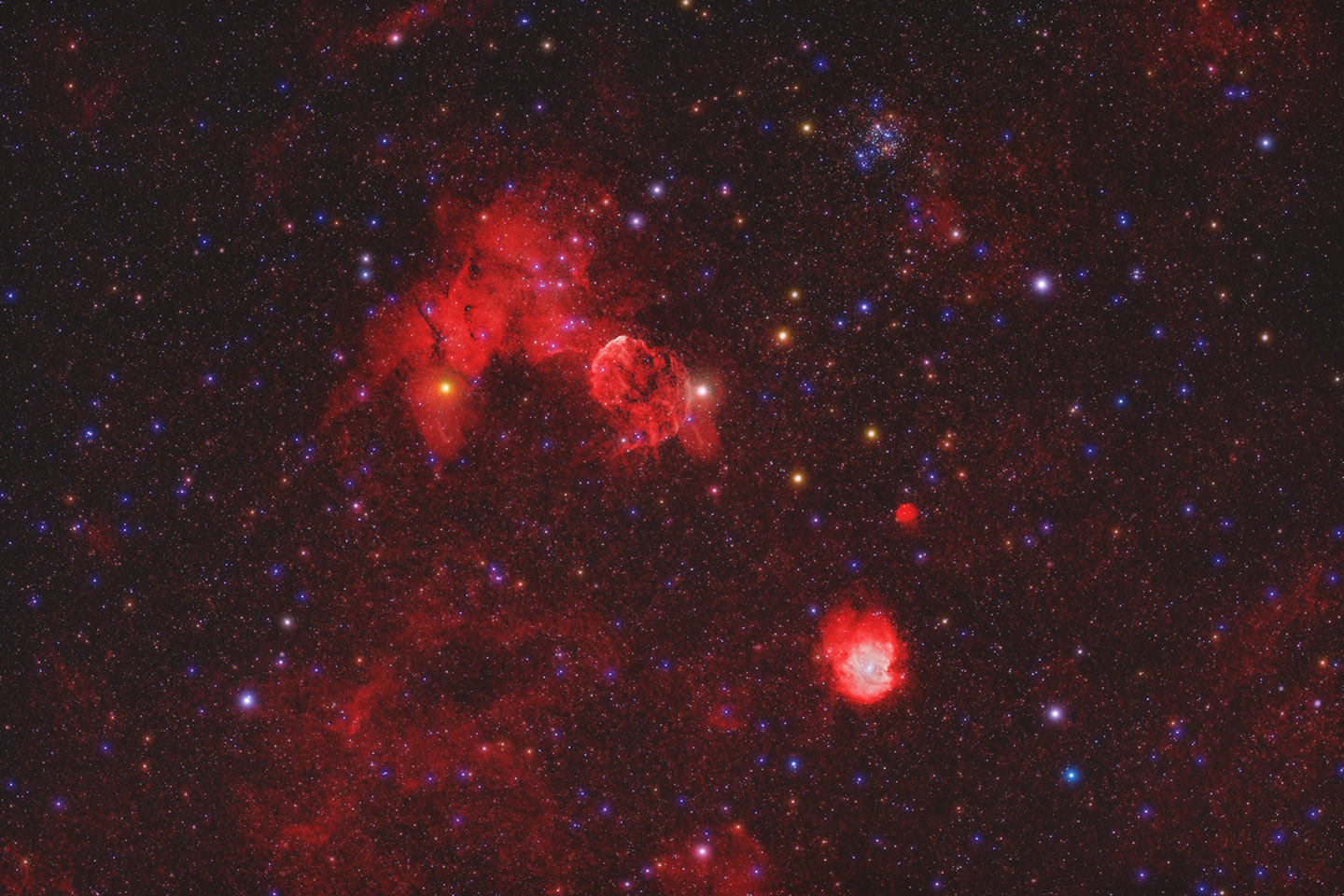 |
Jellyfish Nebula
|
|
19th February 2023The Flaming Star Nebula,IC405 (Sh2-229) |
This nebula is a combination of an emission (red) and reflection (blue) nebula energised by the irregular variable star AE Aurigae. This star is a runaway star most likely ejected during an interaction of two binary star groups. This event probably also ejected, in the opposite direction, Mu Columbae. The star 53 Arietis and Iota Orionis may also have been involved. This event has been traced to the Trapezium cluster in the Orion Nebula around two million years ago. So AE Auriga was not formed within the the Flaming Star Nebula but is just passing through it at high speed. Also in the image is the Emission Nebula NGC1893 (with the Tadpoles) and the Open clusters M38 and M36.
|
|
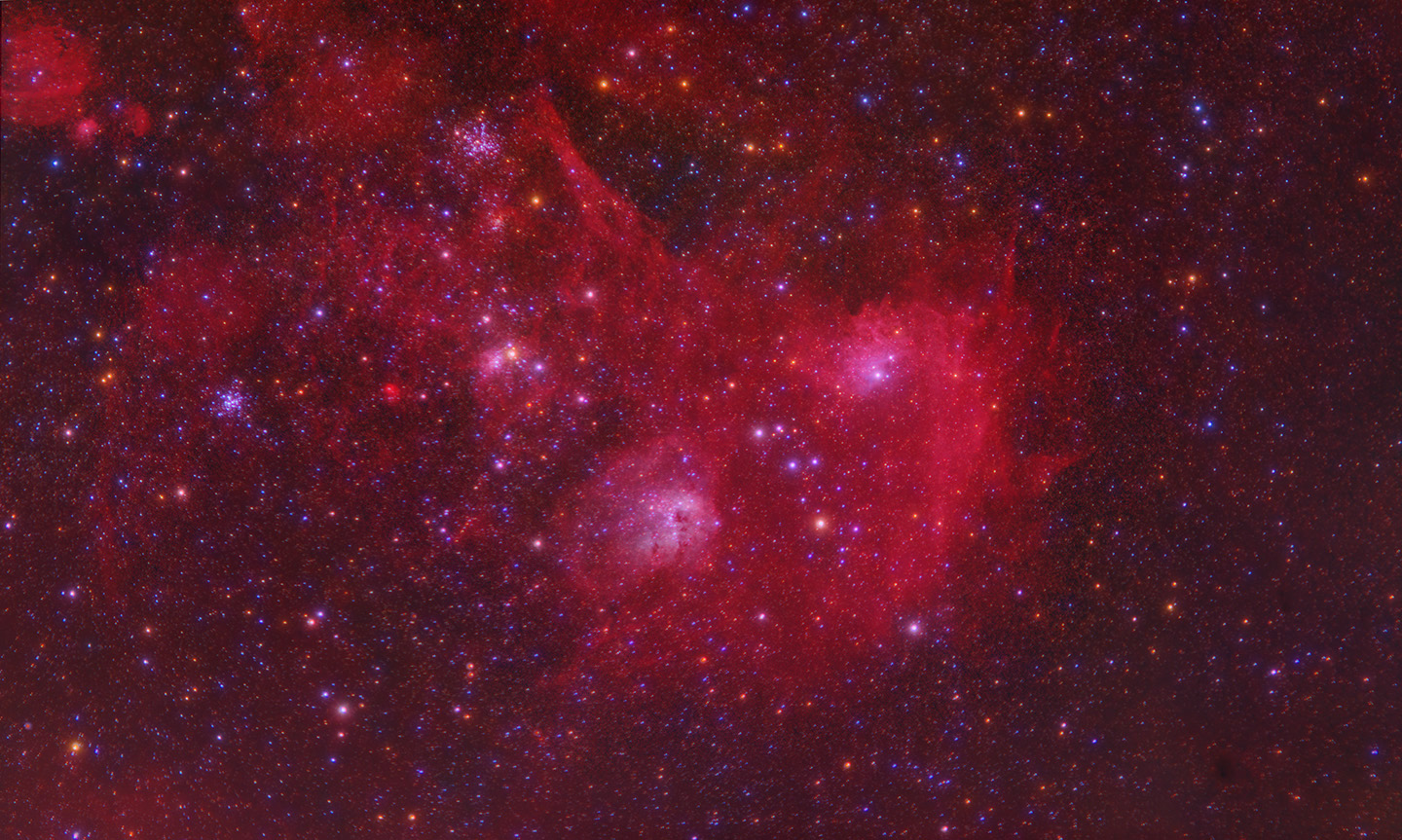 |
Flaming Star Nebula
|
|
10th February 2023Twin Comets, ZTF C/2022 E3 & Atlas C/2022 U2 |
The "Green Comet" ZTF E3 was fading now but on the 6th February is was to pass very close to Comet Atlas U2 just to the south of Capella. Same exposures as last time but no gas tail on ZTK was visible but just to its west (right) was the very much fainter Atlas comet. This was around 11th to 12th magnitude so pretty faint for a simple 135mm lens but it was clearly evident. This comet has 936.5 year period.
|
|
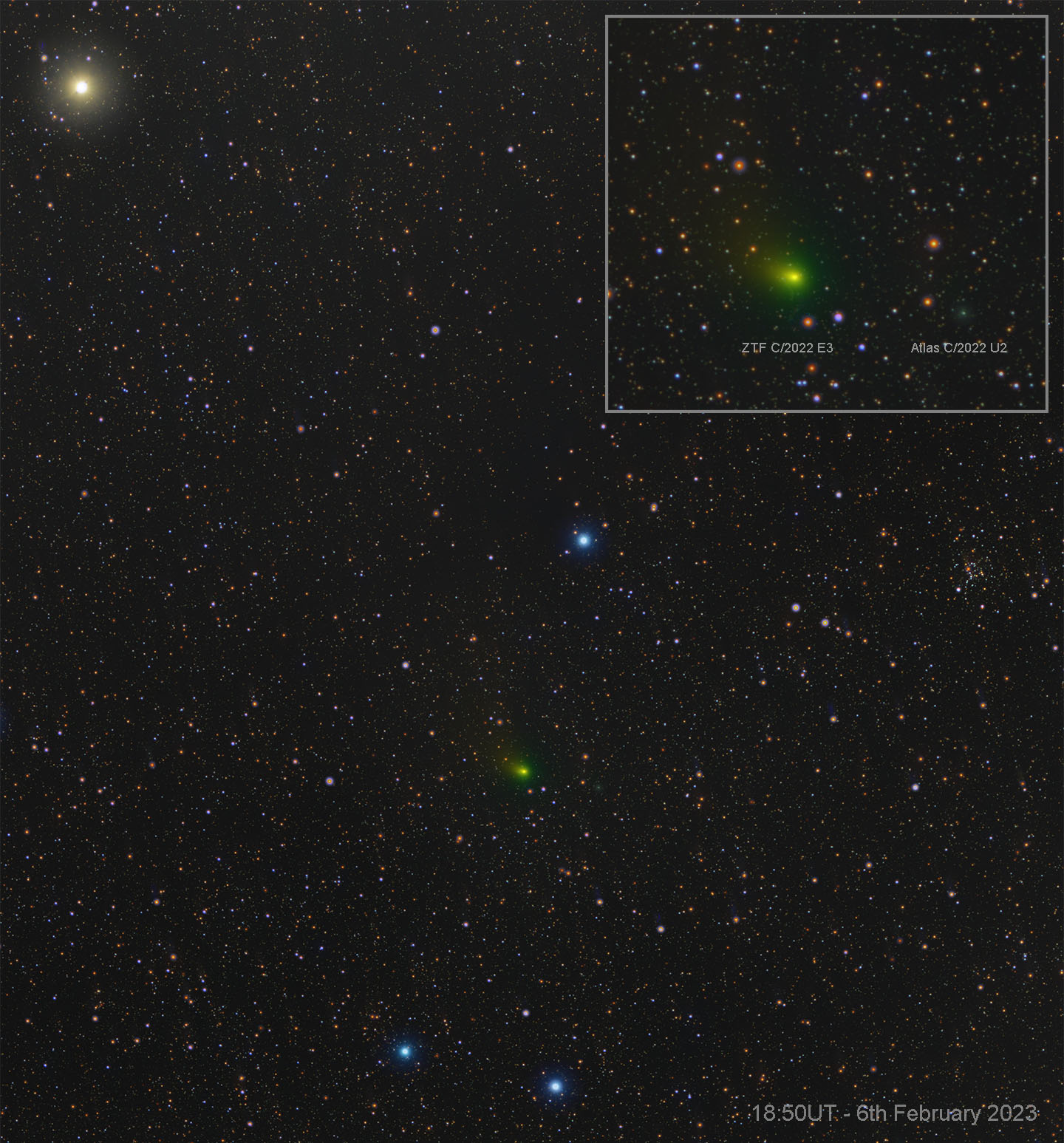 |
Twin Comets and Capella
|
|
1st February 2023The Green Comet, ZTF C/2022 E3 |
It was a frustrating week with continuous cloud cover as the comet rose higher in the northern sky. At last on the 30th January it was clear and although there was a dazzling Moon almost at the zenith I was able to get a run of images. With the strong moonlight then 15 seconds was about the limit. Comet E3 is a long period comet from the Oort cloud with an orbital period of around 50,000 years. A long time to wait if you missed it this time! Commonly called the Green Comet, which is due to the effect of sunlight on its molecules, especially carbon and cyanogen. The comet reached its perihelion (closest to the Sun) on 12th January 2023, at a distance of 103 million miles so outside the Earth's orbit. Its closest approach to Earth was on 1 February 2023 at a distance of 26 million miles.
|
|
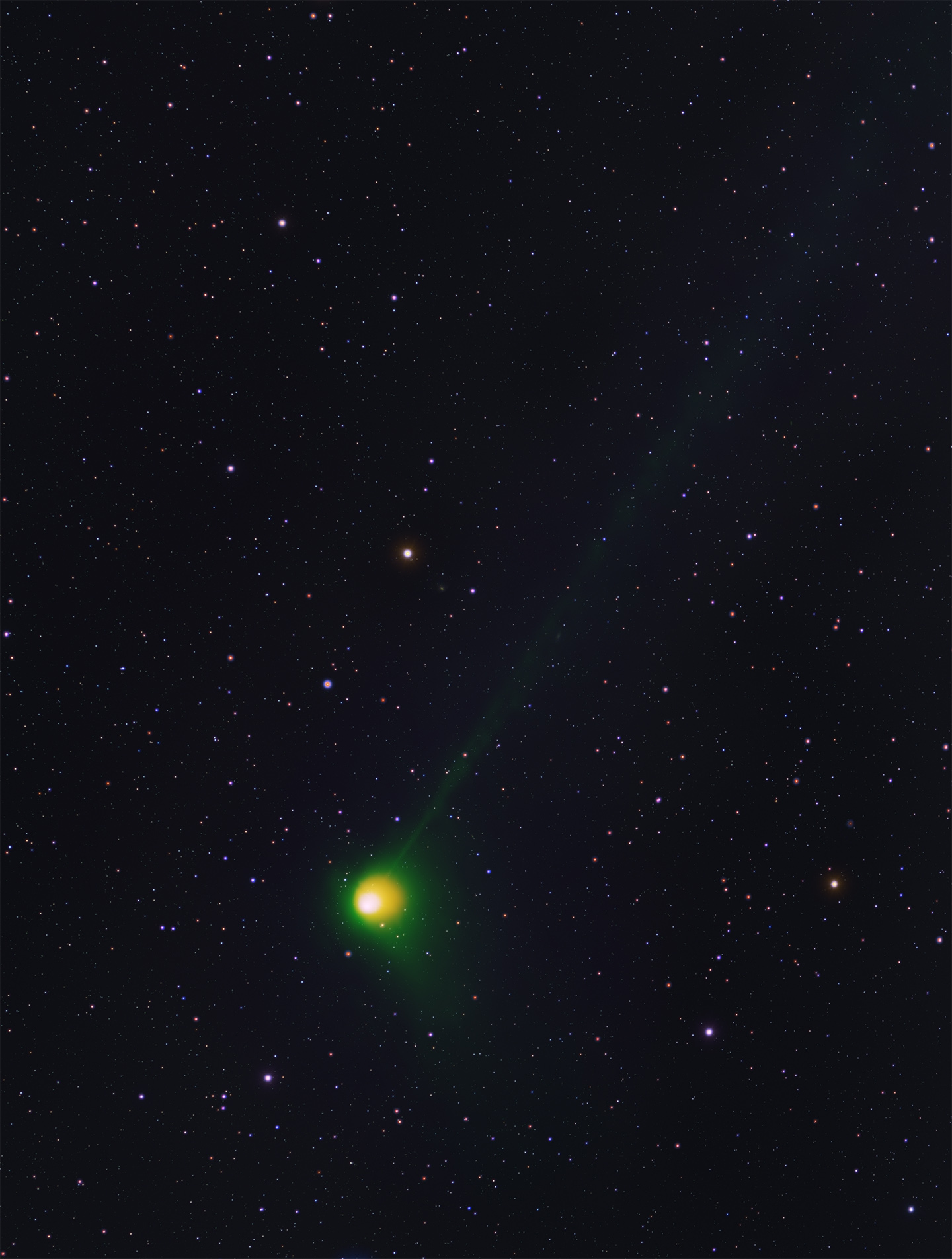 |
The Green Comet
|
|
22nd January 2023The California Nebula, NGC1499 |
The California Nebula in Perseus is just the brightest part of the giant California Molecular Cloud. However, its brightness is nothing to do with the molecular cloud as it is ionised by the runaway O star, Menkib, which is not associated with the cloud i.e. it is just coincidently passing through. The nebula gets its name from its brightest part being similar in shape to California. The California Molecular Cloud is about the same mass as the Orion A molecular cloud and is one of the most massive molecular clouds within 2000 light years of the Sun. However, despite its large mass, it has a much lower star forming rate than Orion A so it is very much a sleeping giant. (Ref Lada et al. 2007 & 2017). Right is an IRIS 3-colour image of the California Molecular Cloud (Lada et al. 2007). The brightest spot to the right is the California Nebula which lends it name to the cloud. The other bright spot to the bottom left in NGC1579 and the yellow crosses denote young stellar objects.
|
|
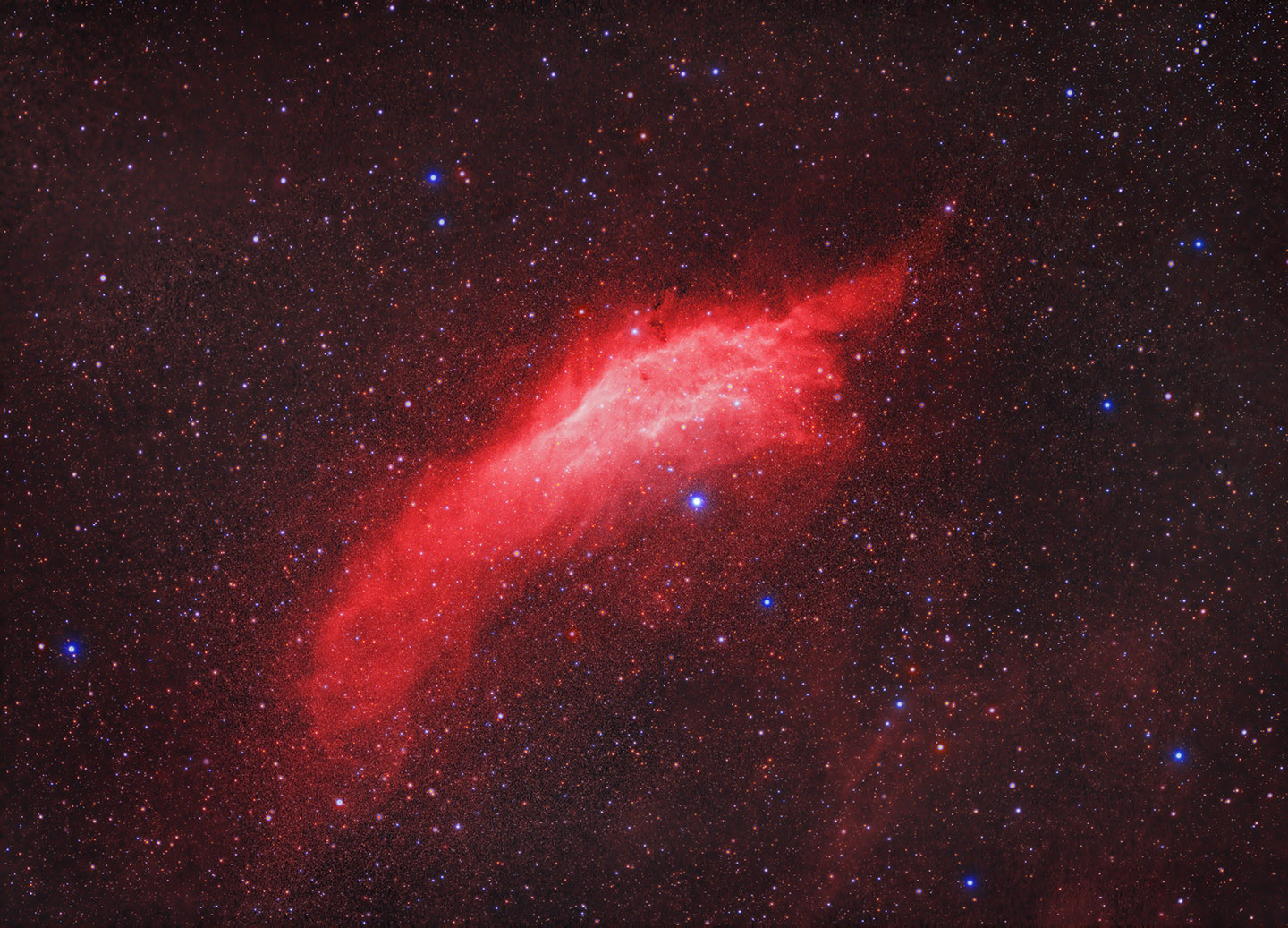 |
California Nebula
|
|
15th January 2023The Heart & Soul Nebulae (IC1805 and IC1848) |
This pair of bright emission nebulae are located in the Perseus arm of the Milky Way. Strickly speaking their catalogue numbers refer to the open star clusters within them. They were catalogued well before the extensive nebulae around them were known but today their IC numbers are generally taken to be the nebulae. In the case of the Soul Nebula (left) in film astrophotography days this was known as the Foetus nebula which probably is a better description than the Soul. Within the Heart Nebula but very small and insignificant in the main wide field image below is what I call the Dragon's Head (right). This was shot with my RCOS 12.5 inch telescope with a focal length of 2850mm - somewhat longer than the 135mm Samyang lens!
|
|
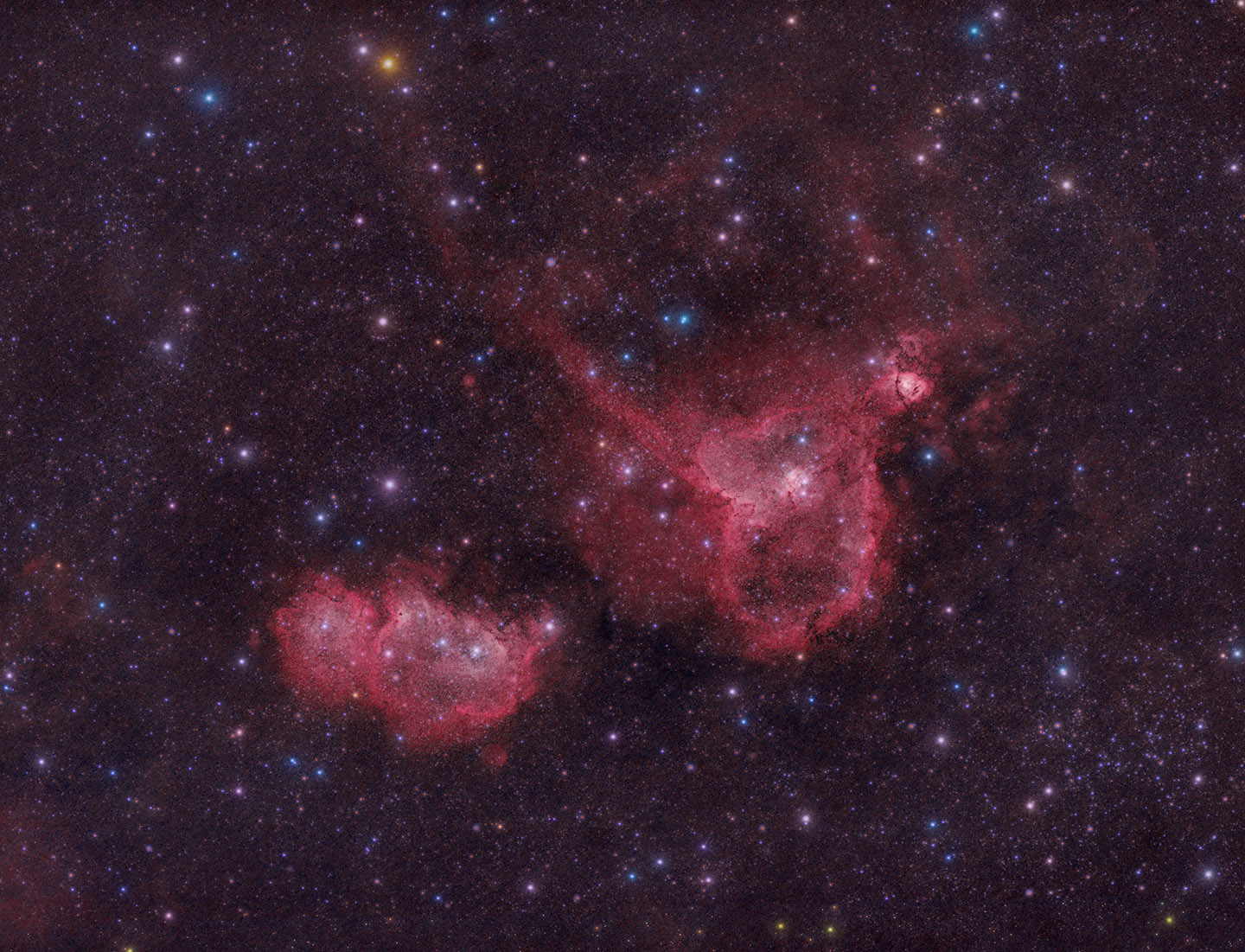 |
The Heart & Soul Nebula
|
|
1st January 2023The Double Cluster in Perseus |
When using the dual narrowband filter (OIII and H-alpha) the star colours are very poor. So I spent most of this night night shooting a few objects without filter (i.e. broadband). These could be then used with deep narrowband images later. However, in the case of the Double Cluster the broadband images were more than enough on their own. Originally referred to as h Persei and χ (chi) Persei, the Double Cluster consists of the twin open clusters NGC 869 and NGC 884. Patrick Moore also included the pair as No. 14 in his Caldwell catalogue. Away from light pollution they are easily visible to the naked eye. For many years there waa a debate as to whether they were asscoiated or a chance alignment. The answer was really pretty obvious - they are associated. They have the same very young age (14 million years) and are both are approaching us at the same speed. Togther they have a large mass equivalent to 20,000 Suns.
|
|
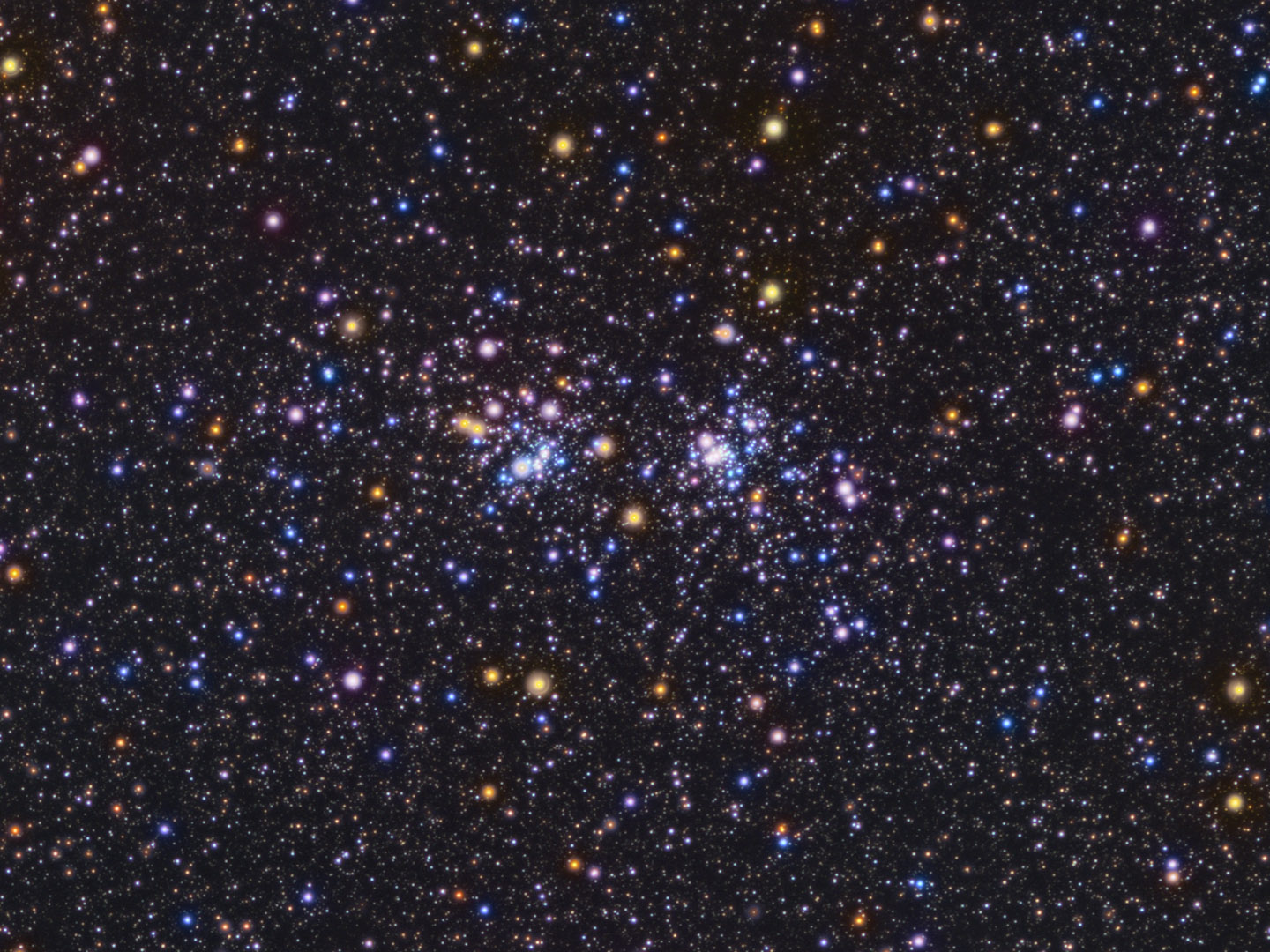 |
Veil Nebula
|
|
The imageBLOG continues at Archive 2022 Click Here
|
Please remember these images are copyright David Ratledge. Contact me before any use is made of them.
